2008-2010 Newsletter Archive
Third Dan Awarded to Sensei Ouellette and Sensei Prasso
Congratulations to Sensei Ashley Ouellette (pictured below) and Sensei A.J. Prasso who were awarded their Third Degree Black Belts by Shihan Mason.
Picnic a Pleasure
The annual Karate School Picnic, held on Sunday November14th, was a big success. A steady stream of visitors appeared throughout the day as instructors, students, parents and their friends made the time to stop by and offer edible treats. The kids played games while the grown ups chatted and the picnickers imbibed food and beverages on a splendid, sunny South Florida day at the park.
A white soccer ball was left behind while a red/yellow soccer ball is missing. See the Front Desk for info.
Sensei Phillip Balzano Graduates University
We recently heard from the family of Sensei Phillip Balzano. He graduated from Villanova University this past May with a Bachelor of Science. He is currently working on his PhD in Biology.
“We make a living
by what we get.
We make a life
by what we give.”
Winston Churchill
Breathing and Centering in the Martial Arts
Inhale, exhale, in and out, over and over again, every moment of every day of your life. Breathing is one of the most natural function of our bodies, and one that we often take for granted. In spite of its importance, many people develop shallow and uneven breathing habits that can effect their life and their health, often in ways they have never even considered. Effective breathing can make a measurable difference in the development of martial arts skills, and the breathing habits learned in the Dojo can be extremely useful, invigorating many aspects of our life outside of the training environment.
When you inhale, or breathe in, the air you take in goes through a multi-step filtering process before reaching your lungs. Specialized lung structures extract oxygen and transfer it into your bloodstream, where it travels to various oxygen-hungry tissues, including the brain and the large muscles. This cycle occurs tens of thousands of times each day, unnoticed, until you really push yourself in martial arts class and discover how much work breathing can be. With additional exertion, the process picks up speed trying to accommodate the body’s increased demand for oxygen. The heart pumps faster, attempting to meet the demands of muscles engaged in high activity for oxygenated blood and the removal of waste carbon dioxide.
In class you will be trained to exhale strongly with every punch, kick and block that you execute. The inhalation will happen naturally between these exhalations. When we breathe out strongly we stimulate the parasympathetic nervous system. As a consequence your blood pressure will go down and your heartbeat will slow, despite the exertion of the exercise. As you exhale strongly with each move you should also tense your abdominal muscles to center yourself and strengthen your strikes and blocks. We are most vulnerable to a counter attack when we are executing our own technique, and tensing our abs as we exhale provides the strength we need to bounce off from a counter that might otherwise wind us. This training also helps to reverse the “startle reflex” that most people develop by breathing incorrectly. If you are startled and your reflex is to inhale and freeze, rather than exhale and center yourself, your self defense ability will be compromised.
Regular deep breathing can train the body to allow the development of improved oxygen uptake. When you exhale strongly you create space for fresh air to be drawn deeply into the lungs. This leads to greater stamina and strength as well as improved mental focus, all of which are hallmarks of excellence in the martial arts. A full appreciation of the “life force” can be acquired by paying attention to the breath. Life is after all, just a breath away.
© 2010 Shihan Robert H. Mason
Be Still and Know
As much as the movements involved in karate training are difficult at first, being still and not moving is sometimes much harder. When students line up to bow in at the beginning and end of class the command in Japanese is kiyotsuke, which is the military equivalent in English of “ATTENTION”. What this command requires is that students should stand up straight with their heels touching and their hands by their sides. Blinking and breathing should be the only movements discernable. While this exercise is very difficult, it is important that students should do their best to practice. Sitting in seiza (kneeling) also affords a similar opportunity to practice stillness.
In music there are rests between notes and pauses between movements. In karate practice there are points of essential stillness within certain combinations and between techniques, that create the dynamic balance essential to the rhythm and timing involved. This is especially evident in kata practice, where a good rule of thumb is to pause for one second at the end of each combination, and for two seconds at each kiai. The more absolute the stillness at these times, the more effectively it sets off both the movements that preceded it, and those which come afterwards. Effectively, the message is, that in order to understand and benefit fully from movement, you must understand and comprehend the benefit of stillness.
In our everyday lives it is not just what we do that defines something of who we are. It is also a matter of what we do not do. Our search for self knowledge may be assisted by an awareness of how we do all of the activities that we are involved in on a day-to-day basis. The general rule we can observe is that “how we do one thing, is how we do everything”. This is the yoga of everyday life: a practice of being at one with ourselves in action. We can also benefit from investigating how we are when we do nothing: when there is no activity. How well can we be still and conscious and awake at the same time.
This can often be a very challenging exercise. We are becoming so used to continuous stimulation, from phones, computers, TV and other distracting influences, that we have perhaps had little or no practice at the experience of stillness. It is hard to perceive value in a process we associate with boredom or an absence of “something to do”.
Certainly in terms of a student’s progress in the Martial Arts, I measure them not only by their competence in action, but also by their competence at attaining and maintaining a state of stillness. I’m reminded of the motto of the University of Sussex in England, where I read (studied) psychology. “Be still and know”. There is something in that if you can practice it.
© 2010 Shihan Robert H. Mason
Martial Arts: A Course in Courtesy and Respect
Martial Arts is many things to many people however, throughout all cultures the development of courtesy and respect among members of the military and martial community has always been of high importance. Courtesy in every class at the Dojo is symbolized by the bow we perform on entering and leaving the Dojo, the bow at the beginning and end of class and the bow we make to our partner before we engage in prearranged sparring or free sparring. Showing respect in this way; however, only has meaning if we utilize the motion as a trigger to inspire what we could call the “courtesy mindset”. This is the mindset that balances our aggression with self-control and our intensity with our awareness. Without these appropriate restraints students would only be trained in combat techniques, and these could just as easily be used for street fighting or bullying. I am not interested in training someone who enjoys finding potential conflicts and diving in with both feet so as to demonstrate their prowess as a thug.
I recently caught an episode of a show on MTV2 called “bully beatdown”. The concept is that men who are being bullied call up and complain to the MMA host who then meets their bullies. Arrangements are made for the bully to be matched in the ring with a professional Martial Artist who will fight them within a strict rules framework and give them a chance to experience some of their own medicine. The consequence of the matches I saw was that, following being submitted and knocked down in the ring, the bullies had more understanding of the experience of their victims, and seemed prepared to cease their bullying behavior and be respectful of them. Fighters in all Martial Sports often embrace at the end of a match as a sign of mutual respect that develops out of striving earnestly to win against a strong adversary.
Respect is having regard for the rights of others, refraining from interfering with others, and also adhering to the traditions of a particular environment so as to support the order necessary to have a civil society. While respect and courtesy are essential to the development of civilization, that does not mean that some people will not try to get by without them. Over time Martial Arts training develops a high level of competence to handle aggressive or violent situations; thus, the confidence of the Martial Artist develops very strongly. This confidence allows Martial Artists to experience an advanced and ordered state of development in which it becomes natural for them to be polite, considerate, courteous, and thoughtful of others.
© Shihan Robert H. Mason 2010
A British Chef Visits America on a Quest
Jamie Oliver, British Chef well-known for introducing healthy food into the school menu in the United Kingdom, is on a quest here in the U.S. Having read government statistics that named Huntington, West Virginia as the most unhealthy city in America Oliver decided to launch a “food revolution”. The TV show has been airing on ABC and is called “The Food Revolution”. Previously Oliver had persuaded former British Prime Minister Tony Blair to subsidize a healthier food menu for British schools; now he is in America to help change our public school menus to better options, i.e. food cooked from scratch for each meal, rather than processed food substances, of questionable origin, reheated and passed off as food.
As you can imagine, all did not go smoothly for the enthusiastic Oliver, who opened Jamie’s Kitchen on the Huntington main street to teach free cooking classes as part of his effort to educate the community. Oliver was given the go ahead to introduce his own brand of cooking to a local elementary school, where he discovered that the “milk” offered at lunch was of the pink (strawberry flavored) and brown (chocolate flavored) varieties, meaning that they contained more added sugar than a soda. When Oliver questioned the food supervisor he was told that “It is more important that the children get their calcium than how much sugar is in the milk.” His response that...“We should give the kids what they should get, and what we think they should have; and if they don’t like it, they will get used to it” brings up an important issue for educators and parents. It is this: Once we have decided on a course of action, or a standard of behavior for our children, it is important that we follow through and “if they don’t like it they will get used to it”. This is not currently a common philosophy. Much of the time I hear stories from households where the children appear to be in charge rather than the parents. Now I’m not at all opposed to the idea of giving children the opportunity to accept age appropriate responsibility for their lives. In fact, I believe this should be encouraged; however, left to indulge themselves and do just what they like, and rarely be called upon to accept anything they dislike or are uncomfortable with, is an abdication of responsibility by an educator or a parent.
Many years ago, when my daughter was in pre-school, it was prohibited for parents to bring in any food that contained sugar as the teachers noticed its negative effect on the kid’s behavior. One of the blogs at the ABC website from a teacher, across the river from Huntington, West Virginia in Eastern Kentucky noted that: “As for the students? Well, there is no denying the plethora of behavior issues. I feel this is because of the carb overload and lack of activity. We have 30 minutes total for arriving at lunch, acquiring it; sitting; eating; and whatever time is left we get to walk for about 5-10 minutes IF we are lucky”. Schools need to schedule time for what is important, and that includes time for a nutritious lunch. Here at the Dojo we offer an appropriate amount of time each evening for our Junior students to train. Given the current school convention of limited time for PE and sports, I encourage parents of children aged six and older to bring them to class here often. We can help them the most when they are here often. Ask at the Front Desk about the upgrades available to allow more training as part of our 30th Anniversary promotion .
© 2010 Shihan Robert H. Mason
To be a Master of Yourself
“Everything that has been achieved is merely a preliminary exercise for the achievements to come, and no one, not even one who has reached perfection, can say he has reached the end.” This quote from Eugene Herrigel touches on an important theme for martial arts students. The experience of perfection, or completeness in martial arts, often only occurs after many years of practice and thousands of repetitious movements. Sometimes, however, it can be experienced by a complete beginner. Herrigel wrote “Zen in the Art of Archery,” and as a youngster I remember taking a girlfriend to practice archery with me. I showed her how to draw the bow and loose the arrow. Her first shot went straight to the center of the target, the gold. I was thrilled, as she was, at the experience of everything going “just right.” The moment was complete, perfect. Of course, this joy of the novice at a flash of perfection, while wonderful, does not mean that mastery has been achieved. Mastery requires consistent high level performance over time.
Repetition often leads students to feel bored. Getting just as excited about a punch or kick on the twentieth repetition, as you were on the first attempt is often difficult. Repeating the move for the five hundredth time can become a rote performance, containing little of the zest, intensity and quality necessary to achieve perfection. Yet, only after many thousands of such excellent repetitions can the move become so smooth, relaxed, reflexive and energized that it feels perfect.
Within the Mu-do-kai curriculum, I have done my best to disguise the repetitions. I have placed the fundamental exercises into different contexts at each belt level, in order that the students can see them with fresh eyes. I understand that new gold belts usually think that when they can roughly get through Pinan Nidan, that they “know” the Kata. These students find it incomprehensible that a Black Belt student, like top rated World Tour competitor Sensei Laraine Winston, may be performing the same Kata now as she was when she won her first Trophy at a Shiaii three years ago. What is more, she is getting the most out of the Kata now, and performing at the highest level. For Black Belts, this is the way to mastery, not just of karate, but of themselves.
Remember, knowledge is the result of combining the correct information, with correct practice, over time. Sometimes just a glimpse of perfection can be sufficient inspiration for us to pursue knowledge. It is through the acquisition of knowledge that we can learn to master ourselves.
© 2010 Shihan Robert H. Mason
New Junior Black Belt
Congratulations to Miss Brianna Houser who was awarded her Junior Black Belt by Shihan Mason on April 14th. Miss Houser completed her technical grading on April 11th, demonstrating all of the basic and combination techniques from all of the ranks, a wide variety of self defense skills, including defense against knife attacks and attacks with a club. She also demonstrated eight form routines (Kata). For the sparring aspect of her grading Miss Houser sparred with ten successive opponents.
“Rise and Rise again
until lambs become lions.”
Robin Hood
Rule #1
from the MuDoKai Curriculum
The student should strive to concentrate only on the martial arts when in the Dojo and to leave behind any problems, animosities, etc which could be counterproductive. If any problem in doing this arises, a confidential consultation with the Sensei is urged.
Simple Dojo Rules:
1. Do everything the Sensei tells you to do, the best that you can.
2. Don’t do anything the Sensei did not tell you to do.
A Time for Reflection
Many of you are aware that, in my capacity as World Commissioner of the ISKA, I attended the recent Strikeforce Miami event and awarded title belts to two World MMA Champions. After the matches a few of my associates were talking about the match in Miami that first got the Florida State Athletic Commission involved in regulating Martial Sports in Florida. The match in question was an exhibition between the boxer Thomas “Hitman” Hearns and Bill “Superfoot” Wallace. I refereed that fight, along with another that night between James Warring and Don “the Dragon” Wilson. As we chatted further I was reminded of a match in I refereed in West Palm, when Don Wilson fought a kickboxing match against an up and coming kickboxer from the Ukraine named Vitali Klitschko. Wilson won the match but Klitschko went on to become the ISKA World Super Heavyweight Champion. After the event I drove the Russian and Ukrainian team up to Orlando to visit Disney World. Vitali had brought himself a new pair of Nike sneakers with his purse money from the fight, but walked around Disney in his socks, sneakers hanging around his neck, so as not to wear them out. Apparently, getting sneakers his size had been impossible in the old USSR. Both Vitali (WBC) and his brother Wladimir (IBF,WBO,IBO) went on to hold four of the major Heavyweight World Titles in boxing. Both brothers have PhDs and speak several languages. Two very smart fighters.
On another note, we have now been in our current location for almost seven years, following over twenty years at our former space next to Toys R Us, opposite the Broward Mall. Despite setbacks from damage suffered by our neighbors during hurricane Wilma, this is a great spot for a Dojo. Having two training rooms and many helpful Black Belt students allows us to offer classes every day with an excellent teacher-student ratio and expert supervision. All of the Sensei who teach classes are graduates of our Sempai leadership program, and have assisted in over 100 classes prior to beginning their Instructor Training Program. Even as certified MuDoKai Instructors they still receive ongoing training and supervision so that their skills as Sensei continue to develop.
© Shihan Robert H. Mason 2010
Rock-Solid Workout Tips:
Working those Abs
Keeping Steady
If you’ve ever been on a roller coaster, you know that going over top of a crest will cause your stomach muscles to automatically tense up. That’s because whenever the ground beneath us is unstable, the stomach muscles reflexively tighten to stabilize the body.
Body stability is an essential aspect of Martial Arts training. If you’re off balance, there are fewer choices available to you. As your stance weakens, your vulnerability increases. Strong abdominal muscles allow for better balance and quicker responses. A firm mid-section gives you the versatility to react to your opponent’s every move.
It’s not as hard as you think!
Developing strong stomach muscles takes effort, but it doesn’t have to be grueling every step of the way. One of the easiest methods for developing good abdominal muscles is to pay attention to your breathing. Notice the way that your waistline moves as you inhale and exhale. Make sure that you are breathing abdominally, so that your stomach seems to fill up with each inhalation. Be sure to exhale strongly and tense your stomach with every punch, kick and block during all of your Martial Arts lessons. Firm your stomach and take care to maintain smooth control of each breath. You will soon notice that by simply paying attention your stomach will grow stronger.
Training Tips
Here are just a couple of basic exercises for developing rock-solid abdominals:
1. Leg raises. Lie on your back, keep your knees slightly bent, and raise your heels about 18 inches off the ground. Be sure to keep your back flat on the floor. Hold the position for as long as you can, and then lower your legs slowly to the ground.
2. Leg thrusts. Lie on your back and lift your legs to about a 90 degree angle off the floor. Keeping your hands at your side and your back flat against the ground, push your pelvis and legs straight up a couple of inches, and slowly lower yourself back to the ground. Repeat
These are just two of many exercises that develop the abdominal muscles. Ask your Sensei for more tips on how to handle this part of your exercise program.
The abdomen is at the center
Paying attention to the stomach muscles leads to good muscle “tone.” Tone refers to the subtle but constant tension that lends support to surrounding joins and keeps the body in a ready state at all times. Remember that the stomach is at the center of your body: the power for your moves radiates from that point. Strong arms and legs are only as effective as the central zone of strength that supports them. Remember that every minute you spend developing your abs will make you a stronger martial artist. Put some abdominal exercise in your training – and keep up the good work!
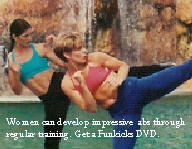
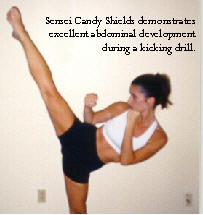
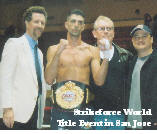
Strikeforce Miami
If you missed the event at the Bank Atlantic Center on January 1st it could not have been because you didn’t know about it. Strikeforce promoter Scott Coker had his team working on the show well in advance with regular press releases and updates since before the holidays in December. Everything from the weigh-in on Friday night to the end of the last match on Saturday went very smoothly, including the live telecast on Showtime. The match between Jay Heiron and Joe Riggs was supposed to be live on the internet at EASportsMMA.com. That didn’t happen, apparently because of massive traffic and server problems, but everything else ran like clockwork. I have been working with Strikeforce promoter Scott Coker for over 20 years. It was good to see him and support his show. Details at iska.com.
“It is the constant and determined effort
that breaks down all resistance,
sweeps away all obstacles.”
Claude M. Bristol
“The desire to win is born in most of us. The will to win is a matter of training. The manner of winning is a matter of honor.”
Dennis Thatcher
Karate at any Age
One day, some time ago, Pennsylvania freelance writer Marlene DeMarco made a life-altering shift in her priorities. She decided to train in karate. Ms. DeMarco detailed her sometimes perilous, but ultimately fulfilling, adventures as a “no belt” karate student in an issue of Newsweek Magazine.
On a mild winter day, Ms. DeMarcho was outdoors cleaning her garage when a neighbor stopped to chat. The neighbor mentioned that her 10-year-old son was enrolled in a karate class. “I casually remarked [that karate] was something I’d like to try - some day,” wrote Ms. DeMarco wryly. Before she knew it, her neighbor had provided a Dojo newsletter and class schedule and was gently prompting her to give the Martial Arts school a call.
Despite her misgivings, Ms. DeMarco made contact with the school. She began by telling the representative all the reasons that she wouldn’t be a good choice for a pupil: “I’m interested in taking karate, but I’m 51, overweight, and completely out of shape. I know your current session started several weeks ago, so when does the next session begin? Next fall?”
The ploy failed, however; not only was the Sensei at the academy very responsive to taking her on as a student, but he said that she could start right away in the beginner class. She was officially enrolled!
During her first class, Ms. DeMarco found herself surrounded by classmates, some of them also in their fifties, and others many years her junior. She doggedly joined them in their routine of basic drills and skills to improve her balance, fitness, agility, flexibility and focus.
Despite the age range, Ms. DeMarco found that the students in the class accepted her as a peer and included her in all aspects of the training. Now she was really in for the long haul; having been accepted by her new friends.
Her determination turned to trepidation as the date for her first belt test approached. Although she tried to talk herself out of taking it, outside factors kept encouraging her participation. It wasn’t easy, however; she was unable to sleep the night before the test and moments before class, she ripped the pants of her freshly pressed gi while warming up with a few of her classmates. The tone was set; despite their reassurances, the test was challenging. Her anxiety was put into perspective, however, when a sympathetic classmate offered a theory: “I know why you messed up on the kicks. You were thinking about the rip in your pants [rather than the kick] ‘cause you know that kick.” Her efforts in class had made her part of a proud and protective team.
Ms. DeMarco’s story ended with this reflection on her experience: “I had just learned much more than karate in those four months...just maybe, age isn’t as limiting as I thought, because I did earn my white belt and now I’m working toward the yellow.”
As you begin 2010, no matter what belt rank you are, UKC wishes you the best as you strive for Black Belt Excellence in everything you do. Have a great year!
Shihan Robert H. Mason © 2010
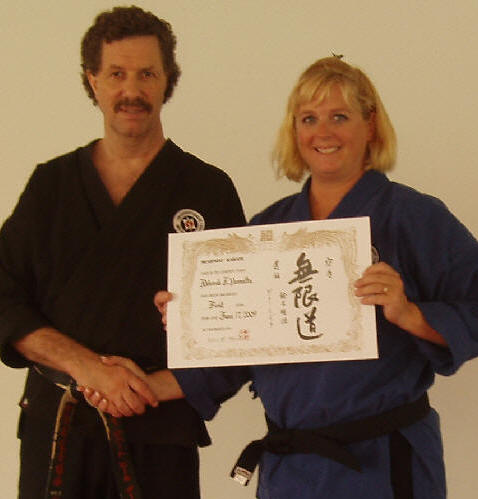
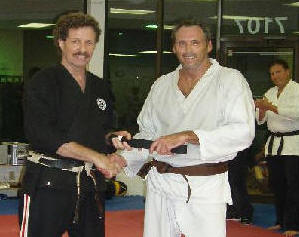
Sensei Deborah Vannatta began her training to maintain her fitness and keep her ahead of her three sons.
Dr Jack Kaelber trains in MuDoKai to relieve stress, and stay in shape.
Why is exercise so unpleasant
how can one overcome this to acquire healthy habits?
One reason that it’s difficult for people to get into a habit of regular exercise is that it causes pain and other unpleasant experiences. The pain of exercise was actually adaptive for early humans. When the pain of hunger “outweighed” the pain of physical exertion, early humans would hunt for a meal. Once a meal was obtained, though, it was important that calories were not wasted by any exercise that was not necessary for survival. Additionally, any injury resulting from this unnecessary exertion posed a great risk before medical care was available. Pain helped humans survive because it discouraged such unnecessary physical exertion. Thus, a dislike of exercise is quite natural, and a universal human experience. Of course, in our modern times, food is quite plentiful and exercise is not required for attaining it. Our bodies, however, have not changed in this regard, and hunger and exercise both still cause pain.
This combination of circumstances contributes to the fact that many modern humans are overweight, unfit and (often in spite of sincere efforts) have not been able to develop a regular habit of exercise. This is reflected in the statistics. Most people (65%) who start a program of exercise drop out within the first 6 weeks and more (another 7%) have dropped out after 6 months. Those who reach the 6 month point (28%) are much more likely to continue, since at this point, exercise has become a habit.
So how can we overcome this natural tendency to avoid exercise and to make it past those critical 6 week and 6 month points?
There are a number of ways that we can influence our exercise behavior:
1) Start slow. Exercising at less than full intensity for the first few sessions can contribute to long term success. It reduces the level of discomfort you feel, giving your body time to adjust to it.
2) Until you experience the natural payoffs for exercise (usually 6 to 12 weeks after you start), arrange for other, more immediate, motivators.
3) Exercise with other people who are likely to encourage you and recognize your efforts.
4) Partner up with people who will hold you accountable for your plans, but in a positive way.
5) Choose exercise activities that are likely to hold your interest, or are stimulating in other ways (such as incorporating music that you like, or incorporating new skills and knowledge).
6) Take any comfort measures that you can, such as:
· Stay hydrated
· Practice steady, even breathing and avoid holding breath
· Wear comfortable clothes – especially shoes (if they are required for your activity)
7) Be patient. It takes time to experience the natural payoffs for exercise. Also, our bodies adapt to new sensations over time. You will experience less discomfort the longer you participate in your new exercise pursuit.
8) Reduce the “excuses” that you might be tempted to use to stay at home. For example, keep your workout bag in your car so you always have it and arrange your schedule so there will be few conflicts.
9) Reduce the stress of starting a new program by making positive self statements, such as:
· “Everyone else here started as a beginner, just like me”.
· “I can only compare myself to me, not to anyone else here”.
· “There are people who started this when they were even older than me”.
· “I should be proud of undertaking this, given my… (age, experience level, etc…)”.
· “People take breaks from training sometimes. What is important is that I am coming back now”.
· “It’s natural to be sore and have some discomfort. I’ll get used to it and then I’ll be healthier and feel better than ever”.
· “It’s going to take some time for me to see results, but just coming to class (gym, track, pool, etc…) is an accomplishment for me at this stage.”
10) Keep track of your progress using a calendar or a graph. Don’t be shy about sharing your progress with others so they can give you recognition and encouragement. You might even post your progress in a public place in your home or at work.
© 2010 Sensei Laraine Winston
Sempai Program
Shihan Mason has developed the Sempai Program (assistant instructor training) for Adults and Juniors over the last thirty years of his teaching and training in Plantation. The program is voluntary and open to students who are Black Belt Club members of at least Purple Belt rank. Students who are interested will need to fill out an application, signed by an Instructor other than Shihan Mason, who recommends the student to become a Sempai. Then an appointment will be made at the Front Desk for an interview with Shihan. The Sempai Program benefits students by allowing them to assist the Sensei who is teaching class, and thus review the curriculum material at the different belt levels. It also teaches leadership, responsibility and communication skills. This helps to prepare both the Sempai and the students in class for their eventual Black Belt test. Graduation from the Sempai Program is a prerequisite for Instructor Training after Black Belt is achieved.
“Persistence and a
positive attitude are
necessary ingredients
for any successful venture.”
L. Douglass Wilder
Private Lessons
Some students enjoy private lessons which may be one hour or half an hour long. Several of the Sensei are available to teach on a regular basis or for an occasional class. Ask at the Front Desk for details and fees.
DVDs for all ranks
Like a Private Lesson with Shihan Mason that you can practice with at home or on the road, each DVD includes all material for each belt level.
“Try to regard every problem that comes your way as opportunity rather than opposition.”
Russell J. Fornwall
Uniform appearance
A clean, unwrinkled uniform is important for the student of the martial arts. The lightweight“ student” uniforms that are initially presented as part of the Introductory program for beginners, are mostly wash and wear requiring very little maintenance (please do NOT wash the belt as stripes may fall off). The correct length of the pant leg is just ABOVE the ankle. Other uniform styles are available for the busy student who will probably want to have more than one uniform handy. “Logo” tops, v-neck (tuck in, pullover) and traditional (tie), can be combined with karate pants that are MIDDLE WEIGHT with an elastic waist. Heavyweight Gi’s can also be ordered.
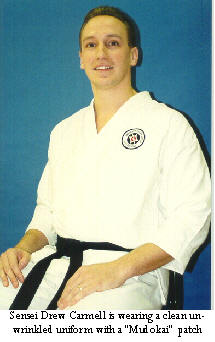
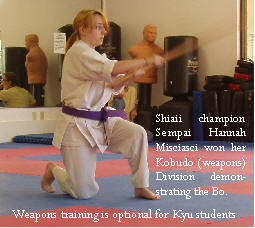
Taking the right class
In order to teach students what they need to learn for their belt level it is suggested that color belts, yellow and up, attend those classes that are marked on the schedule as appropriate for L2, L3, L4. Those classes marked L1, are targeted primarily for white belts. This is particularly the case on days when special classes have been set aside for color belt students only. We do understand, however that, in our busy world, it is often difficult for students and parents to fit into this schedule. Color belt students are welcome to attend L1 classes where necessary. They will usually be able to practice their own specific curriculum, although the Sensei will mainly attend to the beginners. As students progress and additional classes become available it is also important for students and parents to understand which classes need to be mandatory and which are voluntary. By checking the back of a students card and you can see their progress towards their next rank. Use this progress report to keep your training on track to achieve your goals.
Shiaii Standout Success
The recent Shiaii on November 14 was great success with several standout performances. Gold Belt Student Semiia Pierre was a winner in both her Basics Division and Kata. Green Belt Gianna Sciorilli did a great job picking up second place in both her Kobudo and Kata Divisions. Somer Helwig was another standout for the girls winning both her Kata and Sparring Divisions. Hannah Misciasci also performed well placing second in Kata and first in weapons. Brianna Houser won her girls Sparring Division. For the boys Cameron Lindsey placed third in Sparring, while his brother Kyle placed third in Weapons and second in Sparring. Jake Hutchinson took first place in his Sparring Division, while his brother Jesse placed First in Weapons and Second in Sparring. Joseph Alvarez had a great day taking Second in Weapons, first in Kata and first in Sparring. Congratulations to all our excellent competitors.
A special thanks also to all of the Black Belts who judged and demonstrated. Sensei Joshua Meyer 3rd Dan, from Orlando centered the ring with Sensei David Fung Sang 3rd Dan. 2nd Dan Black Belt Ash Oulette and 1st Dan Black Belts Brian Collins, Alex Wood, Laraine Winston and Lauren Houser helped by judging all of the divisions.
Mr. Mason at Career Day
Shihan Mason visited Plantation Park Elementary School on November 24th for their “Career Day”. He spoke to four classes of students about why Mudokai training is important if they plan to pursue a career in the Police, Military or other heroic professions. He also explained that Mudokai Martial Arts helps students achieve a high level of physical fitness, balance, coordination, agility and self-control. While teaching some drills Shihan was able to explain the importance of correct breathing and visualization to the development of emotional balance and improved perceptual and cognitive skill acquisition. Many adults do not know how to function as completely integrated individuals, but children can learn this essential skill through regular training in Mudokai.
What is a Shiaii?
We use the Japanese term “Shiaii” as a label for an “in-house” tournament which all of our students from Beginner (White belt) through Advanced (Brown belt) can attend. It is like a seminar and tournament combined with an Open House and is in some respects similar to a recital or performance opportunity that you might be familiar within other performing arts. Guests are welcome and spectators are invited inside the studio to watch the action for free, though we do need parents to maintain close control over young visitors.
One of the advantages of participating in a tournament, whether inside the school or outside, is the experience of performing in front of an audience. An in-school tournament is a good place to gain some initial tournament experience before students aim for the big-time and head out for the NASKA World Tour (a series of 12 competitions held throughout North America), or the ISKA World Championships televised annually on ESPN.
All Kyu students are encouraged to participate in Kata, Basics and Weapons competition, based upon their experience and training to date. Additionally, Junior competitors can also participate in Sparring competition, which will be by Double Elimination to assure all competitors of at least two matches.
We will set up the Dojo for the Shiaii at noon on Saturday November 14th and expect to begin our competition following a short meeting of the Black Belt judges at around 12:15. We plan to start with a demonstration of Kobudo (Okinawan weapons) and follow up with our weapons Kata competition. We will then go on with our Basics Competition for White Belts and Yellow Belts. This will be followed by Kata competition for all colored belts. We will finish the Shiaii with Sparring competition. Throughout the event we hope to add some skills demonstrations.
Trophies donated by Sensei Arpan Pinyani and his brothers Rohit and Sameer, along with additional trophies donated by Sensei Brigida, Joseph Ross and Shihan Mason will assure that we have enough for everyone. A big thank you to all of those students who have taken the trouble to recycle their trophies so that they can continue to be useful tools to motivate and inspire another generation of martial arts students.
Shihan Robert H. Mason © 2009
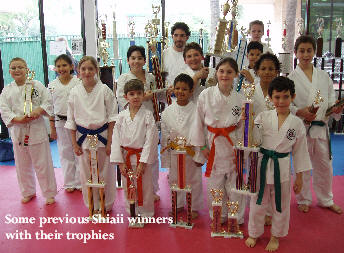
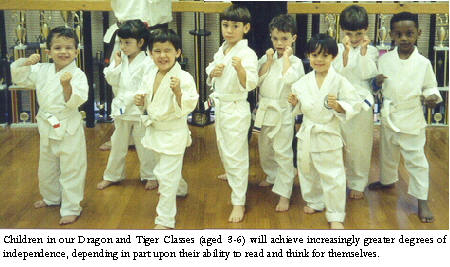
The Space to Train Towards Independence and Freedom
We have asked the parents to cooperate with us in giving our students the space that they need to come to class and train. We know that parents are sometimes anxious about the progress of their children and believe that “being there” for the kids means physically accompanying the child as they enter the facility, helping them with their attendance card, taking them to their classroom and even putting away their shoes.
Here at the karate school we teach children self-discipline, self-confidence and self-esteem as part of our program of personal growth and development by letting them learn how to do these tasks themselves. The Junior level is distinguished from the “Little Dragons” and “Karate Tigers” by the degree of independence that we expect from the children. Competence, self-control, and independence are the cornerstones of our program.
In the half-hour “Little Dragons” class for 3 - 4 year olds the staff fills out the attendance card for the child and the parents are allowed to bring the child into the facility and to shepherd the child to and from the classroom, helping the child put away shoes if necessary. The 4 - 5 year olds in the “Karate Tigers” classes are assisted in a similar fashion, while being encouraged to manage more of these preparatory training steps independently. In the forty-five minute Junior class the child is expected to be capable of doing these basic tasks, or of learning to do them, on their own. As parents and educators it is important that we all work together towards a common goal: providing opportunities for the children in our care to learn how to be independent and self-sufficient.
Abraham Lincoln was once quoted as saying that we don’t help others “when we do for them what they could and should do for themselves.” Here in America there seems to be some confusion about how children learn competence and confidence and how this relates to self-esteem. Nathanial Brandon, who is the author of several groundbreaking books on self-esteem, is very precise when he defines what contributes to building this attribute in children. He believes that the two most important components of self-esteem are self-respect and competence.
When a child is shown respect by the adults in their environment, they learn to respect themselves. When children are allowed to learn how to take care of themselves, they learn competence. In order to learn competence a child needs to be able to make mistakes, to try something and fail, and to be permitted to struggle with difficult tasks on their own terms, without being rescued prematurely by a well-meaning parent, adult or older sibling. We can not learn for them. They must learn for themselves.
Children pick up on adults’ anxiety and learn to fear “failure”. Their natural ability to learn, which is fostered in a relaxed environment where trial and error is nurtured and encouraged, is shut down under the well-meaning guise of parental protection and involvement.
 Self-esteem
is based on, and built through, learning how to be competent in life skills,
according to Dr. Martin Seligman, a leading pioneer in the field of competence
and depression. He says that we teach our children to be helpless when we
prevent them from learning life skills, whether technical, emotional, financial,
physical or intellectual in nature, for themselves. As parents we can give our
kids opportunities by placing them in structured learning situations (with
appropriate supervision) and supporting them in their efforts to learn, by
letting them go through the process on their own.
Self-esteem
is based on, and built through, learning how to be competent in life skills,
according to Dr. Martin Seligman, a leading pioneer in the field of competence
and depression. He says that we teach our children to be helpless when we
prevent them from learning life skills, whether technical, emotional, financial,
physical or intellectual in nature, for themselves. As parents we can give our
kids opportunities by placing them in structured learning situations (with
appropriate supervision) and supporting them in their efforts to learn, by
letting them go through the process on their own.
Seligman’s book “Learned Optimism” explores this topic in detail, with research and empirical data compiled through years of observing the American process of child rearing. As adults we need to make the proffering of “rewards” (praise is a reward) contingent upon the delivery of reasonable, correct behavior from the child. Self-esteem is best developed when the child actually learns how to do something correctly, and that happens only through the process of trial and error on the part of the child.
So, we thank the parents for their cooperation with this learning process. We ask that you let your Junior aged student (6-14 years old) enter and leave our facility by themselves, and that you wait outside the front door. This will permit our many students to come and go through that door easily, and it will also allow our staff to work in a controlled and calm atmosphere.
If you wish to view the class, you may do so through the large windows. Many parents choose to bring chairs and watch many of the classes being taught. Others may use the time their Junior aged child is in class to run errands. We appreciate all of these parents allowing their children to have the “space to train” physically, emotionally and psychologically. If you need to ask a question, schedule an appointment or purchase an item, of course, you are welcome to come inside for those purposes. If you are concerned about knowing what your child is learning, you may choose to purchase a DVD of the belt material your child is studying for home viewing and practice, or you may decide to take class yourself as many parents do. You can also step inside when you bring your student to class and ask them to show you the progress report on the back of their class card. This will allow you to be updated on their progress while still allowing them the “space to train”.
One other point on this subject is my suggestion that, by bringing your child only a few minutes before the class time, and picking them up promptly after class, you can help us to maintain good order in the Dojo. Your children will thrive on good order in the Dojo and in all aspects of their lives.
Shihan Robert H. Mason © 2009
Sensei Anderson Honored
Sensei Susan Anderson was honored in a special Awards Ceremony recently as “Broward County Arts Teacher of the Year.” Anderson has taught at Taravella High School for the past 17 years. She was selected from a very competitive pool of talent. Many of you will have noticed Sensei Anderson demonstrating Self Defense on the Introductory DVD we loan to new students.
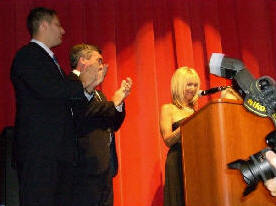
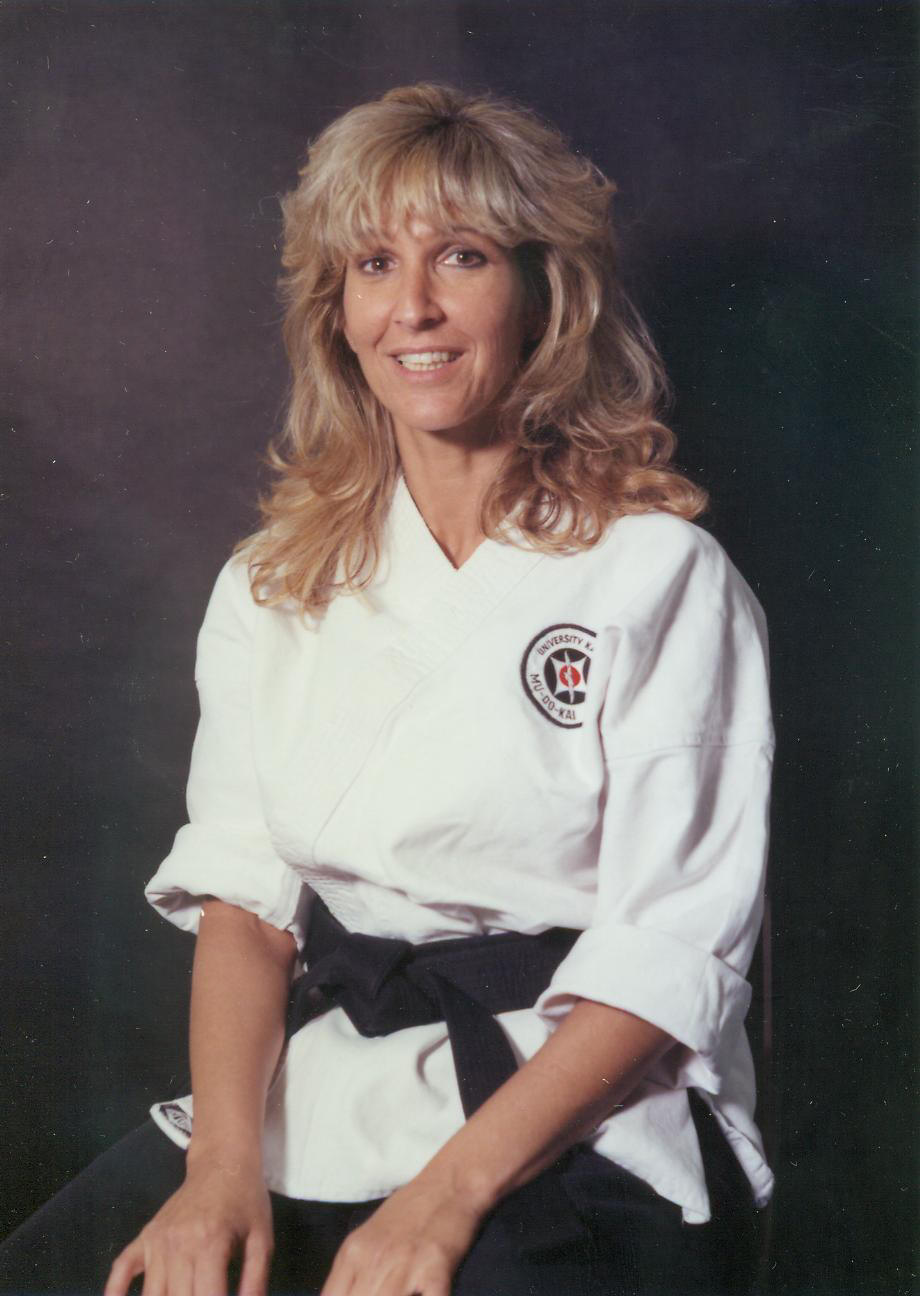
New DVD for Kata
Two new DVDs are now available for Kata, Beginner and Advanced. Ideal for students who would like their Kata on “Review” discs. $39.99 each.
“How wonderful it is that nobody need wait a single moment before starting to improve the world.”
Anne Frank
The Three Qualities of Black Belt Excellence
One of the reasons Martial Arts training brings so much satisfaction is that it teaches a way to look at things as well as a way to do things. To be sure, our complete training program involves all the technical moves you’ll need to advance through your training to Black Belt and beyond. On the other hand, a true Martial Artist cannot expect to make much progress without changes in character to complement physical training. The development of strong character has come to be known as the development of a Black Belt attitude.
Courage
What then, are the qualities associated with Black Belt Excellence? Let’s begin with a familiar (though rare) character trait: courage. You may think of courage as daring, or the ability to do things that people find scary or dangerous. Some dictionaries even define courage as “the ability to disregard fear.” Courage within the definition of Black Belt Excellence is something else entirely. It is the capacity to overcome fear. It’s one thing to pretend you’re not afraid of something (to “disregard” it), it’s quite another thing to face a frightening situation and do what you can to overcome the fear and follow through to do what must be done. Also, it takes real courage to tell a friend that you don’t want to join them in an illegal, unethical, immoral or inappropriate activity just because they think it would be a “cool” thing to do.
Self Control
Another quality of Black Belt Excellence is self-control. Self-control is the ability to stay on top of your emotions when it might be tempting to get mad or frustrated. When you lose control of your emotions in a sparring match you give power to your opponent. Even when you’re so mad you can barely hold yourself back, remember that losing self-control is exactly what your opponent hopes you will do. When you lose control of your emotions in any area of your life you become vulnerable to forces outside yourself that may be beyond your control. Sometimes our only chance of overcoming an overwhelming situation may rest on our ability to control ourselves. Self-control allows you to respond consciously to a situation, rather than just react to it.
Respect
Finally, Black Belt Excellence includes the essential quality of respect. Respect is the attribute by which you honor yourself and demonstrate that you honor others. Bowing to your opponent, and treating a weaker opponent with compassion are two ways to demonstrate respect during a sparring match. You’ve probably already noticed that respect is partly about how you treat others. Being respectful will earn you the respect of others, and will help you to develop a lasting respect for yourself. You may have also noticed that the three attributes of Black Belt Excellence are related. For example, it takes courage to maintain self-control, and at times it takes self-control to show respect for others. This is why we say that Black Belt Excellence is about the development of character. When you achieve Black Belt Excellence, you’ve built a foundation that’s an appropriate blend of courage, self-control, and respect.
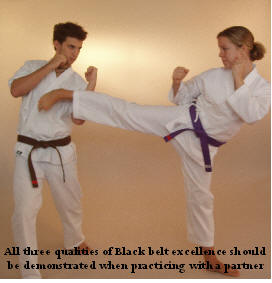
Tournament Team
Sensei Laraine Winston and Joseph Alvarez competed at the recent Pan American International Martial Arts Championships in Miami. Sensei Winston was 2nd in her Forms division, while Joseph finished in 5th place in Weapons, Forms and Fighting competition. Congratulations to both these excellent students for their standout performances.
“With ordinary talent
and extraordinary perseverance,
all things are attainable”
Thomas F. Buxton
Baby visit a Highlight
Sensei Amanda and Jason Miller paid a visit recently to introduce us to their new baby Josephine. She looks just as cute in real life as in her pictures.
“You must have long-range goals to keep you
from being frustrated
by short-range failures”.
Charles C. Noble
Karate and the Inner Game
In Martial Arts it is important to develop the ability to move from perception into action without passing through cognition. This means acting upon what we see, hear, feel or sense without thinking about it. Thinking about anything in our usual way takes time, and in a situation where one’s life may be on the line, time is of the essence.
The problem for most of us is that we think in words. For example, beginners in karate, when questioned about how they are considering a technique will admit that they are talking their way through it, thus: “step back with the left foot, raise the right arm, twist across the body with a blocking movement and follow up with a reverse punch, not forgetting to twist the hips.” While this process works enough to let them struggle through the elements of the movement in roughly the right order, it completely negates the experience of harmonious movement in action.
A better strategy altogether is to stop the inner talking and record an internal movie, a visualization of the whole move, based upon the example of the instructor. One needs then to only run the inner movie a few times, imagining how it would feel kinesthetically to move like the mental picture, before one can begin to practice with relative ease.
Thinking in pictures allows the Martial Artist to take all of the elements of a situation into account simultaneously, and at the same time, anticipate extensions or other specific variables as they arise. On a neurological level, normal verbal thinking takes place in the left hemisphere of the brain, while visualization is a function of the right hemisphere. Activity in one hemisphere tends to inhibit activity in the other. By paying attention to visualization and visual thinking, the Martial Artist automatically takes attention away from the linear sequential, inner talking process of the left hemisphere while at the same time, focusing attention on the functions of the right hemisphere. Controlling one’s mind in this way, it is possible to learn more quickly and excute more precisely the skills of the Martial Arts.
Shihan Robert H. Mason © 2009
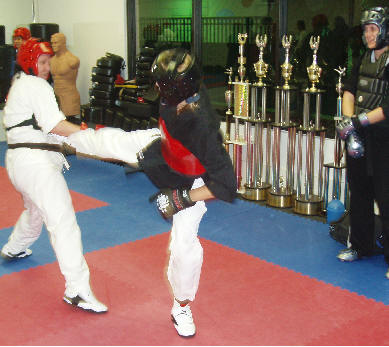
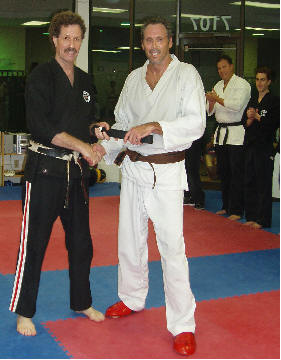
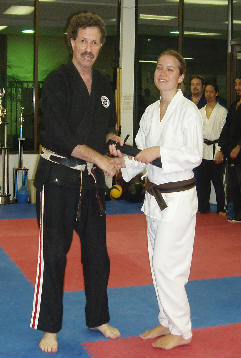
“Energy and persistence conquer all things.”
Benjamin FranklinBack to School: Balancing Karate and Schoolwork
Good news for students returning to public school: the School Board has set guidelines for homework this year. Teachers may only assign a total of ten minutes for Grade One and increase that amount by ten minutes for each subsequent grade level. Hence, a student in 9th grade would be allowed 90 minutes of homework. This more conservative approach to work at home should allow students and parents to better plan their day to include other important activities such as sports, especially karate, family dinner time, and reasonable bed time.
Scheduling your Martial Arts training during the school year or the work week is very individual and all students progress at their own pace, based in part upon their attendance and the intensity with which they practice in class. All new students bring to their first lesson a personal level of enthusiasm, physical talent and capacity to learn, and even as students develop their skills their progress will continue to be based on their individual ability to absorb the training. Although it’s normal in this culture for people to make comparisons from one student to another, this is generally not helpful in Martial Arts.
Balance is as important in your Karate training, as it is at school or at work. Some students may be able to train five or six days a week, while others may only manage twice a week. Any two students might be equal in terms of talent, enthusiasm and learning ability, so that the the extra frequency of attendance and the additional class time would certainly be reason enough for the one student to move at a faster pace than another.
In addition to frequency of training and the intensity of the individual workout, karate needs time to “seep into the bones.” Martial Arts training requires numerous repetitions of each technique with correct form and feeling, to fully program each move into the student’s body. Only with patient practice over time can the goal of mastering each technique be achieved.
Martial Arts is all about self-mastery. Unlike other sports or games people play which are related to acquisition or ambition, Martial Arts looks to mastery of the self, through mastery of technique, as the purpose for practice. For this reason, acquiring red stripes in order to have more than someone else or gaining a higher belt in order to look down on those with lower belts is contrary to the principles at work.
If you are the parent of a young student here at UKC and you believe that your child cannot fully understand these principles, then allow the training to provide the “experience” throughout the months and years ahead. The journey of a thousand miles begins with the first step, but it must be taken in the right direction and at the right time.
Shihan Robert H. Mason (c2009)
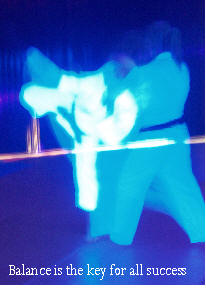
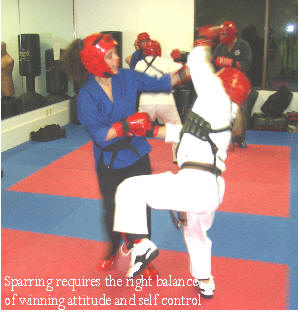
Developing a Winning Attitude
One of the best tools that you can acquire as you go through life will be a winning attitude. Whether in the Martial Arts, in school, or in business, a winning attitude will give you the extra push you need to succeed and make you shine. In fact, one of the most important elements to success in the Martial Arts, and life, is to carry a positive, winning attitude with you wherever you go. But what does it take in our everyday lives to develop a winning attitude?
A positive outlook is the single most important element in achieving a winning attitude. If you hold a positive attitude you are able to relate to the world on a positive basis. People with a positive attitude always look for the “can do,” rather than the “can not do” side of each situation they face. If you think positively, you can have a better chance of succeeding than if you take a negative approach to the situation. Having a positive attitude means believing not only in yourself, but also seeing others in a positive light. A positive attitude is contagious. When it is sincere people with whom you come into contact will relate to you and your activities with a vitality and positive attitude that creates a winning, successful environment.
Another important element in achieving a winning attitude is passion. Passion is the driving force within those people with a winning attitude. It sets them apart from others. Passion is an energy that gives them the fuel to realize their potential and feel good about themselves. When you begin to realize your potential and feel truly good about the person that you have become. In short, you will begin to believe in yourself. This winning attitude is contagious and can be passed on by you to others whom you train with. You can also remind yourself to encourage others to strive to achieve their potential by demonstrating a winning attitude. This is the essence of cooperation within our Martial Arts community.
A final element that can help you to have a winning attitude is energy. If you maintain a high level of physical energy, it will prevent you from feeling tried and discouraged when adversity strikes. Physical energy can be obtained through maintaining a healthy diet, working out regularly both in and out of the Dojo, and taking care of your body and yourself.
Shihan Robert H. Mason © 2009
ISKA World Martial Arts Championships Results
The karate school was featured in the Sun-Sentinel on July 25 in the Community Sports section following the outstanding performance of two of our students at the recent ISKA World Martial Arts Championships in Orlando. Sensei Laraine Winston won second place in her Black Belt Kata division. Green Belt Hannah Misciasci also won second place in Intermediate Kata and fifth place in fighting. The tournament attracted over 3,000 competitors from forty different countries and from 33 states in the USA. The event is held annually at the Coronada Resort in Disney World. The US Open is sanctioned by the International Sport Karate Association (ISKA) as the World Martial Arts Championships and is recorded for broadcast on ESPN2. Shihan Mason is Chairman of the Board and World Commissioner of the ISKA.
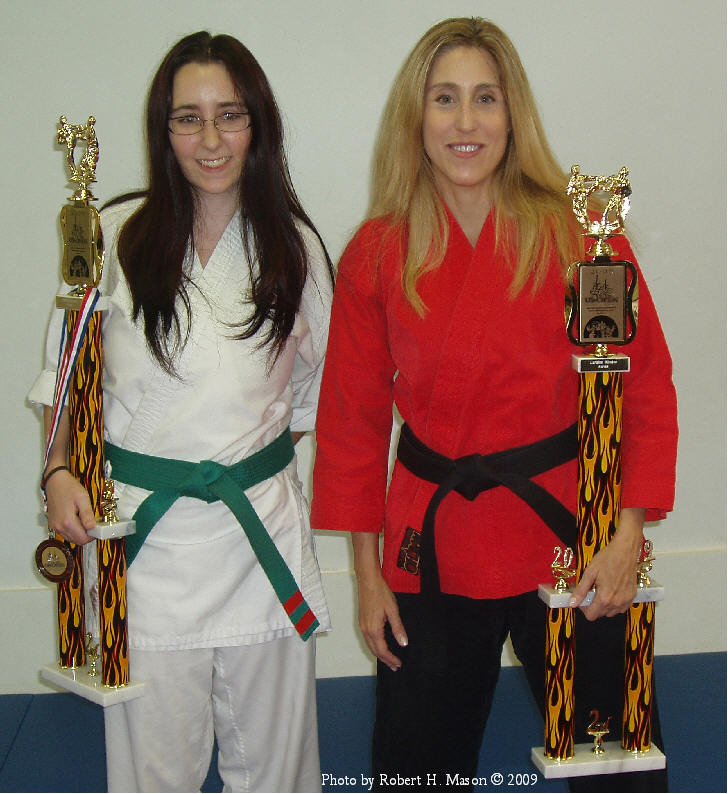
Focus, Distraction and the Dojo
While having tea recently at a local English tea shop in Hollywood, I noted that one of the reasons that the experience was so relaxing and enjoyable was that the entrance to the “tea shop” (in the back of the shopping center) was separate from the entrance to the retail portion of the same business (in the front). This allowed for the “refreshment” section of the establishment to be undisturbed by the hustle and bustle of a regular store. The focus for the tea shop was completely on the customers and the task at hand (serving tea); there were no unnecessary distractions.
Here at the karate school this is also the goal: to focus on the primary purpose of the Dojo (teaching class) and to separate the office business (giving stripes and grading materials, parent queries, equipment sales and new student enquiries). It has always been my belief that training must be focused and distractions must be minimized in order to maintain the atmosphere of serious concentration necessary for progress in the Martial Arts. The Sensei then has the best opportunity to lighten or deepen the mood of the training as appropriate for the group he is working with. Unlike many martial arts schools, our viewing section for parents, and other interested persons, is outside our Dojo. This allows the students and the instructor to concentrate on training without the distractions that could occur if we had an inside audience, or an office area with ringing phones, visitors and side conversations in the same space.
I have often called a martial arts school to speak with the head instructor only to have them pick up their office phone and tell me that they could not speak to me since they were in the middle of teaching class. Having my instructors also taking care of the office duties would not be efficient or effective, as the focus of the class cannot not be maintained in this kind of atmosphere. Even in the office area of our Dojo we do not allow cell phones to be used as these private conversations would detract from the focus of the space. Students waiting for class are welcome to speak with each other, but children often have to be encouraged to develop an “inside voice”, in order to maintain the right atmosphere for the office and the staff to work in the way that I want. Much of this effort on my part to develop the Dojo as a sanctuary from everyday life may seem weird to new students, and unnecessarily fussy to parents who do not train and have no prior experience of the Martial Arts. My suggestion is that they have faith in the process, and over time they will come to see the benefits of focused training.
Shihan Robert H. Mason © 2009
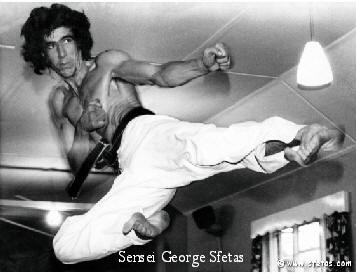
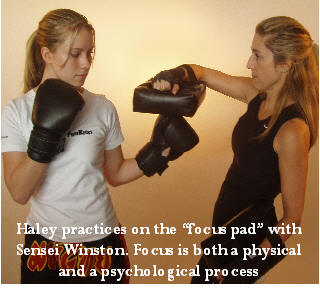
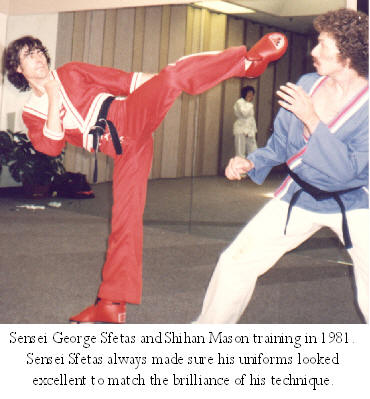
Our recent demonstration for safe kids in Plantation
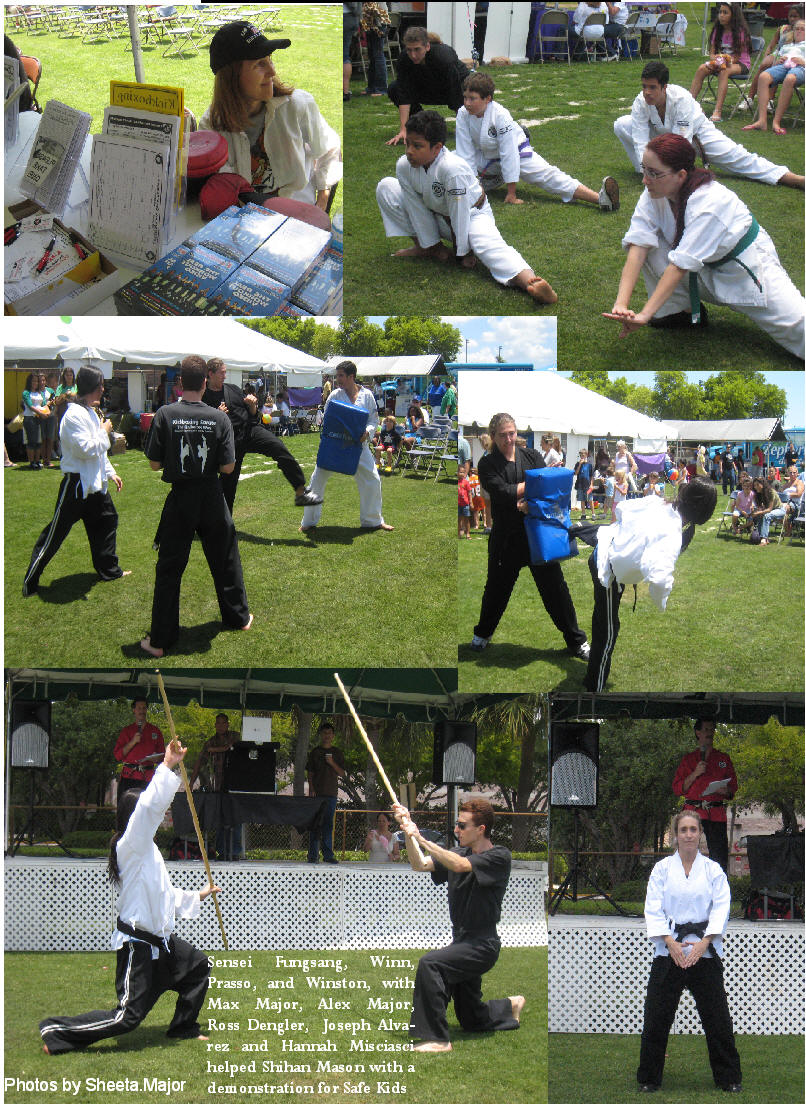
Fashionably Fit For Class
Many sports have a special uniform that is worn by their participants. In the martial arts it is called a “gi” and consists of a karate top and karate pants, tied with a belt. The uniforms worn in the different styles of the martial arts each have their own traditions of “style” and color. In Goju a black uniform is worn, in Kung Fu a sash is worn with a looser fitting garment and in Tai Chi the exponents often wear shoes with a pajama-style “outfit”. My MuDoKai Kyu ranked students wear a plain white jacket (sometimes a “logo” v-neck top) with karate pants (draw string or elastic waist) and a belt that indicates the student’s rank. Black Belts are permitted to wear uniforms with their own selection of color and style.
In order to train properly it is important to have the pant leg hemmed just above the ankle. This insures the student’s safety, so that they do not trip over their feet, and also gives a better overall look to the student’s appearance. In Japan students often wear karate pants hemmed to the mid-calf to keep them completely clear of the ankles for kicking.
A clean, wrinkle-free uniform was considered essential by all of my Sensei, including Greek Gold Medal Champion and British team member Sensei George Sfetas, who was famous for ironing his own uniform, a heavyweight Tokaido, and also for turning students away from class whose uniforms were unsuitable, wrinkled or dirty. Sensei Sfetas returned to Greece in the 1980’s and became famous acting in action movies with his son Chris. What made him special was that he always looked sharp and exuded the confidence that came from knowing how good he looked and how well he could perform.
So be “fashionably fit” for class by planning ahead. A second uniform is always a good idea, (one for the wash and one ready for class). Also, always remember after class to hang up the uniform (rather than stuffing it in a bag for the next time). If you wish to wear a T-shirt under your white gi, be sure that it is a plain white shirt. Martial Arts came originally from the Military Arts, where a well turned out, clean, sharp and complete uniform is always considered essential. Looking good in every respect is all part of our Martial Arts training.
Shihan Robert H Mason© 2009
Stretching for Success
Warm ups, the stretching that a student participates in at the beginning of class, is an important part of training. Students need to pay close attention to the Karateka who leads the warm ups and follow their directions so as to be sure that they are stretching correctly and moving together as a group. Unnecessary talking and socializing is distracting and dilutes the Dojo atmosphere which is necessary for proper training. Just as bowing when entering or leaving the Dojo sets the tone of courtesy and consciousness that martial arts represents, so each action performed is intended to lead towards greater focus. Making the right kind of effort in warm ups is a way to start the class with the right training attitude.
Some stretches will be difficult at first. You may not be able to stretch as deeply as the more experienced students. This is OK. Stretching is not a competition. The goal is to become more flexible so that you will be able to kick, block and punch at a more and more sophisticated level. Most new students find that their muscles are quite tight and do not allow them to kick very high or very easily. Your kicking will improve as you become more flexible. All of the stretching that you practice at the beginning of class can be practiced at home to improve your stretching. There are a few important points to remember:
1) Make sure that you understand how to practice the stretch correctly.
2) Make sure that you keep the pressure off your joints. You do not need to stretch your knees.
3) Use your breathing to allow you to relax more and more deeply into the stretch. By using your breath you will be able to stretch further and relax into the stretch more deeply for better results.
Check out the Splits Club photos and aspire to achieve complete flexibility.
Even if you never achieve complete flexibility, regular training and stretching will allow you to improve.
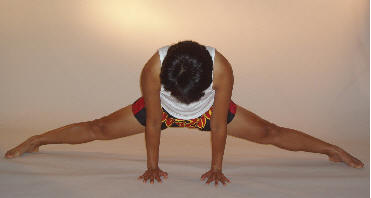
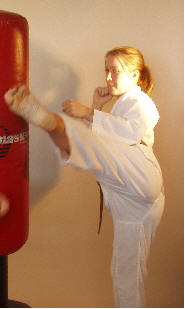
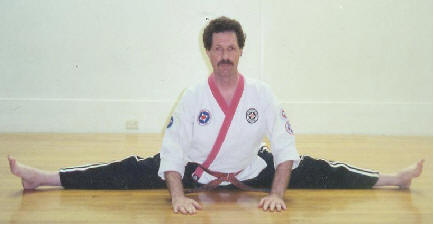
Stretching is equally important for Martial Arts and Kickboxing classes. Your kicking skills will improve as you become more flexible.
What does Shihan Mason do when he’s not teaching class?
Even when Shihan Mason is not at the Dojo he’s usually involved in Martial Arts activities. Sometimes he teaches seminars on specific Martial Arts skills. He also teaches seminars to qualify judges, referees timekeepers, scorekeepers and other officials for Martial Arts and Kickboxing competition. He often attends events like the World Breaking Championships, the World Weapons Championships and the World Sport Karate Championships in his capacity as World Commissioner for the International Sport Karate Association, a position he has held since 1988. Most of these events take place on weekends, but just because you don’t see him at the Dojo does not mean that Shihan is not working. You can catch ISKA events on espn2 and on the Sunshine network, as well as on NBC every Saturday latenight at 2:00 am (Strikeforce on NBC).
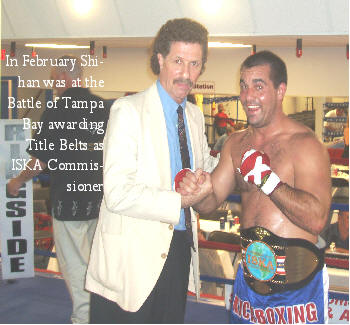
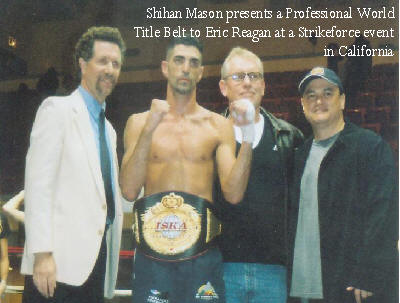
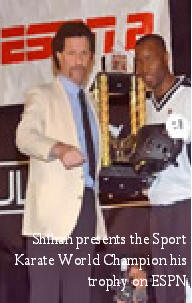
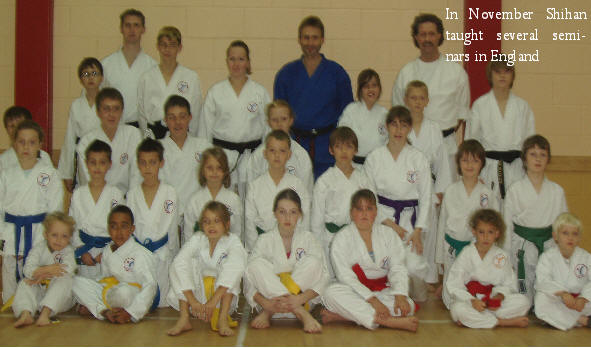
Balancing Act: Too much Homework?
The Sun-Sentinel headline on the front page of the Friday paper March 20, 2009
“Education Debate: Bringing home too much work?”
For many years there has been ongoing debate between educators, parents and students over “how much homework is too much.” Homework advocates say “a demanding load reinforces classroom learning, develop students’ responsibility and encourages independence.” Critics attest that “too much homework erodes childhood by encroaching on leisure time and infringing on extracurricular activities.” Both sides make some good points, and I would not say that homework should be scrapped entirely. However, given that children spend all day at school, mostly sitting at desks, it seems unreasonable to sentence them to more of the same every evening.
Back in the 1970’s two American Developmental Psychologists, Furth and Wachs, attempted to start a school for thinking (Thinking goes to school 1975). Their idea was to incorporate principles for developing thinking skills in classes for kindergarten and first grade students. The experiment failed miserably because parents and teachers alike could not relate to the scientifically based program, that included walking on balance beams and physical exercises designed to encourage the development of thinking. Since that time I know of no efforts to include a scientific approach to thinking development within the educational system. Rather, education in the USA is primarily traditional in structure, with a tendency to focus during elementary school on teaching reading and writing, skills that should have been acquired at home between ages one to three years old (Glen Doman: “Teach your baby to read” and “Teach your baby math”).
Recently, the Broward County School Board entered the discussion when it “unanimously revamped the district’s homework policy.” The new guidelines call for a “nightly total of 10 minutes of work multiplied by the grade level.” A first grader’s assignment would therefore take 10 minutes to finish, while “a high school Junior’s total homework would take 110 minutes.” This seems more reasonable, particularly because the board has also called for teachers to coordinate assignments so that “projects are not assigned at the same time.” The board also calls for teachers “to be considerate when assigning work due after religious holidays and vacations.”
Joyce Fine, an associate professor at FIU College of Education, commented that a key point, is “making after-school assignments meaningful.” She continued, noting that “a few examples can do the same thing as pages of examples.” Surely children will get the most benefit from demonstrating the development of their thinking skills. Ms. Fine noted that she would “rather see quality thinking than overburdening children with many examples that don’t allow them to gain anything.”
I believe that this is a huge step forward. Our Martial Arts program has always been based on concepts drawn from Developmental Psychology, to promote the development of thinking, initially involving a sensory-motor approach. Through the unique movements of our system, coordinated with breathing, we develop physical emotional and psychological integration, along with improved perceptual skills and cognitive development through visualization. We just need our students here to have time to practice. Less homework will create more time for training.
© Shihan Robert H. Mason 2009
Stranger Danger?
One of the things that Martial Arts teaches children is how to distinguish a stranger from a friend; how to feel the quality of the energy that someone brings to their interactions. While we cover this and other issues of “Self-Defense” on a regular basis, it is important for these ideas to be reinforced at home as well. Awareness is always our best first weapon for Self-Defense.
The Benefits of Training in MuDoKai
I often speak to the parents of our young students and realize that they actually are not aware of all of the benefits their children are receiving from the training that we offer. In many instances these parents have never trained themselves and have only enrolled their child in our program because the child showed an interest. Part of our job here at the Dojo is, therefore, to educate these clients. There are three main reasons why people train in the Martial Arts. The first is “Personal Growth”. By getting to know how we function, and learning how to function better, we become more accomplished as individuals. Physically our combination of Kickboxing, Karate, AikiJiuJitsu, Judo, and Kobudo training offers a vigorous but accessible training opportunity that develops balance, coordination, flexibility, strength, agility and fitness. Emotionally the training (including the breathing skills that are involved), leads to additional benefits that include emotional balance and self-control. Psychologically we work to improve awareness, perceptual skill, timing, distancing and, as a consequence, improved confidence and the acquisition of self-discipline. I have always insisted that students practice with correct alignment and a clear understanding of the lines of motion involved in the execution of each technique. This leads to correct posture and body use which allows for the development of physical talent. Talent cannot achieve its potential without correct posture and body use.
The second reason that most students train is for Self-Defense. I recently saw the movie “Taken” starring Liam Neeson. The basic plot is about a father struggling to save his daughter from kidnappers. The movie posed for me the question “how prepared are most adults to defend their family”? We all anticipate that our children will grow up and become parents themselves someday, so how ready will they be to defend their families? I know that in the USA guns are often considered to be the answer for adults for personal protection. My quick answer to questions on this issue is that “if you are not good at fighting without a gun, you’ll probably be no good with a gun”. A fight is still a fight, regardless of the weapons involved. One thing is certain, if you carry a gun then any altercation you have includes the gun, which may end up being used against you.
The third reason that students train is for sport. There are many sporting opportunities for Martial Artists now. As the World Commissioner for the International Sport Karate Association (since 1988) I’ve seen the Martial Sports develop tremendously. I now sanction events worldwide that often end up on one of the TV shows I own as one of four shareholders in United Sports International. Our series on Espn2 called “ISKA Karate” features ISKA World Championship Kickboxing from around the world, plus the World Championships in Forms, Weapons, Self Defense, Breaking and Demonstration competition. You can also catch these shows on “Fightsports” latenight on the Sunshine cable network. If you like the MMA format check out my newest show “Strikeforce on NBC” at 2:00 am Saturday late night (technically it’s Sunday morning) on NBC (Channel 6). While competition is not the main reason that my students train, the Dojo has produced many champions over the last 29 years.
With all of these benefits I hope that many more members of the community will choose to seek Self-Mastery through the Martial Arts at our American International Karate Institute here at UKC. In short, this is why people should take MuDoKai lessons, and we do appreciate your referrals.
© 2009 Shihan Robert H. Mason
Role Models and Mentors
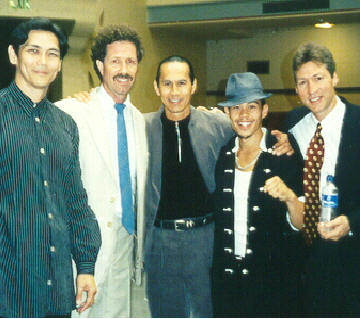
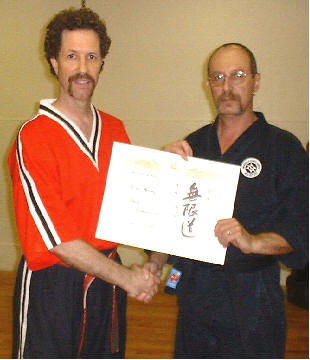
|
Some of the worlds best known Martial Arts mentors: L-R Don “the Dragon” Wilson, Shihan Robert Mason, Ernie Reyes Sr., Ernie Reyes Jr. and Mike Sawyer. |
“Sensei” means “one who has gone before”, more or less the definition of a mentor. Here Sensei Stamp receives his rank from Shihan Mason. |
Who can be a role model or mentor for us? In life there are dozens of people to look up to including our parents and grandparent, siblings, uncles, aunts and cousins, school teachers and Martial Arts instructors. Among these folks we can find many positive influences to inspire our lives. As a Martial Artist, it is your responsibility to be aware of these people and to learn from the knowledge they impart to you. It’s also a good idea to pay attention to everyday heroes. These aren’t necessarily people in the news. They are people you see in your everyday life, living in a way that improves the lives of people around them. In your life this might be a bus driver who always greets you with a smile or a joke. Perhaps it’s an instructor at your Dojo who always lends an ear when you have a question. It could even be a stranger who took the time to return the wallet you dropped on the street. When you live your life with an awareness of the people and events all around you, you begin to notice the small kind deeds and heroic acts that happen everyday. You learn that a person doesn’t need to live a perfect life to have a positive effect on other people. In fact, you may find that the people who have dealt with difficult situations – even situations they created – can help you the most as a result of their experience.
The USA has a new President, Barack Obama, who has mentioned that throughout his life he has actively sought out mentors to help him learn new skills and develop new ideas, by drawing on their experience. Regardless of our political persuasion the President’s observation in this regard serves as an excellent model for building our own opportunities for success. Be open to the lessons being offered by people who have traveled before you. When they can say “I’ve been there” about a problem you are facing, maybe they can share an insight with you on how best to handle your situation. It’s easy to look at the news and say, “there are no role good role models or mentors available today.” If you do, you will be closing your mind to the gold mine all around you. Open your mind instead – be aware of the everyday heroes all around you, and strive to match every small kindness you see with one of your own. Soon you will discover that there are many mentors and role models right under your nose.
© 2009 Shihan Robert H. Mason
“You must learn to be still in the midst of activity
and to be vividly in repose.”
Indira Gandhi
Integrated Training for Mind, Body and Spirit
It is essential for Martial Artists to stay focused on whole self, the mind, body and spirit. People often take one or more of these elements for granted. Martial Artists practice, stretch and visualize their techniques, to fine tune their physical, emotional and mental ability to focus and to maintain their overall health and to set the tone for a positive lifestyle.
Developing this type of self-awareness requires, first and foremost, discipline. Whether you have five minutes or an hour, you must set aside some time each day to devote to improving the condition of your mind, body and spirit. The time you spend on the task is well worth the benefit. “Tuning in” to yourself will allow you to stay focused, to become more fit and flexible, and to reach higher levels in your Martial Arts training and in your daily life.
Morning is a good time to work on self-awareness. Before you get dressed, spend five or ten minutes doing breathing exercises and clearing your head. You might want to sit cross-legged on the floor or just sit on the edge of your bed. You can close your eyes, breathe in and out slowly, filling your belly with each breathe (this is called abdominal breathing), and focus on being still and quiet. Pay attention to your abdomen filling with air, your muscles relaxing, and your spine extending upwards to maintain a state of poise. As you do this, you will achieve a sense of wholeness and your mind will clear. Taking this time will help you prepare for your entire day; you will become more focused and you will be able to concentrate better on your work throughout the day. Your body will feel relaxed, calm, and any tendency you may have towards anxiety will be replaced by a sense of confident presence. All of these elements make for a great beginning to a new day!
Getting in tune with your body will not only help you feel better, but it will also help you recognize when something is not quite right. For instance, those who are more in tune with their bodies know right away when a cold is coming on. By being able to detect a slight discomfort early, one can take preventative measures, such as drinking more orange juice and taking vitamins before a cold is full-blown. Don’t underestimate the value of spending a little quiet time with yourself. You can also benefit from repeating your self-awareness exercise before you go to sleep at night.
Being a Master of the Martial Arts takes more than just technical skills. Keeping your mind and body in great condition and your emotions balanced, will help you become more creative and aware. As this happens, you will begin to express joy and confidence in every aspect of your life. This is truly a manifestation of the Martial Arts spirit.
© Shihan Robert H. Mason 2009
|
|
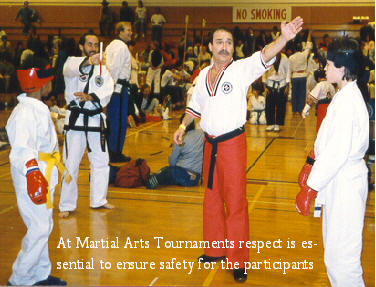 |
Respect
Respect is a word that is sometimes misunderstood in our culture today. Aretha Franklin, one of the most respected singers of popular music, sang it into the memory banks of most baby boomers, and there it stays, in our vocabulary, but not necessarily in our behavior. To quote the song, “R E S PE C T, find out what it means to me”.
According to Webster, respect means high or special regard, the quality or state of being esteemed (to set a high value on, the regard in which one is held, to regard highly and to value accordingly). Regard means to look at or appreciate from a particular point of view.
The foundation of the Martial Arts is respect. Karate Do, the way of the empty hand, originated in the East, where deferential behavior is an established part of the culture. In feudal Japan a lack of deference to a person in authority was taken to constitute a lack of respect. In the USA we are somewhat used to this perspective where Judges or Police Officers are involved, but not necessarily in social or work situations.
We live in the most influential Western country in modern times, whose traditions place a high priority on individual freedom and equality, rather than on a deferential respect for authority. These traditions form a significant aspect of our recent cultural history, which includes the turbulent civil rights and counter-culture movements of the 60’s and 70’s, as well as the cornerstone of its origins in the U.S. constitution. Yet here in the Dojo we are attempting to practice an art which paradoxically promotes a quality that we have generally abandoned culturally, at least since the colonists threw off the yoke of King George and established the USA as an independent republic.
It is almost like a Zen koan, e.g. “what is the sound of one hand clapping?” How can Americans assert themselves in the manner that their heritage and our personal histories encourage, and yet be open to the teachings of a “foreign” art that seems to emphasize an almost deferential level of respect? How can we learn what the martial arts has to offer while still retaining our individuality? How do we explore the advantages of deferential behavior in our karate training without becoming subservient? After all, Americans are sovereign citizens, the country was founded on the principle that… “all men, (and women as of 1921 Right to Vote Amendment) are created equal.”
It is understandable that many Americans do not feel comfortable with the traditions of courtesy and respect inherent in the Martial Arts, because they involve what appear to be external signs of subservience: the bowing when entering and leaving the Dojo (training hall), the method of addressing the Black Belts as “Sensei” (one who has gone before), taking off one’s shoes before entering the Dojo, the restriction of entry into the training facility to students only. All of these customs are unusual at a time when popular culture often promotes breaking the rules, and encourages a level of disrespect for authority. Of necessity, Martial Arts training requires etiquette, in order to maintain safety, structure and discipline in an art which gives its practitioners the power of life and death. The consequence of this training includes the development of respect and self-control, both qualities that will be appreciated and respected in our relationships with our families, friends, colleagues and those with whom we interact daily.
© Shihan Robert H. Mason 2009
“Without continuous effort there cannot be
continuous achievement”
Orison Swett Marden
“You cannot learn
how to do something
by reading about it.
You can only learn
something by doing it.”
David McCullough
Exercising as a Way of Life
In a recent interview about her hectic schedule Secretary of State Condi Rice was asked how she maintained her health and fitness while traveling. Her response was that she did not miss a day no matter where she is in the world. Exercise is part of her schedule and so she is committed to maintaining her fitness, in spite of a busy life.
It is important to continue healthy habits even when we are stressed with the demands of our daily life. One of my most enthusiastic adult students was a very successful and busy attorney who was interested in training but thought he was too busy. He would bring his son to class and express a desire to join. He eventually decided that he could set aside regular time to train, even putting the karate classes in his work appointment book.
When people do physical exercise endorphins are released into their system and a feeling of well being is experienced. Using this energy, and taking time out from the immediate demands of a stressful schedule on a regular basis, a person can build physical, emotional and inner strength with which to better deal with the demands of modern life. This all round fitness strengthens the immune system, decreasing the likelihood of illness and increasing our energy and motivation.
Many people who have not trained in the Martial Arts do not realize what a thorough workout our training can provide. The benefits include improved flexibility, stamina, agility, balance, coordination, cardiovascular fitness and proprioceptive awareness.Shihan Robert H. Mason © 2008
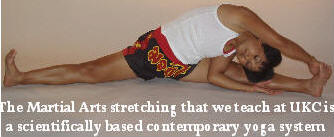
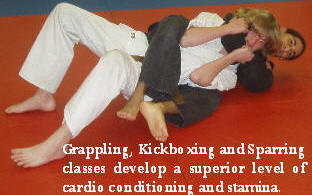

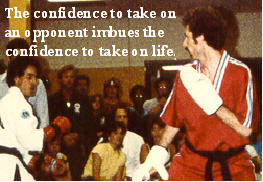
Shihan Mason in England
During his two week visit to England in November Shihan Mason taught five seminars. Here he is pictured next to Sensei Chris Kent (Blue gi, back row) who arranged the sessions.
Meeting the Challenges of a Tough Curriculum
A strong curriculum is a good basis for martial arts training. By having a structured curriculum for students to work through, skills can be taught at appropriate times as the students move up through the belt ranks. This structure requires students to be in training regularly for several years before being permitted to learn advanced techniques that are better taught only to loyal, sincere and trusted students who have proven their capacity to understand the values of the martial arts, and who demonstrate a high level of self-control and personal integrity.
From time to time parents of young students have voiced the opinion that the belt requirements at UKC make progress for their children too slow when they reach the advanced ranks. The reason that many children find the Brown Belt ranks (3rd Kyu to 1st kyu) to be difficult to get through is that I expect the students to fully understand and be able to perform all of the required skills on a very high level. Additionally, a level of emotional maturity, personal integrity and self-control must be exhibited by advanced students. This is often a challenge for youngsters.
Following the achievement of the Black Belt rank, the students begin to be trusted to a much greater degree with the inner principles and secret techniques of our Mudokai karate system. I must know these students well enough by this time that I am absolutely certain that they can be trusted with this knowledge.
The quest for Black Belt should be symbolic of the quest for personal perfection; for the realization of wholeness of being. It follows then that the quest from Black Belt onward should be undertaken only by those who have actually attained the proper degree of emotional maturity and self-control that come from actually achieving a real Black Belt rank.
The journey to Black Belt and the consequent journey beyond Black Belt to self- mastery must not be confused with the symbols that we utilize along the way to designate skills. That is, we must not make the belts themselves more important than the knowledge which they represent. After all, if it was just about the belt you could go to a martial arts store and buy one for thirty dollars. The value that the belt represents lies in the standard of achievement required to earn it. The training curriculum around which the belt structure is organized, when properly utilized, provides an excellent program for measuring advancement in martial arts skills.
Maintaining a disciplined structure helps to prevent the abuse of martial arts techniques that can occur when advanced principles are made available to those who have not earned the right to this knowledge. Through a program that develops balanced emotions, and a willingness to function as good citizens within the community, these techniques can be safely taught at an advanced level. Shihan Robert H. Mason © 2008
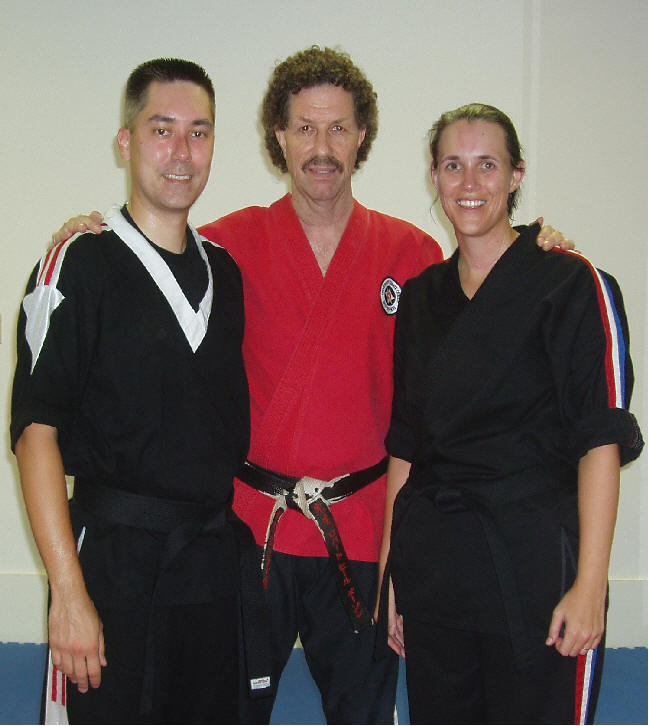
Shihan Mason with Jason and Amanda Miller after achieving 2nd Dan rank
An Experience of Kata by Leslie Sokol
My martial arts training in MuDoKai started in February 2001. In May I became a yellow belt and was introduced to the newest challenge of my training- Kata. It was a difficult struggle for me. I have long been aware of my weakness in spatial relationships. That is, I have always had difficulty reading maps and determining where I was in relation to the map, I even struggle with what size Tupperware I need for my leftovers; and mathematical concepts, especially geometry have always been a nightmare!
It was no surprise to me that Kata, which at its simplest is movement through space, would be highly challenging for me. To learn my first Kata, in addition to regularly attending classes, I had to watch my video and write down each and every move, study it and then attempt to execute it. Not very practical but it worked. It took me four .months to learn. I also had the help of some caring Sensei and higher ranked students that generously offered me their time and patience. To them, I am sincerely grateful!
Here’s how it paid off:
I just returned from a five-day spiritual retreat. It was created for the purpose of giving the attendees experiences, which would transform their levels of consciousness. To achieve this, we participated in numerous practices such as spiritual teaching, yoga, meditations and visualizations, which integrated all modalities of a human being that is mind, body emotions, and spirit.
One of the “exercises” was to experience space without sight, in complete darkness. My mind screamed I CAN”T DO THIS, while my emotions reacted with TREPIDATION and ANXIETY, and physically I felt OFF-BALANCE and UNCOORDINATED. In that moment, I wasn’t connected to anything spiritual; I was stuck ‘to’ and ‘in’ all of those negative thoughts and feelings chattering in me.
I decided to do my Kata. My purpose in doing so was simply to get my mind off of all the negative “noise”. What I received, however, was a lot more! As soon as I started Kata my mind and body relaxed. I regained my physical balance and felt coordinated. As a result, my body moved as an integrated whole, rather than movements of separate parts; feet, arms, torso, and breath. I experienced a heightened sense of the space around me; my body and mind sensed where they were in relation to the space around them. This grounded me, rooted me to the earth while at the same time connecting me to the heavens (atmosphere around me). My perception was greatly enhanced, all of my senses were operating as an integrated whole. I became keenly aware of the energy filling the space and was able to feel shifts in the energy as I executed different movements. At no time did I ever bump into or step on any other person in the room.
Internally, I felt connected to my true self. So tuned in was I to the energy field within and around me that I sensed my breath as an energetic exchange between the external world and internal world, making the breath the entity which connects us to the universe. I believe this occurred because my four centers (emotional, physical, intellectual, spiritual) were in balance. My mind was led by my intention to do Kata which halted its chattering; Kata’s purposeful body movement eased my body’s sense of “dis-coordination” being in the dark; serenity was brought to my emotional center by feeling emotion as waves flowing through me; the by-product of all this was a deep connection to my spiritual self and a sense of the infinite universe.
The question I had taken away with me from this experience was: How can I apply this to my “real” life, the external world, the world bound by time and encumbered by obligations and responsibilities? It seemed easy to do in the context of a spiritual retreat where all is possible. This is my answer, this is what I have learned: In any situation, at any moment in time, I have within me the capacity to transform my reality by paying attention, pausing to breathe, and forming an intention with a higher purpose. This time, Kata was my vehicle; I believe this is true for all of us!
© 2001
Karate and the Inner Game
In Martial Arts it is important to develop the ability to move from perception into action without passing through cognition. This means responding to what we see, hear, feel or sense without thinking about it. Thinking about anything in our usual way takes time, and in a situation where one’s life may be on the line, time is of the essence. The problem for most of us is that we think in words. For example, beginners in karate, when questioned about how they are considering a technique will admit that they are talking their way through it, thus: “step back with the left foot, raise the right arm, twist across the body with a blocking movement and follow up with a reverse punch, not forgetting to twist the hips.” While this process works enough to let them struggle through the elements of the movement in roughly the right order, it completely negates the experience of harmonious movement in action. A better strategy altogether is to make an internal movie, a visualization of the whole move, based upon the example of the instructor. They need then just run the inner movie a few times, imagining how it would feel kinesthetically to move like the mental picture and they can begin to practice with ease.
Thinking in pictures allows the Martial Artist to take all of the elements of a situation into account simultaneously, and at the same time, anticipate extentions or other specific variables as they arise. On a neurological level, normal verbal thinking takes place in the left hemisphere of the brain, while visulaization is a function of the right hemisphere. Activity in one hemisphere tends to inhibit activity in the other. By paying attention to visualization and visual thinking, the Martial Artist automatically takes attention away from the linear sequential, inner talking process of the left hemisphere, while at the same time, focusing attention on the functions of the right hemisphere. Controlling one’s mind in this way, it is possible to learn more quickly and excute more precisely the skills of the Martial Arts.
When we consider the question, “what is thinking?,” many of us might assume it is like talking to ourselves inside our heads. Most thinking may follow this pattern, but there are other ways to think. Perhaps the most obvious alternative to inner talking is inner picturing or visualization. Thinking in pictures has some distinct advantages over thinking in words. At the same time, teachers and parents sometimes discourage this mode of thinking, giving it the label “day dreaming,” and thus, stifling its development. The major problem with verbal thinking is that it limits us to having one thought following another. Just as you would not be able to read this sentence if each letter was printed one on top of the other, so, to think in words, you must think one word after the other to make sense of the sentence. Thinking in pictures, on the other hand, allows us to consider several variables and their relationship to each other, simultaneously. This kind of thinking is essential in karate training.Sometimes a student will try to talk their way through a move and I notice that the attention that they give to the detail of the movement usually reduces the other elements of the technique. The result can be a robotic caricature of what they should be doing. A student who is working, even at a reduced speed, from an accurately visualized perception of a move, can execute the technique smoothly with an all inclusive harmony of form and power.
During a sparring match, the inner talking student can fall into complete disarray as his mind jumps around wondering, “what punch should I do?, should I kick now?, what is he going to do?, what will my friends who are watching think?,” etc. The visualizing student concentrates upon picturing connections and patterns of movement relative to himself and his opponent. He is simultaneously aware of his stance related to his opponents, the play of distance between them, the timing and rhythm of his opponent’s movement relative to his own, and the messages his opponent is sending him through his body language. As a result, the visualizing student is in touch with himself, his opponent and other environmental variables simultaneously and in the moment. The verbal thinker, on the other hand, is stuck in conceptual abstractions that obstruct and interfere with his perception of what is going on. His responses may be slow and robotic, and limited to the specific analytical moment he notices at the time. In short, he is out of touch and easy to defeat.
Visual thinking can be seen to be essential for success in karate training. It is important in many other areas of life as well. Think about it!
Shihan Robert H. Mason ©1990
Bullying
Standing Up to Teasing and Bullying in School and in Life
It is difficult to assert yourself appropriately if you cannot defend yourself physically. Having training in self-defense skills gives students confidence to be appropriately assertive. Where bullying is concerned we all need to consider the following:
*Parents and teachers must recognize when bullying is happening and confront it immediately
*Do not support bullying by passively watching it you must intervene or seek assistance
*Girls bully emotionally by threatening to withdraw attention or not be friends. Boys are more physical
*Always try to avoid violence (walk away or talk it out if possible). In a physical interaction emphasize blocking rather than hitting back if possible
*Bring the situation to the attention of a parent or other adult as soon as possible
Children who do not have strong family support tend to be less skilled in how to handle conflict.
A number of studies indicate that incidents of bullying and youth violence are increasing because many children do not have appropriate outlets for their emotions or people to help them work through issues. Training in Mudokai Martial Arts develops emotional balance.
Many studies indicate that children show more aggressive acting-out behavior after watching violent films and playing violent video games. Disciplined Martial Arts practice is an outlet activity for every students energy, while strict enforcement of Dojo etiquette does not permit violence at any time and constantly reinforces the development of self-control.
Because Martial Arts practice emphasizes self-control, and allows children to be systematically desensitized to the initial panic response that is common when an aggressive attack is launched at them, they are more prepared to deal with bullying. Reflexive training will bring blocking skill into play without having to think about it. This physical preparedness builds confidence in students and lessens the likelihood of an attack occurring. As young Martial Artists children can learn to be in control of themselves physically, emotionally and psychologically. This gives them the best opportunity to be in control of a situation where a bully might threaten them or actually attack them.
Bullying and teasing is unfortunately still too common. By helping youngsters prepare to deal with it, we can help to diminish one of the most upsetting childhood experiences.
© Shihan Robert H. Mason 2008
How to Earn a Stripe
Walk into the Karate School in a quiet and civilized way and get your card from the box.
Walk to the Dojo and put your card into the “in” box and sit on the bench calmly and quietly. If you must speak keep your voice low so as not to disturb the atmosphere. The staff may be on the phone and classes are in session. Demonstrate that you are respectful of this.
Enter Dojo respectfully and follow all directions given to you by the Sensei or the Sempai. During the warm ups concentrate on stretching your muscles in exactly the way that you are being shown. By stretching correctly and attending to your breath as you stretch you will warm up properly and extend your flexibility. Be sure to keep the pressure off your joints.
Try your absolute best the entire class. Watch carefully when the Sensei shows you each technique. Be prepared to demonstrate if asked, but do not interrupt the Sensei by trying to show off. Execute each move with intensity, speed and power, but be sure to train your body to make each move correctly. It is very important not to hyperextend your joints by punching or kicking in the air to full extension.
Stay on task. Do not let your mind wander for a moment from the job at hand. If you are drilling on your Kata or practicing your Pairs or Self-Defense techniques with a partner, you must stay focused. Maintain your discipline.
Know the material you need to know and do it well. By training regularly and visualizing your moves every chance that you get between classes, you can constantly build your familiarity with the techniques required for your rank. If you can practice at home with Shihan Mason on DVD you will progress even faster. DVDs are available for purchase at the Front Desk for all ranks through to Black Belt.
Remember that no matter how often you practice, or how intensely you train in every class, it will always require some time for the techniques to become natural, powerful and fast. The idea is to become quick without rushing, powerful without muscling, and intense without tensing.
In the final analysis it is the stripe and the belt that follows from the training, rather than the student that chases down the stripe or belt. Following these suggestions will; however, give you the best shot at progress.
“There are those who make things happens, those who watch things happen, and those who wonder what’s happening.” You have no reason to be in the latter groups. Set your sights on your goal; focus your intention; maintain your discipline and you will earn stripes and achieve your belts.
© Shihan Robert H. Mason & Sensei Matt Bergstresser 2008
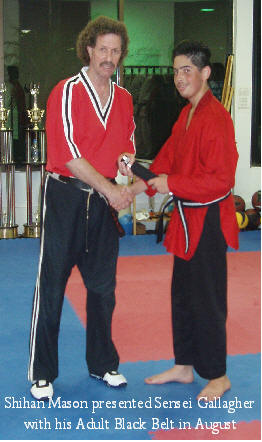 |
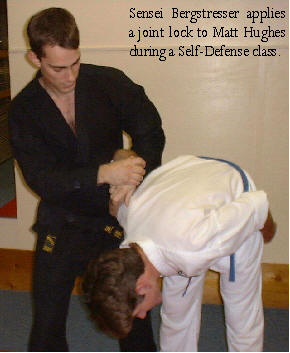 |
|
Learning Through Cooperation or Competition
Most of us are familiar with competition. Throughout our lives, at school, at work, or in sports, we have competed. For many people, the way that they perceive "getting ahead" in life is through successfully competing with their peers. One of the problems with competition, however, is that when you beat someone at something, they usually experience being beaten. That is, if you win, they lose. It is often the case that the experience of losing in competition is much more frequent than the experience of winning. This losing experience can be very unpleasant leading a person to become depressed or to completely withdraw from the activity in question.
Here at the Karate Institute, we encourage students to learn cooperatively. In basics class, when a fellow student is awarded a stripe, we should be happy for his accomplishment. It is not necessary to compare ourselves competitively with our classmates. During partner practice, work with your partners to achieve the purpose of the practice and the best results for your training. Stay on task so that you can both benefit as much as possible. It is never appropriate to compete against your partners or to try to gratify your ego at their expense.
In Kata, always strive to be the best that you can be. Admire the form of those who are better than you are, and model your practice after theirs so that you can improve. At the same time, be of assistance to those whom you are able to help.
Sparring is one of the most difficult areas to address cooperatively; yet, it is the best way to spar. Sparring cooperatively means staying, all of the time, within the meaning and intent of the sparring rules. It means never striking with excessive contact which might injure or intimidate a training partner. Cooperative sparring is about being able to work within the limitations of a smaller, weaker, or less-experienced partner, for optimum mutual benefit. It also means having respect for the reserve and control exercised by a bigger, stronger, or more-experienced training partner. Sparring in this way allows your partners to give you their best match. It allows you to work to deal with their most proficient techniques. It also allows them to test you with techniques they would consider too risky to try if you were going to nail them hard. Even the best students can be appropriately challenged by less skillful partners provided that this etiquette is observed.
By training cooperatively, rather than competitively, everyone can leave the Dojo after class feeling like a winner. It is in this way that students can develop intrinsic motivation to train, rather than being dependant on external motivators like stripes and belts for rewards.
Shihan Robert H. Mason ©2008
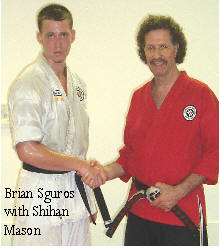
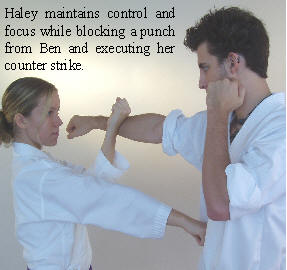
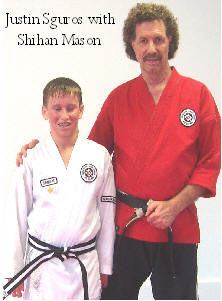
In Memoriam
July this year was tinged with sadness for our Dojo with the tragic death of Lillian Gallagher, following a fairly minor routine surgical procedure. Over the many years since she first signed up her son Brian for lessons, she was always a super supportive parent, assisting at tournaments, and always a happy and smiling ambassador for my Dojo. She would chat with new parents about all of the reasons why our Dojo was the right place to be. She had trained for a while herself in the Kickboxing classes, and was looking forward to continuing her training following her surgery. Sadly it was not to be. I appreciate all of the support that my staff, instructors and the parents of the Dojo have offered to Sensei Brian and his father Jimmy during this difficult time. Both Miss Jackie, Miss Suzie and Sensei Lauren Houser have been making every effort to be supportive in many practical ways, and I want to acknowledge their efforts on behalf of my Dojo.
I was able to attend the wake for Lillian in Hialeah to express my condolences to her family. I know that many of our Dojo members also attended. Having lost my own mother to cancer when she was about the same age as Lillian, I know the feelings associated with death coming too soon to someone still relatively young and very active. For my part, once the initial shock had passed, I was able to reflect on the many many positive memories I have of Lillian. Whether she was chatting excitedly to me, another student or another parent about the achievements of her son or other students at the Dojo, helping me load mats into the back of her SUV for transportation to my tournament, or complaining about the weather while huddled in her chair outside the Dojo during a cold spell watching Brian’s class, Lillian Gallagher was always good- humored and always smiling. Although many people enjoy a life of twice as many years, few seem to enjoy family life as much as Lillian did. Her family was the biggest part of her life and she was obviously dedicated as a mother and a wife. Even though she had a job, she always made provisions for Brian to be able to pursue all of his after school activities, including, of course, his martial arts classes.
To a casual observer her life may not seem to have been particularly special or important, Lillian Gallagher may have appeared merely ordinary to many people, but not to me, and I’m sure not to others who knew her well. I found her to be a person of principle and integrity, a realist who was also an optimist, who was staunch in her support of her son and her husband, wanting them to have every opportunity to achieve their potential for success in all of their endeavors, and the kind of parent who would not hesitate to let me know if she saw a problem at my Dojo that needed fixing. I often received e-mail from Lillian. Sometimes it was to say how well something was working and sometimes it was to let me know what needed to be fixed. Either way she was always assertive but respectful and obviously well intentioned, an easy combination of qualities for me to admire, and rare enough to make her particularly special in my eyes.
So, many of us will miss Mrs. Gallagher. Many of us will think of her often and remember her fondly. I know that she was proud of Sensei Brian's achievements as a martial artist. He is scheduled to receive his Adult Black Belt soon, and is close to earning his 2nd Degree Black Belt. For my part, I will honor her memory by doing my best to help her son, Sensei Brian Gallagher, achieve all of his goals in the martial arts as he continues to grow into the kind of young adult that Lillian, like any good mother, would be proud of.
Shihan Robert H. Mason © 2008
"Those who have lived out their days
have had a long life"
Zen saying
The Importance of Balance
In last months newsletter we published an article by Sensei Emily Snyder (see below). This month we want to follow up with an article Ms. Snyder wrote for our newsletter in 2001:
I am a sophomore in high school, and I have story to share that I feel is important. Though I am usually an A to high B student, I earned an F on a test a month ago. Though it was just one single test, my parents went on a "we must help our daughter study" kick, and, as I like to put it, took away my life and locked it up somewhere. I'm not allowed to use the phone or go out on weekends until school is over. My social life has been severely restricted, and my friends and boyfriend all feel neglected.
I'm also not allowed to go to Karate during the week. That means that not only is my progress severely impeded, but I have no time to catch up on necessary sleep over the weekend because it's the only time I can come and train.
What am I doing with all that time? Studying. I studied for six hours for the next test I had in the aforementioned class, two and a half of them the night before the test. I got another F.
I believe that my parents are truly doing what they feel is right. I'm not blaming their parenting, or their intentions. What I'm getting at is that during that week, there was no balance in my life. I would go to school and study for seven hours, then come home and study for another four. I was exhausted by seven o'clock, but kept studying right up until at least ten o'clock. I had no time to give my brain a rest, or do any exercise to stretch my muscles and get my blood flowing. I was also doing nothing creative, and creativity is the drive that keeps me going.
We hear about balance all the time when it comes to things like our diet. But balance is important in everyday life. If we do not take time to stop and rest, or do a little exercise, our busy lives will grow increasingly more stressful. Karate is a good way to take an hour out of the day to focus on something completely different. Spending time with family and friends, or just taking fifteen minutes of quiet thought or meditation are good ways to take some time out. Whatever it is, everyone should have a couple of ways to balance out all the facets of their lives.
Emily Snyder
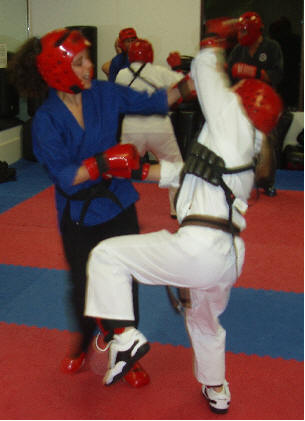 |
Left pic Sensei Snyder (L)
sparring with Laraine Winston for Laraines Black Belt test. Right pic Sensei Snyder stretch
|
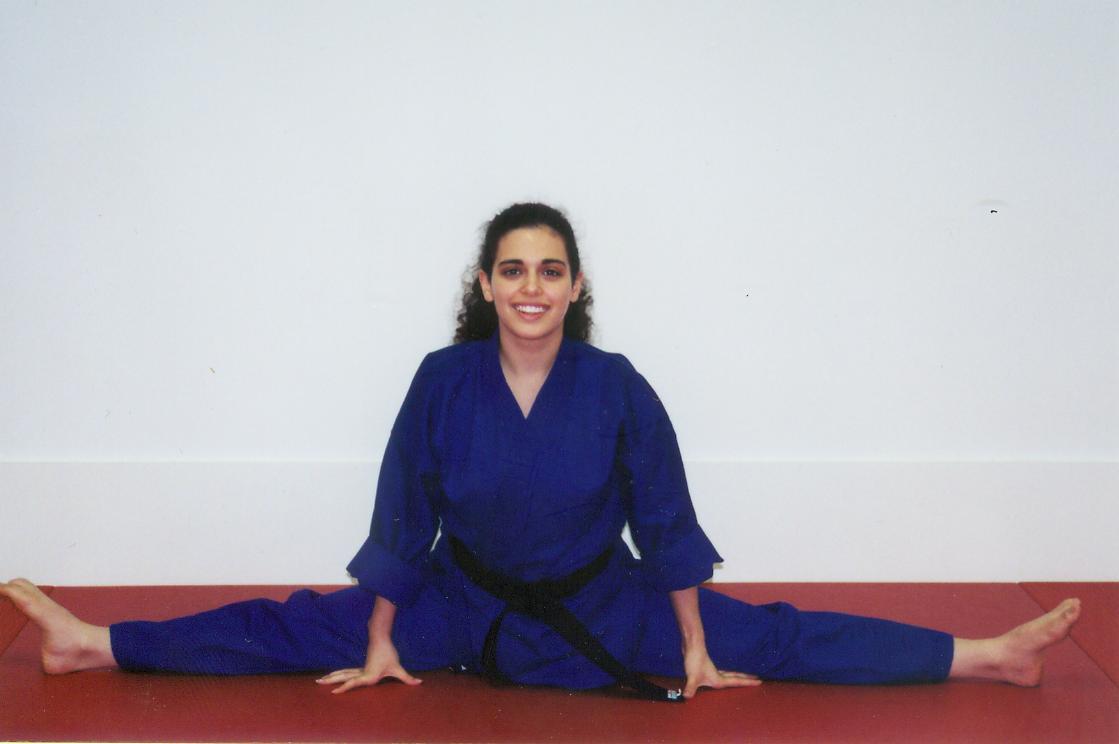 |
Respect- You Must Give In Order To Get
There is an old Chinese saying, “The stalk that carries the most grain, bows the lowest.” I think this carries into the martial arts philosophy in that most of the time, the best warriors of all, are usually the most humble. This follows a natural principle called “The Law of The Farm”. Everyone knows that a farmer plants his crop in the spring, works it all year and gets to harvest in the fall. This natural law is true in business, personal relationships and basically anything you want to achieve in life.
The truth is that you need to pay in advance, full price for anything you get. Many people are raised today thinking they can get things now and pay for them later based on the way our society has become, but in all important things, you must give first and then you get.
This is especially true with respect. Respect is something you must earn, not demand from others. Once you start showing respect to others, then respect will start coming back to you. In traditional martial arts, the senior students respect and take care of the beginning students as well as the senior students because they know that each position is very important in the overall scheme of things. The teacher respects the students, because without them, he would not have any position to teach and the students respect their teacher because they know what he is teaching is priceless and will change their lives forever. This mutual respect is the foundation of black belt excellence and what each martial artists should strive for.
Respectfully, Sensei Terry Bryan
My child complains about coming to class; what should I do?
Sometimes parents, especially the parents of very young children, mention to us that the kids complain about coming to class. The parents acknowledge that the kids like the class once they are there; yet they think maybe the child is losing interest.
In many cases, the child is not telling you they doesn’t like their classes. Often, they are demonstrating that they are “present focused.” At early stages of development, kids are not always able to project their thinking into the future, or weigh the potential for future enjoyment. For example, if you offer a young child a dollar now, or five dollars in a week, they probably will choose the dollar now, and the immediate gratification.
To deal with this, first of all, understand that the child may be delighted with the lessons, and still demonstrate this “complaining behavior.” Secondly, talk with your child… not when they are complaining, but at a later time. Explain to your child that you will no longer accept complaints about this commitment to karate… that if they have a specific complaint, they should speak to their instructor. By doing this, you are eliminating any complaining that is just complaining; at the same time, you give your child the opportunity to address any real issues.
Next, follow through! If your child complains again, hold up your hands and say, “Wait! If you have complaints about your classes, let’s set up a time for you to speak to Shihan Mason!” And when your child does come without complaining, let them know how much this pleases you.
Being firm and consistent will get good immediate results… and in the future, as your child matures, they will be better able to understand delayed gratification. Without perseverance nothing of real value can be achieved. In the process of self-discovery, that we achieve through regular practice in Mudokai Karate, there may sometimes be distractions, and at times frustration. With encouragement students can overcome these issues as long as the parents of our young students will persevere and help us to keep the youngsters “on task” towards Black Belt excellence.
© 2008 Shihan Robert H. Mason
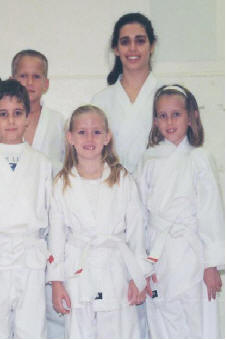 |
Alex Wood (center in the pic to the left)
began her training at the karate camp in 2002.
This year Sensei Alex Wood (on right) helped to teach at the camp.
|
A View From the Real World by Sensei Emily Snyder
A year out of college and into "The Real World," I find myself reflecting on my years as a Karate student, and how the Martial Arts have shaped who I am today. My training has influenced the ways I think and react as a rookie member of the adult club.
I live in Washington, DC, a city known for its living expense and its crime level. These factors obviously equal an inverse relationship between where you can afford to live, and how happy your mother is about where you live. Many of my friends feel uncomfortable in my working class, very urban neighborhood. Green glass litters the streets, and a woman gets honked at every time she leaves her apartment. One of my students, who lives in a suburb, referred to the area as a "ghetto." It's not, but it is a far cry from Plantation. In order to keep myself safe, I called on a part of my earliest Martial Arts training: How to not get attacked. Make eye contact, I remembered, and smile and nod. Don't look like a victim. But in seeking to become truly aware of my surroundings, I learned about all the great things my neighborhood has to offer; I chat with the teacher who gets on my bus when I do, and laugh at the boys racing down the street, pulled by a large and happy puppy. I've started training at the Kung Fu school that's only eight doors from my apartment. Most importantly, I learned what my friends often miss: When strange men make a comment, they're not moving in to attack me. They're continuing in their own direction. Karate taught me to make eye contact for my own safety. The skill has indeed kept me safe in dangerous situations, but it's also allowed me to see decency and innocence where I might have otherwise missed it.
To afford my newly acquired life expenses, I spend my days shadowing a fifth grader with Asperger's syndrome. The job requires patience and the willingness to understand a completely different mindset. My experiences teaching Karate and watching others teach it gives me the resources to reach all different types of kids, each on their own level. Because I've done it before, I better understand the need to say the same thing over and over in different ways, and I know when to be strict and when to be fun (and how).
I could even say that teaching Karate was the first thing that instilled in me the desire to be an educator at all. Despite other teachers I've had throughout life, it was the consistency and skill of my Karate teachers that taught me the true importance of a teacher. Outside of my university, UKC was the only place where I knew, beyond a doubt, that my teachers could control a classroom, respected their students, and absolutely knew their subject matter. To have teachers who still consider themselves students brings a level of honesty and integrity to a classroom that students recognize and appreciate, even subconsciously. An educational system that believes the title "teacher," Sensei, is a distinctive and hard-earned honor has given me some of the best role models for my new career path.
There are so many small things that have become so big, now that I think about them in a (slightly) more mature way: Drills have taught me that sometimes success takes many tries; slow progression is often the best way to develop a new skill; there really is value in a good push-up; the ability to defend oneself can translate into the ability to expand oneself. Perhaps best of all, Karate has given me a community that I can depend on. I know that, no matter where my new adult life takes me, I can always come back to UKC to visit with old friends and teachers and freshen up the skills that have taken me so far. Who knows where they will take me next?
© Sensei Emily Snyder, June 2008
|
|
|
|
Sensei Balzano Shihan Mason & Sensei Prasso Shihan Mason & Sensei Snyder
'It's pretty much just me pursuing a dream'
Sensei Max Balzano's love of fire companies began in preschool, when a field trip took him to a Florida volunteer fire department. "I was impressed by it," Mr. Balzano remembered. "I said to myself, that's what I want to do." Now 18 and a senior at St. Mary's High School, the Annapolis resident is a firefighter and emergency medical technician at the West Annapolis Volunteer Fire Company Station 40. "I like to be able to help people; I've always liked doing it," he said. "It's a great feeling to know that you made a difference in someone's life."
Mr. Balzano was 16 when he signed up at the fire department in January 2006. He took two summers of training - from CPR classes to Basic Firefighting, and most recently earned his certification to drive the emergency vehicles. "It's pretty much just me pursuing a dream," he said. Chief Robert Vice of Station 40, said he is always looking for high school students with an interest in volunteering. But with so many other opportunities available, most people don't join the fire department until they are adults. He said Mr. Balzano is the only high school volunteer he could recall.
When Mr. Balzano first showed up to volunteer, Chief Vice's first impression was "Just that he was young." Now, two years later, "He's a firefighter, he's got all the training," Chief Vice said. "He works with the team." "He's really involved in anything he does, he doesn't do it half way," Chief Vice said. "He just blends in with everybody."
While most days Mr. Balzano loves the time he spends at Station 40, there are those times when he wonders why he's there. It's especially difficult when he responds to calls concerning children in trauma. "When they're in pain and you can't do anything about it, it hurts," he said. Mr. Balzano recalled one day after he responded to a call concerning a cardiac arrest. He got back and wondered what he was doing. "Then I remembered, I tried to help this person; that's what I'm here for," he said.
Some weekends Mr. Balzano spends 24 hours at the station. Other weekends, he'll spend six to eight hours on a Friday afternoon and evening. While there, he'll respond to calls concerning everything from medical emergencies to fires to "helping Grandma off the floor," he said. "I'm gaining so much experience that I can pretty much take with me anywhere," he said. "I'm going to stay with the company as long as I can." As much as Mr. Balzano enjoys his work, he hesitates to recommend that his friends volunteer as well. "Only if it's something that they want to do; it's inherently dangerous, and you are putting your life on the line for somebody else," he said.
Before joining the fire company, Mr. Balzano earned all 32 of the community service hours he needed to graduate - plus 18 more - from St. Mary's High School by volunteering at the Caring Collection. "I've done arts and crafts in school, but I've never been able to work with stained glass," he said. "I also liked their mission, what they're giving money to." Mr. Balzano will graduate this May, and plans to attend Anne Arundel Community College and then transfer to the Fire Prevention Program at the University of Maryland, College Park, his mother, Jadwiga Balzano, said. Mrs. Balzano continued “Max has come a long way since he attained his black belt back in 2002. He credits his training at University Karate Center with successfully completing his training as a firefighter and EMT.” Max was honored for having completed the most service hours in the history of the high school (which started in 1946). The graduation requirement is 32 service hours. Max completed 1760 hours, mostly volunteering as a firefighter and emergency medical technician with the county fire department.”
Heather Roth, Staff writer for the Annapolis Capital. Published by permission
Boundaries: in Life, in Martial Arts, in the Karate School
Understanding where the boundaries are is fundamental to comprehending almost any situation. I have recently taught several self-defense classes, some at our Dojo and others at facilities like BCC and St. Gregory's school. Some of the classes were restricted to adults, while others were specifically for Girl Scout groups. One of the key concepts covered in all of these classes was the idea of “establishing and maintaining boundaries”. When someone approaches us in a way that we perceive as menacing or inappropriate we must establish a boundary for our safety. If we yell “STOP! BACK OFF!” while thrusting our palm heel towards their chest we define a boundary. Should the “attacker” continue to advance, we are under attack and must respond.
During my classes with the Girl Scout groups I talked about how their parents established boundaries at home, and how, while respecting those boundaries, they should recognize that they will be involved in ongoing discussions with their parents to redefine theses boundaries as they develop as young adults and assume more and more adult responsibilities. The point under discussion was, that while we must understand where a boundary lies at the moment, we must also be prepared to negotiate for recognition of a new boundary, based on changing circumstances. With children the obvious times for such discussions may be birthdays, i.e. “now that you’re eleven years old your bedtime will be 9:00 pm rather than 8:00 pm. Another obvious time would be at the start of a new school year, i.e. “now that you’re attending High School you could look for a part- time job on the weekends”.
In nature some boundaries seem absolute, though we are constantly striving to push them back. The space program is an illustration of this as we strive to explore beyond the confines of the Earth. What sometimes makes self-defense difficult is that the boundaries are not always absolute or obvious. Predatory attackers don’t always dress up as Ninjas and attack us with swords. More often they dress up to look like a harmless neighbor, then sidle up to us while we’re putting groceries in our car and try to abduct us without warning to do us harm. That’s when it’s useful to have some basic practical skills. Many of us saw the video a few years ago of a teenage girl in Sarasota who was abducted in broad daylight while walking home from a friend’s house. As she walked through a gas station the security camera picked up her attacker grabbing her by the wrist and dragging her off. An awareness of boundaries and some basic self– defense skills could have saved her life.
Shihan Robert H. Mason © 2008
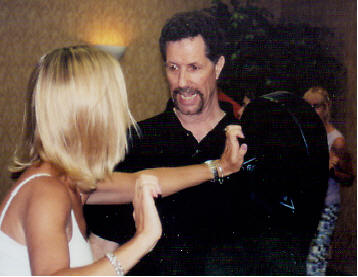
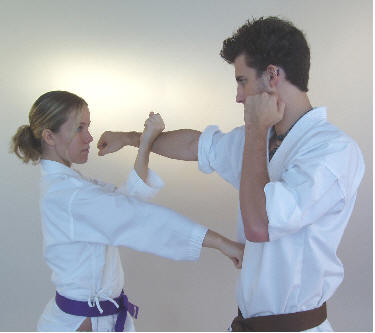
The Discipline of Helpfulness
I was recently teaching a class at St. Gregory's School where we use the music room for a class once a week. After class several of the children wanted to be helpful and put the chairs back in rows. This is typical healthy behavior. Children love to help, and it is this attitude of helpfulness that allows them to learn and develop. Young girls often want to help their mother in the kitchen and boys often enjoy helping their dad in the yard or around the house. That is part of the reason that family traditions tend to continue from one generation to the next. Whatever your family traditions may be, an attitude of helpfulness is very positive. Throughout our lives we have an opportunity to live within this discipline. Helpfulness can then extend beyond our family and local community to the larger community which we share as human beings.
In terms of our Martial Arts training we have many opportunities to be helpful. When practicing with a partner in class we can help them, for example, by providing the correct attack for them to practice their prearranged defensive technique. When students get off task they not only waste their own training opportunity, they also waste the opportunity for their partner and their Sensei. This lack of discipline can even be dangerous. About twenty years ago three of my students thought that it might be helpful for them to meet at one of their homes to spar together. Unfortunately, outside of the discipline imposed at the Dojo, they managed to damage each other sufficiently that they learned never to make that mistake again. What is helpful is when talented students with good self-control attend sparring classes and can mentor beginners in our sparring program. They do this by moving around with them and encouraging appropriate controlled action, while working on their own counter-fighting techniques. This is how students can learn how to spar without getting damaged.
When a new student signs up at the karate school one of our tasks is to explain the rules of the dojo (training hall). In addition to bowing at the door of the training hall, it is also necessary to refer to all Black Belts as “Sensei”, a term of respect that basically means teacher. This discipline is helpful because it encourages respect which reinforces the value we place on safety. A respectful student tends to be a safe student.
In order to keep our office focused and keep everything running smoothly cell phones are not allowed to be used in the office or the Dojo. With cell phones in use so widely it is helpful for us not to have to compete with them in our office space. In many ways a Dojo is like a church or temple. The discipline that we practice is best performed in a collected state without unnecessary distractions. It is also for this reason that parents and other visitors are required to watch from outside. Keeping an atmosphere of quiet, focused concentration can be quite challenging, along with maintaining the privacy of our students and parents while we discuss confidential matters, either in person, or by telephone. Many of our rules may seem overly strict, but there is a reason for everything. Martial arts is different from other sports; etiquette is very necessary to keep our space safe and organized and the discipline of helpfulness is most appreciated.
Shihan Robert H. Mason © 2008
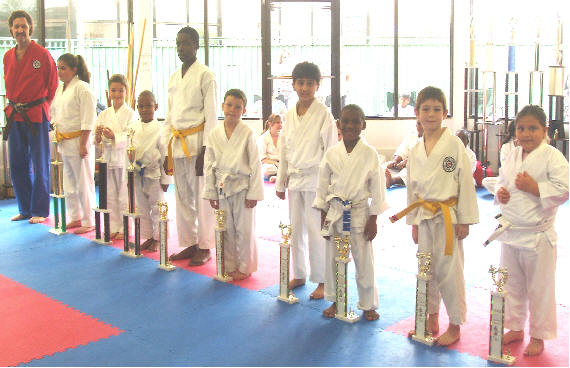
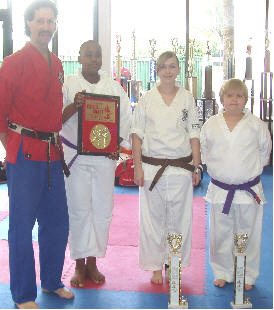
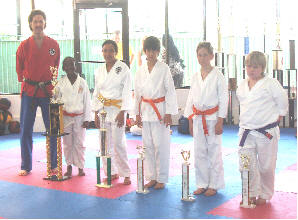
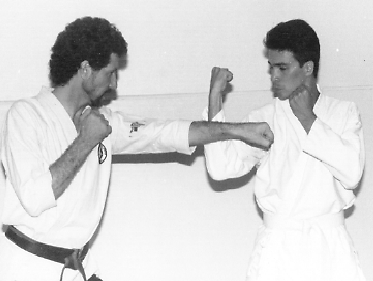
Leaders Lead Rather Than Dictate
One of the principle qualities for which a Martial Artist should strive is the quality of leadership. However, leadership ability is not a talent that can develop in a vacuum; it comes from the internalization and practice of other qualities. Sun Tze, the ancient philosopher and tactician said, “leadership is a matter of intelligence, trustworthiness, humanness , courage and sternness.” To be a leader does not mean to boss others around, to be obnoxious or impolite, but rather to exude confidence in yourself and demonstrate the qualities which Sun Tze recognized so long ago. It is not enough to be proficient in one aspect of leadership while ignoring other elements that are involved in being a leader. The ability to lead - that is getting others to follow you - comes from a careful balance of all the essential qualities of leadership. There are plenty of people who are very intelligent, and an equal number who are confident and courageous, but only a very few who can temper their courage and intelligence with trustworthiness and compassion. These are people who don’t just dictate, but lead.
As stated before, being a leader means that others have a desire to follow you in the things that you do. In the words of Confucius “there is a good leader when those who are near are made happy, and when those who are far are attracted.” As you develop your leadership skills, you may find that you are not the natural leader in all aspects of your life. Being a leader does not mean that you always have to lead, but that you have the ability to lead when necessary. In fact, one of the principle aspects of leadership and intelligence is a quality that lets you know when it is time to lead, and when it is time to follow.
Practice being a leader everyday. Learn and practice your Martial Arts techniques diligently so that you can demonstrate excellence, keep your word to your friends, family and fellow students. Show compassion for new students or others that might be having a harder time learning than you do. Give it your best shot to be the best. Be the first to raise your hand when your teacher asks for volunteers and always be eager to demonstrate for your Sensei when asked to do so. Practice diligently on a daily basis and you will soon find that others will try to emulate you, to be like you. When people want to copy you, to follow your lead, you have become a leader.
Students are encouraged to work on their leadership skills by enrolling in the Sempai Program. Sempai are members of the Black Belt Club who have reached the rank of Purple Belt or higher and want to learn how to help as assistants in class. Sempai must follow certain rules to maintain their status and receive a grade on every class that they help in.
After achieving Black Belt students may wish to enroll in our Teacher Certification Program. The first step is to be a graduate of the Sempai program. After that Shihan Mason will set up a schedule for apprentice instructors to build up their skills and experience. Seminars and Certification Clinics are offered throughout the year so that instructors can achieve ever higher levels of competence as teachers. Martial Arts training at UKC offers students of all ages opportunities to achieve, maintain and improve their skills as leaders through our leadership training programs.
Shihan Robert H. Mason © 2008
A Purpose Within a Purpose Within a Purpose
Students and parents sometimes ask me how I feel about karate tournaments. They wonder whether or not it is necessary to compete to progress in karate. Let me offer some insight into the sport of Karate and how it relates to Martial Arts (MuDoKai).
Some students do well in tournaments and have fun, while others are less happy with their performance. Florida enjoys a very high standard in Martial Arts, and competitions often attract the best practitioners from the schools around the state. Not all events are well run and not all officials do a good job. Sometimes opponents are not well controlled. All of these possibilities lend an element of reality to tournament sparring in particular, that can make it more like a real fight than it is supposed to be.
In addition to the positive media attention that results from tournament success, the sport aspect of Martial Arts also serves to inspire some students in their training. Sometimes the goal of entering a competition in Forms or Sparring encourages a student to train harder and more frequently with the result that their practice improves. Motivation is a major factor in the training regimen of most students. If tournament performance inspires good training habits, it is obviously a plus.
While the UKC students, who choose to compete, generally do very well, the majority of those who train here never enter a tournament. Much of the training that we do for self-defense does not have a legal tournament application, being too dangerous to be permitted in a contest; and we are not specifically a tournament oriented school. Beyond the sport and self-defense applications of Martial Arts principles, the deeper purpose of the MuDoKai style is in training for personal growth and development. To quote from the Tao Te Ching (Lao Tzu), “He who overcomes others has force he who overcomes himself is strong.” The idea of learning to overcome, or be in control of oneself through Martial Arts training, provides a major reason for students to continue to practice, even beyond the Black Belt level.
When students first begin to practice MuDoKai, they learn strong physical techniques. By learning to control their own bodies they learn how to control the bodies of opponents. At the intermediate level, they learn to control their emotions, not by suppressing them, but by achieving balance. When you can control your own emotions, it becomes possible to control the emotions of an opponent. Moving to the Black Belt level, the students begin to understand how to control their minds. This leads to the possibility of controlling the mind of an opponent. When there is no opponent, this level of complete self-control has the effect of developing a confidence and inner strength that leads to a state called Wa-No-Michi or the Way of Harmony. This inner experience, which grows daily with practice, reflects the deeper purpose of Karate-do (the Way of the Empty Hand).
© Shihan Robert H. Mason 2008
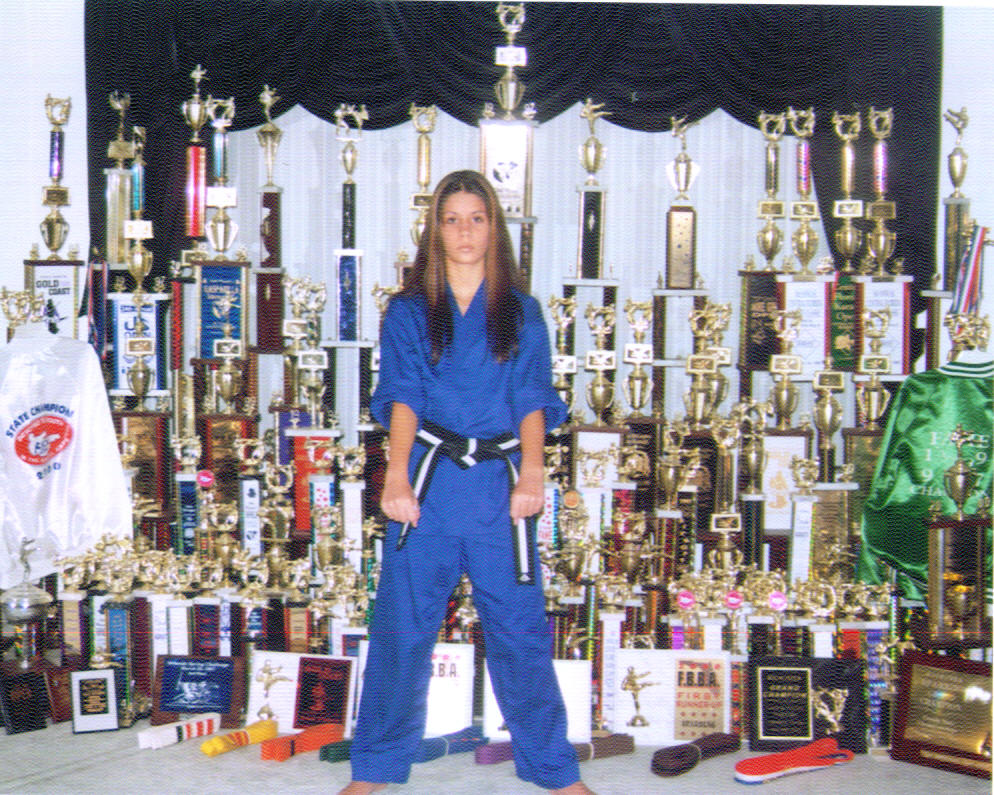
Sensei Brigida with some Trophies
A Winner Never Quits
Allowing children to quit before they reach their goals, is a course of action that some parents unfortunately take these days. It seems a convenient way out for those parents who do not want to struggle with the challenging behavior of a child who does not want to follow through on what they have started. Not all learning experiences in life are easy, and some children may rebel when they are required to confront what may seem to them to be a very challenging situation.
Unfortunately, what we teach children when we allow them to quit something that they have started, is that quitting is okay. We send a message that quitting is acceptable and that quitting is a viable option. This is not a good lesson for life.
In the movie Apollo 13 there is a scene where the Mission Control Coordinator has to figure out what to do in response to the Apollo capsule malfunctioning in a way that will prevent re-entry into the earth’s atmosphere. Unless the ground crew can accomplish what seem to be impossible tasks, and solve the problems that face them within a very limited time frame, all will be lost. What did the person in charge tell his anxious and flummoxed staff? To quote the movie, he said that “failure is not an option”. This man was not a quitter.
Many years ago a junior student had been given three red stripes on his belt and was ready to test. The child was given his paperwork stating this and then a very strange thing happened, he told his mother that he had lost interest and that he wanted to quit karate. He was actually just scared to take the test. His mother let him quit. At the same time another student had also been given his third stripe and was ready to test. He also wanted to quit but his mother insisted that he finish what he started and even paid for a set of lessons that would take him through the testing date (his membership had expired one month before the date set for graduation) so that she could support his following through to his goal, achieving the belt that he was ready to test for.
The different between these two similar situations is crucial to the development of each child’s character. In the first instance the mother allowed her child to quit before he completed the process of graduating to the next belt, thereby ensuring that quitting became an established habit. He subsequently carried this habit into his teenage years when he also quit high school despite being a gifted student.
In the second instance, the mother used her parental influence to insist that her child complete what he started, so that child not only took his belt test and passed it, but went on to achieve Black Belt, having faced the challenge before him with appropriate parental support and guidance and succeeded despite his performance anxiety.
Not everyone will necessarily train in karate throughout their life, though some students will. Most students however can achieve the goal of Black Belt. We are a Black Belt school. Aim for your goals and practice hard to realize them and you will succeed. Just because you are afraid of having to perform, or otherwise feeling foolish or humiliated is no reason to give up. You can succeed with a winning attitude, and your Sensei will help you gain that attitude with the assistance of your parents bringing to your classes.
© Shihan Robert Heale Mason 2008
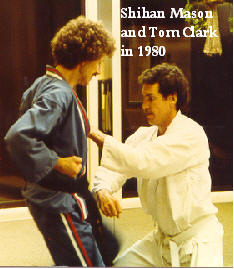
On Becoming a Master
“Everything that has been achieved is merely a preliminary exercise for the achievements to come, and no one-not even one who has reached perfection-can say he has reached the end.” This quote from Eugene Herrigel touches on an important theme for martial arts students. The experience of perfection, or completeness in martial arts, often only occurs after many years of practice and thousands of repetitious movements. Sometimes, however, it can be experienced by a complete beginner. Herrigel wrote “Zen in the Art of Archery,” and years ago I remember taking a girlfriend to practice archery with me. I showed her how to draw the bow and loose the arrow. Her first shot went straight to the center of the target, the gold. I was thrilled, as she was, at the experience of everything going “just right.” The moment was complete, perfect. Of course, this joy of the novice at a flash of perfection, while wonderful, does not mean that mastery has been achieved. Mastery requires consistent high level performance over time.
Repetition often leads students to feel bored. Getting just as excited about a punch or kick on the twentieth repetition, as you were on the first attempt is often difficult. Repeating the move for the five hundredth time is often a rote performance, containing little of the zest, intensity and quality necessary to achieve perfection. Yet, only after many thousands of such excellent repetitions can the move become so smooth, relaxed, reflexive and energized that it feels perfect.
Within the Mu-do-kai curriculum, I have done my best to disguise the repetitions. I have placed the fundamental exercises into different contexts at each belt level, in order that the students may see them with fresh eyes. I understand that new gold belts usually think that when they can roughly get through Pinan Nidan, that they “know” the Kata. These students find it incomprehensible that a Black Belt student, having been many times a champion, is performing the same Kata now, as he attempts to win his next title, as he was when he won his first. What is more, he is getting the most out of it now, and performing at the highest level. For Black Belts, this is the way to mastery, not just of karate, but of themselves.
Remember, knowledge is the result of combining the correct information, with correct practice, over time. A while ago I read Chuck Norris’ book The Secret Power Within. I have met Chuck on several occasions and found him very likable. He did not seem particularly scholarly, although I have always been impressed with his achievements as a martial artist. The book is excellent and probably much easier reading than most of my newsletter articles. I recommend it to all students and parents as a work of quality from a contemporary American Karate Master. Sometimes just a glimpse of perfection can be sufficient inspiration for us to pursue knowledge. Chuck’s book provides “Zen solutions for real problems” in a very “reader- friendly” way.
Shihan Robert H. Mason © 2008
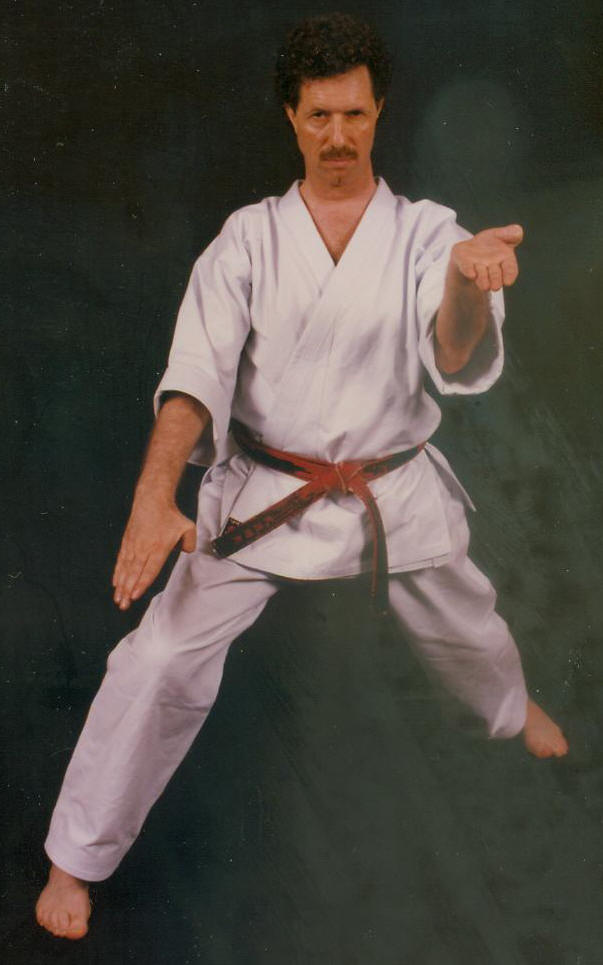
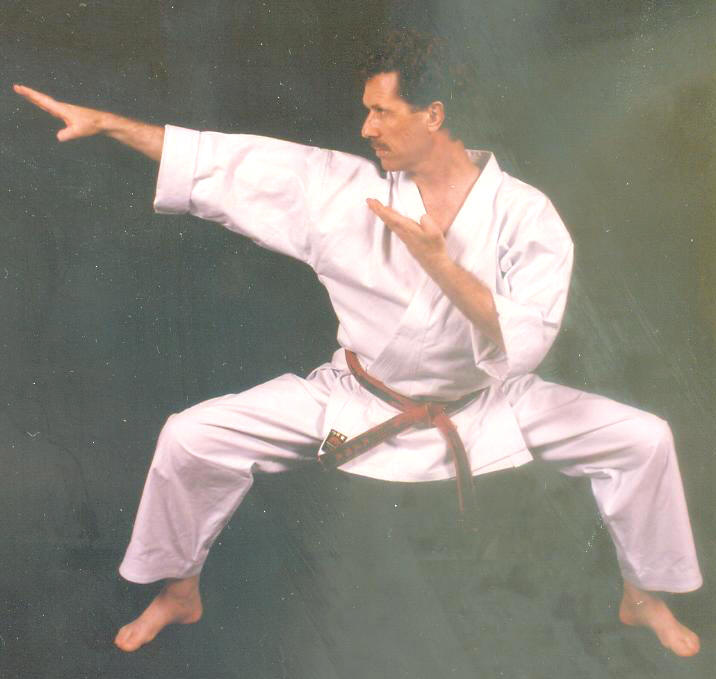
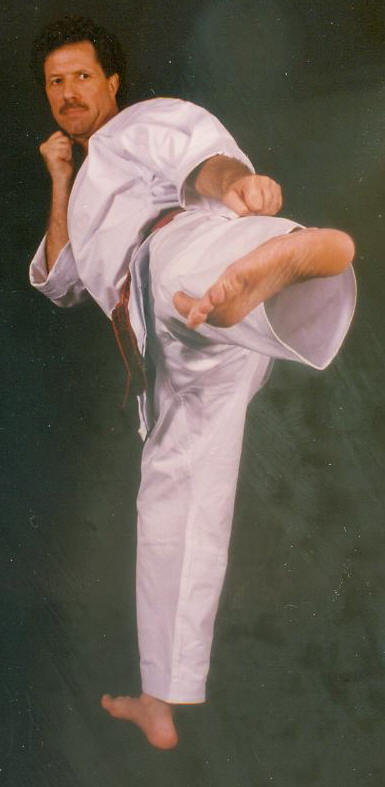
Six Steps for Successful Belt Exams
When you are striving for your next belt, or training for an advanced Black Belt exam, the preparation can be nerve-racking, but with some simple steps, you can prepare yourself for a successful graduation. Every class that you attend offers you an opportunity to improve. You will always need to work on your general ability in terms of fitness, agility, balance, flexibility and coordination. Additionally you will always be paying close attention to your skills in the particular areas addressed by the curriculum for your rank.
1. Basics and Combinations – Make sure you have practiced and that you know your basics. You should also rehearse your combinations until you can do them repeatedly without missing a step.
2. Attitude – Realize the value of a positive attitude. You must always strive to impress your Sensei with your winning and positive attitude.
3. Kata – Practice your kata, and take time to perfect each move, within the context of each combination of moves. Visualize the whole routine.
4. Self Defense – Again, during routine practice, you should practice your moves and make sure that you understand them. Stay on task in class and be sure that you are are doing all of your pairs techniques properly. Ask the Sensei if you have any questions so that you can be sure you are practicing correctly.
5. Energy Level – Make sure you are well rested and have had a high-energy, healthy snack (fruit, granola bar, etc.) before going to the Dojo. Keeping your energy level high will ensure that you perform to your highest potential.
6. Focus – Focus is extremely important. As all Martial Arts experts know, the body cannot work alone. To maintain focus means keeping your mind sharp and concentrating on the task at hand.
“Fortune favors the prepared mind”, so prepare yourself using these steps before your graduation, and keep them in mind while you are in the learning process. This will make your journey to Martial Arts Excellence a consistently rewarding experience.
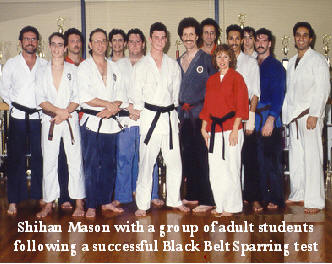
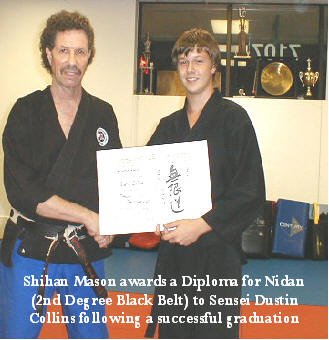
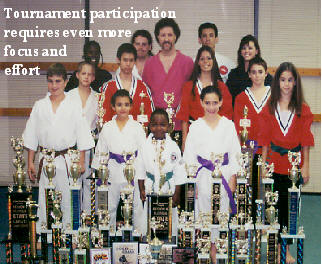
Developing a Winning Mind-Set
When we are learning anything it is fundamentally important to develop a winning mind-set. While it is often assumed that “superior ability” is a key to success, over thirty years of research has indicated that an overemphasis on “talent” or “intellect”, along with the implication that these are fixed, innate traits, leave students feeling fearful of challenges, vulnerable to failure and unmotivated to learn. All of the research indicates that our abilities are not fixed and can be developed and improved upon throughout our lives. Even geniuses and the most talented people have to work hard and persevere to accomplish their goals. What we endeavor to teach students at the Dojo, is the “growth mind-set” that asserts that abilities are developed, intelligence is malleable and that, with persistent hard work, skills will improve and problems can be solved. In short, students of Mudokai learn how to learn, and develop the learning skills that will enable them to use this mind-set to utilize hard work and their love of learning to work towards success in all of their endeavors.
When people have a “fixed mind-set”, they get upset every time that they make an error. They “feel dumb” perhaps because they could not perform the move the Sensei showed them. This attitude leads to a lowering of self-esteem and will likely be reflected in their job, at home, or at school in the case of young students. One of the benefits of training in Mudokai is that we can address this issue directly. All students are encouraged to see the acquisition of skills and techniques as something everyone can learn. Our curriculum is designed so that all new beginners will be able to learn the blocks strikes and kicks through the process of instruction, practice, correction and improved practice. As students achieve higher ranks and learn more advanced skills they realize more and more that, just as they can improve their balance, flexibility, strength, agility and fitness through persistent effort, that same effort applied to their job or their schoolwork will allow them to improve their skills in those areas. A major consequence of the development of a “growth mind-set” is improved confidence. When we realize that we can learn anything we set our mind to, and achieve results by virtue of hard work and effort, we see any errors we make as useful feedback that will allow us to hone our skills. We see the development of new skills as a challenge, to meet with energy and enthusiasm. Because Mudokai training is so technically specific, the Sensei can offer praise for the students accomplishments at every stage of the development of each new skill. By focusing students on the actions that lead to success we can foster motivation and confidence.
One of the challenges that we face as we grow older is the maintenance of our “growth mind-set”. Sometimes a major setback in any area of our life can lead us to become discouraged and depressed. It is not hard to notice when this has happened to a person because they will demonstrate the symptoms of the “fixed mind-set”. They will ruminate about failures and denigrate their skills with statements like “I’ve never had good balance” or “I can’t do this, I give up”. To meet this challenge the Sensei will address the mind-set by breaking down a technique into the steps that will lead to success, while reassuring the student that struggling with the challenges posed by learning a new skill are an important part of the fun we can have as we practice that skill. Learning stimulates neural connectivity in the brain at all ages.
© Shihan Robert H. Mason 2008
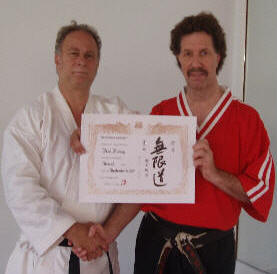
Sensei Neal Fleisig receives his advanced Black Belt Diploma (Nidan) from Shihan Mason
Sensei Neal Fleisig: Supporting the Dojo
In 1982 when the University Karate Center moved into its first permanent studio space Sensei Neal Fleisig had already been training with Shihan Mason for two years. Having trained in Japan and received his Black Belt in Shorin Ryu Karate prior to beginning to train with Shihan Mason, he was on hand to help out with teaching classes as soon as the school opened. Shihan Mason was teaching a full schedule of private lessons at the time, which meant that he was frequently out of the Dojo. Sensei Fleisig, who is also a Psychologist, was able to step in and teach classes at a critical phase of the Dojo’s development.
Sensei Fleisig is a “Board Certified Behavior Analyst. He is also trained in cognitive-behavioral therapy and biofeedback techniques and has worked as a clinical therapist. Mr. Fleisig serves as a consultant to hospitals, schools, and community based facilities that work with individuals who exhibit severe aggressive and self-injurious behavior.”
In addition to his training in Shorin Ryu and MuDoKai Mr. Fleisig is an accomplished student of Tai Chi Chuan, and taught this class at the Dojo for several years. “These combined experiences have provided Mr. Fleisig with a unique blend of highly refined skills in body mechanics and movement. In addition, his training has resulted in a heightened sensitivity to issues that emerge when one individual physically intervenes with another.”
One of the hallmarks of Professional Crisis Management is that it “does not involve the use of pain to control or de-escalate aggressive behavior. All of the procedures in the system have been carefully developed and selected so as to avoid joint manipulation or awkward positioning. Professional Crisis Management procedures are eloquent in terms of body mechanics and are all physically "painless." Nevertheless, the procedures are powerful and effective and sufficient to contain and control even the most dangerous behaviors.” For additional information visit www.pcma.com. Shihan Mason wishes to thank the Professional Crisis Management Association for their contribution to this article.
© Shihan Robert H. Mason 2007
Sensei Carmine Downey: Supporting the Dojo
Sensei Carmine Downey, 5th Dan in MuDoKai Martial Arts, trains field agents in self-defense for a major government agency. He began training with Shihan Mason as a teenager prior to serving as a Green Beret. In a recent e-mail to UKC, Sensei Downey outlined the limited training opportunities available to his family in Kentucky where he is now based. He noted that “the more I see the poor quality of programs, the more I appreciate the high quality of UKC. Either the instructors here are sub par to our standards, or the good ones have a very limited, or no children’s program, and are struggling, teaching in a gym, someone else’s school or just a poorly equipped facility. The irony is the locations that are booming here are of course the TKD which often have amazing facilities, or the two MMA/BJJ/Muay Thai gyms that have fight teams (with very qualified instructors I must say) but not what I want in a “family facility”. Ironically there is only one Judo school, which does have several top flight instructors, but is more a club with limited hours. “
“Keep doing what you are doing, and “stay the course” as the school is a great asset to the community and the next generation, both as martial artists and as people.“ Thank you Mr. Downey.
© Shihan Robert H. Mason 2007
Building Student's Confidence and Competence
I want to request that parents to cooperate with me in giving our students the space that they need to come to class and train. I know that parents are sometimes anxious about the progress of their children and believe that “being there for the kids” means physically accompanying the child as they enter the academy, helping them with their attendance cards, taking them to their Dojo and even putting away their shoes.
At the karate school we teach children self-discipline, self-confidence and self-esteem as part of our program of personal growth and development by letting students learn how to do these tasks themselves. The Junior level is distinguished from the Dragons and Tigers by the degree of independence that we expect from the children.
For example, in the half-hour Little Dragons class the staff fills out the attendance card for the child and the parents are allowed to bring the child into the facility and to shepherd the child to and from the classroom, helping the child put away shoes if necessary.
In the forty-five minute Junior class the child is expected to be capable of doing these basic tasks, or of learning to do them, on their own. As parents and educators it is important that we all work together towards a common goal: providing opportunities for the children in our care to learn how to be self-sufficient.
Abraham Lincoln was once quoted as saying that “we don’t help others when we do for them what they could and should do for themselves.” At times people are confused about how children learn competence and confidence and how this relates to self-esteem.
Nathanial Brandon, who is the author of several groundbreaking books on self-esteem, is very precise when he defines what contributes to building this attribute in children. He believes that the two most important components of self-esteem are self-respect and competence. When a child is shown respect by the adults in their environment, they learn to respect themselves. When children are allowed to learn how to take care of themselves, they learn competence. In order to learn competence a child needs to be able to make mistakes, to try something and fail, and to be permitted to struggle with difficult tasks on their own terms, without being rescued prematurely by a well-meaning parent, adult or older sibling. We can not learn for them. They must learn for themselves.
Children can pick up on adults’ anxiety and learn to fear “failure”. Their natural ability to learn, which is fostered in a relaxed environment where trial and error is nurtured and encouraged, is shut down under the well-meaning guise of parental protection and involvement. Self-esteem is based on, and built through, learning how to be competent in life skills, according to Dr. Martin Seligman, a leading pioneer in the field of competence and depression. He says that we teach our children to be helpless when we prevent them from learning life skills, whether technical, emotional, financial, physical or intellectual in nature, for themselves. As parents we can give our kids opportunities by placing them in structured learning situations (with appropriate supervision) and supporting them in their efforts to learn, by letting them go through the process on their own.
Seligman’s book “Learned Optimism” explores this topic in detail, with research and empirical data compiled through years of observing the American process of child rearing. As adults we need to make the proffering of “rewards” (praise is a reward) contingent upon the delivery of reasonable, correct behavior from the child. Self-esteem is best developed when the child actually learns how to do something correctly, and that happens only through the process of trial and error on the part of the child.
I encourage you to view our classes at any time through the windows. Many parents bring chairs to sit and watch their children train. Since the repair work is now finished on the roof of our neighboring building, the wood partition has been removed and we can once again enjoy the bright outlook, as well as use the parking lot to the rear of the center if we wish. This is a big improvement as I personally found the wood partition rather oppressive.
If you have a question for the staff or instructors or need to schedule an appointment or purchase an item, of course, you are welcome to come inside for those purposes. If you are concerned about knowing what your child is learning, you may choose to purchase a DVD of the belt material your child is studying for home viewing and practice, or you may decide to take class yourself as many parents do. Additionally, by bringing your child only a few minutes before the class time, and picking them up promptly after class, you can help us to maintain good order in the Dojo.
Moving forward towards 2008 I anticipate renewed growth in our program. We can once again commune with our neighbors at “Kiddie Ridge Academy” and enroll their students into our classes. The gym is scheduled to re-open in January. Big Lots will also be returning so that we will have more traffic past the Dojo. Meanwhile, I welcome any efforts that can be made by our current body of students and their parents to bring us new members. Since Sensei Smith moved to Naples I have been working with the young Sensei’s who have taken over her classes to help them develop their teaching skills and build on their experience so that they can lead our young members forward towards the goal of Black Belt and beyond. It is because I have the assistance of the senior Black Belts that we are able to offer over forty classes every week, seven days a week. Any students ranked Purple belt or higher who are members of our “Black Belt Club” may apply to be Sempai (class instructor assistants). Forms are available at the Front Desk. It is from this program that students can be selected for training as Instructors after achieving their Black Belts.
Shihan Robert H. Mason © November 2007
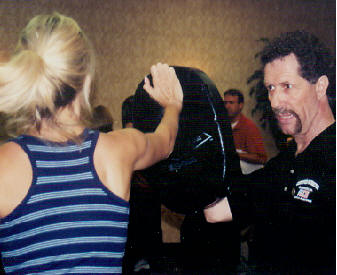
Finding Your Voice
The karate school participated in a self-defense course for the Girl Scout Jamboree in Hollywood recently. The classes for the girls included verbal defensive response skills as well as physical training. The girls were allowed to ask questions and many eagerly participated in the give and take of the sessions. Real-life examples of successful escape scenarios were used to illustrate the thesis that it is always better to resist capture no matter what. Part of what makes a predator back off and give up is when the proposed victim does not cooperate; but instead fights hard by yelling, punching, kicking. In one true incident that we related to the scouts the child who was abducted was only ten years old. She and her younger brother were forced into a car by the assailant; but she did not give up. She kicked, punched, scratched and yelled so loudly that the kidnapper let her and her brother out of his car after driving only one block as she was attracting so much attention. She told the police his car license plate number and he was arrested and prosecuted.
It was interesting to observe the differences in how the girl scouts responded to the drills in which they were instructed to participate. In the martial arts it is very important to exhale forcefully when executing a technique and to kiai (yell) when instructed to do so. Some of the girls had no problem with this; yet others were shy, and when asked to kiai were actually unable to utter a single sound, in spite of repeated attempts to encourage them. Even being in a room full of other girls who were yelling loudly did not incite them to make a noise or to breathe out. Consequently, in a real-life situation they might prove to be under-rehearsed and less likely to succeed in their defense. In Martial arts training it is crucial to teach students how to breathe properly and also how to find their voice. We practice similar drills in the Dojo at all levels of training and it is essential that students comprehend the importance of this practice.
While visiting the world-famous Hippocrates Health Institute recently in West Palm Beach I listened to a short talk by its Director Brian Clements, who has studied health and diet and exercise for over forty years. His speech was interesting and informative; it was surprising to hear him say that the most important element in recovery from an illness is the patient’s belief that they deserve to get well. Similarly, a young person’s belief that they deserve to be safe and strong is important in defending themselves in a close encounter with a potential assailant. “I am safe; I am strong” was imprinted on the front of the special tee shirts that Girl Scouts wore at the Jamboree and it makes a good motto for our young students too.
Martial Arts training gives students the idea that they can and should defend themselves, and provides a practical means for doing just that. They learn that they can feel safe as a result of the skills that they practice regularly in class and that they can be strong because of a training regimen that builds muscular, emotional and mental strength.
Shihan Robert H. Mason © October 2007
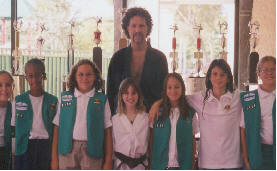
Shihan Mason and Sensei Shannon Harper taught a class for Girl Scouts at the Dojo
Dominance and Martial Arts Philosophy
Dominance, and issues relating to it, are a feature of life for humans and animals alike. Wolves fight to establish or maintain a dominance hierarchy, siblings fight over who gets to hold the TV remote control and spouses fight over who gets to spend the money on a new motor cycle, or a new high fashion outfit. Who is dominant is an issue for life. The struggle for dominance can be seen at the beginning of most of the Junior classes, when, following the warm-ups, we see the competition over who should stand where in the line; in spite of the fact that the students’ belts and stripes largely define the order. Everyone gets to take class, no matter where they stand in line. It’s not an issue worth fighting over, and yet youngsters will contend for territorial dominance in this instance.
Who is the boss? Who is in charge? This is often how we perceive who has the power in a situation. We don’t want to be bossed around. In a society where “the customer is always right” there is often the idea that the consumer of a product or service is “in charge.” In Martial Arts it does not work that way. The Sensei is in charge. He is dominant. The students, starting from the most senior among them, form a hierarchy beneath the Sensei, based upon their rank. Where that rank is equal, they are encouraged to be modest, humble and deferential towards each other. The real test of their ability to be respected as dominant, lies after all, in their ability to perform rather than push.
While Martial Arts teaches respect for everyone, it also teaches the importance of winning, of being dominant, where issues of real importance are concerned. Additionally, self mastery is held to be of more value than dominating others. Respect is a by-product of this dominance hierarchy. For example, if a lion cub does not respect a male lion, he may end up being hurt, or even killed. Similarly, if a person does not respect a judge in court, they may end up going to jail for their attitude of contempt. Judges rule in their courtroom.
We ask that all students develop a proper respect for the traditions of the Dojo, and remember that respect for property is a part of this. Training equipment, magazines, displays of photographs and even the paint on the walls are all part of the dojo, the place where we train. It is important that everyone who enters this special space shows the proper regard for both the space and each other. Attitude is a little thing that makes a big difference in this respect.
Shihan Robert H. Mason © 2007
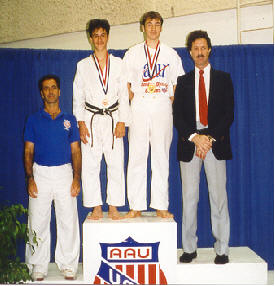
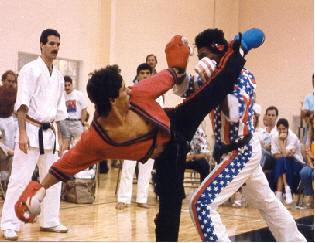
A New Start, A New Schedule
September is the start of the new school year, a time when parents and kids have to regroup to deal with busy schedules, changing schedules, and priorities. There is only so much time and energy in one 24 hour day so the question really becomes: what are the most important things that must be done each day. There are obvious choices such as school, homework, job, eating, sleeping and travel time; then there is what we do with the time that we have left, assuming that there is some leftover time. Often this is where things get tricky as this is the area that is not mandated and so this is the area of free choice, such as it is. This is where our values determine what choices we will make-an indication of what is truly important to us, where the rubber meets the road.
We all know of times both for ourselves and for others where we have heard someone, maybe ourselves say, gee I would really like to ________(fill in the blank), but I don’t have the time, money, energy, will power, whatever; however, as the saying goes, “where there is a will, there is a way.” The key issue is how determined is the person to reach that particular goal. Obesity is one of the biggest issues in America today. Diets abound, usually at least one a week that promises the impossible: lose weight while eating whatever you want, whenever you want. It can seem the same with martial arts: get your Black Belt in one year the quick and easy way. The truth is that to achieve Black Belt excellence takes time and hard work. It means making the difficult training a priority. It means working hard on a regular schedule to achieve a goal over several years, step by step. Rather than just wishful thinking, those on the path to Black Belt, and beyond, to self-mastery, are on track with real achievement. Before you can really know anything you must know yourself. Regular weekly practice of Mudokai Martial Arts is a path to this self-knowledge.
© Shihan Robert H. Mason 2007
“Martial Arts and Courage”
Courage is largely a result of confidence. Becoming a Black Belt requires courage. There is no substitute for the confidence you gain from working out and training in martial arts everyday.
Be brave. You can develop courage if you acknowledge your fear and then press on with your purpose. Be bold and welcome challenges. It is said that “fortune favors the bold”. A failure to achieve a specific goal is only a defeat when we don’t learn from the experience.
There are no shortcuts to success in martial arts. Success in martial arts, as in life, comes only through hard work and dedication to achieving our goals. Worthwhile accomplishments in martial arts are difficult. It takes courage to avoid what may sometimes seem like a shortcut to success.
To be a good martial artist, you must be willing to give a 100% effort all of the time.
Welcome situations which provide opportunities to perform under pressure. Only under pressure can you really demonstrate courage. A true martial artist delivers when the pressure is on.
Remain calm in adverse or hostile circumstances, and your courage will grow. Courage and confidence will inspire you to a level of achievement you didn’t think possible as long as you stay calm.
Courage is a quality possessed by Black Belt martial artists. It’s the quality that drives us to give that something extra when it seems like we can’t give anymore. It allows us to perform at our best, even when, in our mind, only perfection will lead to success.
Courage is a measure of our heart, and inner strength. If we meet an opponent who may be bigger and stronger, our inner strength and our heart can combine as courage to give us the winning edge.
We do not need to be intimidated by the prospect of failure. Courage gives us the confidence to do what it takes to be a winner. When faced with difficult tasks in life, bring the power of a courageous attitude to bear and they will surely yield.
Courage is the quality that you can carry throughout your daily life that will give you the confidence to be compassionate towards others and at peace with yourself.
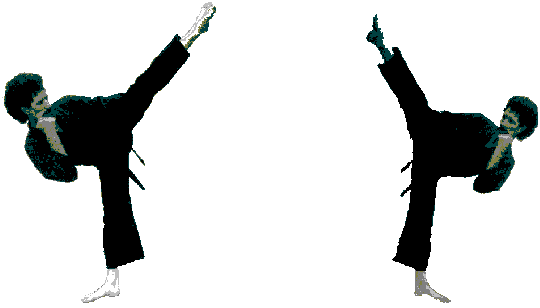
Sometimes our challenges involve “getting out of our own way”.
It can be a major challenge to find the courage to not fight against ourselves, and rather, focus our energy on meeting our challenges directly and coping with them confidently, assertively and compassionately.
What Does Martial Arts Teach?
One of the books I finished reading recently is “Infidel” by Ayaan Hirsi Ali. Without going into a review I just want to use an example of the difference she noticed between the Somali culture she was raised in, with the Dutch culture she adopted as an adult. In Somalia children are taught to strike out when they feel threatened, rather than only to strike in defense when they are attacked first. In Dutch culture however, Somali children living as refugees had to learn to “talk things through” rather than hit. Working as a translator for the Dutch authorities, Ali was involved with many situations where Somali parents had to have these rules explained to them. They were told that if their child persisted with their aggressive behavior they would not be able to attend normal schools, but would be placed in a psychiatric facility to address their mental disorder. Ali goes on to point out that Dutch civilization is peaceful and productive, as a consequence of this national policy of “talking things through, rather than hitting.” Somalia, on the other hand, has been torn by civil war and a succession of brutal dictatorships. Like Ali I would advocate for any civilized community adopting a philosophy of peaceful persuasion, rather than violent confrontation.
In talking recently to parents of new students some issues have come to my attention. Many parents are initially fearful of enrolling their children into our program. Usually this is because they have never had any experience themselves of a karate school before. Sometimes it is because they have had a previously negative experience with another school. Some karate schools at the present time, and many in the past, were set up on a para-military basis, with the goal of teaching students "blood and guts" fighting skills. Since I began teaching in Plantation in 1980 my goal has always been to make personal growth the major focus of our program. This is based in my belief that if students acquire their martial skills within a context of healthy physical, emotional and psychological development, they will derive the greatest all-around benefit. In the last few years in particular, martial arts studios around the country have finally begun to adopt the language of approaching martial arts in this fashion; however, the University Karate Center remains, as far as I know, the long term pioneer in this method of teaching martial arts to students of all ages.
It is often a good idea for concerned parents to come and watch a class first to see how we train. I appreciate the efforts that all the students make to refer clients to the school, and would encourage you to tell your friends and acquaintances about our program. We anticipate that "the proof of the pudding is in the eating" and that by seeing what we are doing, and by experiencing our program first hand, they will be convinced of its merit.
All students, but kids in particular, can use their martial arts knowledge to resolve conflicts peacefully, by talking rather than resorting to violence. The training gives them the confidence to be able to speak with someone who may be threatening them physically, rather than cave in to a bully’s demands, or lash out in panic as an untrained individual might. Since they have developed their practiced skills, they can remain cool calm and confident, while opting for the civilized solution. Essentially, Mudokai Martial Arts teaches practical peace.
Shihan Robert H Mason © 2007
Martial Arts Motivation
Studying Martial Arts is one of the most challenging and rewarding pursuits that you will ever encounter. Martial Arts proficiency requires many hours of hard work spent practicing form and technique. However, as you progress through the ranks, you will achieve a satisfaction that makes all of your hard work and dedication worth while.
At times as we undertake tasks associated with our many pursuits we might begin to feel discouraged. We need to step back and assess our situations so that we can find something that will help us remain motivated and better able to reach the great peaks of success.
Here are some mental steps that you can take:
1. Maintain a Positive Outlook
A positive outlook can greatly increase motivation and will help you to stick with your endeavors to their completion. Instead of focusing on setbacks try to consider the many benefits that you will gain with a "can do" attitude.
2. Keep your "Eye on the Prize"
Few things inspire as much as really great reward. Set a realistic goal for yourself (such as your next belt level) and work toward that goal. If your goals are realistic and attainable within a reasonable amount of time, they will better help to motivate you than unrealistic or distant goals.
3. Look at the big picture
While you are working each day to learn a new set of movements or forms, remember that the martial arts is a system that cannot work without each of its component parts. Each time you learn something new, try to see how it fits into the big picture.
4. Keep things in perspective
Maintaining perspective will greatly assist you in all of your endeavors. A small set back is not the end of the world. Remember that you are only limited by your own perceptions of reality. Inch by inch, it’s a cinch but yard by yard it’s hard.
5. Stay self-disciplined
One great way to stay motivated is to attend class regularly and participate fully in class activities. This will lead to an increased rate of learning and give you the tools that you will need for Martial Arts success.
Staying motivated is one of the keys to success in the Martial Arts and in your life. If you approach each of life’s endeavors with a high level of motivation and commitment, you are sure to succeed.
Important things to remember!
Martial Artists master their anger. Even though it may seem that things outside of us make us angry, in truth, anger comes from the inside. Our own views and fears are the source, when something happens that confirms our fears, or creates new ones, we feel strong emotions. Accept anger as a natural part of yourself, then, confront and master it. Anger doesn’t accomplish anything! Find a more productive way to resolve a problem.
Martial Artists respect others as themselves. Most of us have been taught to treat other people with respect, but we must also recognize our own need for respect and care. Spend time with people who treat you and others with kindness and remember to treat yourself with respect. Hold yourself to high standards and accept your own uniqueness!
Beyond Survival: Doing the Right Thing
Gerald Coffey, a former P.O.W. in Vietnam, has written about his experiences as a captured pilot at the hands of his enemy. One minute he was one of America’s military elite, flying a volunteer mission at high altitudes in a distant war, and the next he was injured and struggling to stay afloat while fighting for his life under enemy fire in the choppy seas of Indo-China, an instant transition of the most dramatic kind, a change of circumstances that was abrupt, life-threatening and permanent. Coffey wrote that he did not remember releasing his parachute, inflating his life raft or removing his helmet, all necessary survival procedures that he performed automatically, though unconsciously, after his plane was hit and he plunged into the ocean below. Years of military training had prepared him for just such an emergency and he was able to respond appropriately.
When civilians consider a situation like Coffey’s we can understand and appreciate the value of a military regimen because its benefits are so clearly demonstrated by his experience; however, when discipline and routine are applied in sports or in school it becomes another matter for most of us. We question it, and discuss it, we challenge it, yet we often ask for it when our children and our institutions get out of control. On the one hand, we identify with the challenges of the 1960’s which developed civil disobedience almost into an art form. On the other hand, we recall the orderliness and outward security that obedience seemed to offer throughout the 1950’s. Two very different concepts embodied in one generation, the “baby boomers”, who were born after World War II. This generation’s impact has registered culturally and politically and is shaping contemporary philosophical attitudes. So, how should our children be raised? How can we do the right thing? Can we be disciplined while living free lives?
Martial Arts is both a discipline and an art form. It is martial, therefore it lends itself well to regimentation, as does the military. It is an art, and as such requires the students to explore the mental and emotional aspects of themselves. Karate Do, the way of the empty hand, balances the right and left hemispheres of the brain by engaging the rational and the intuitive aspects of the mind simultaneously. This is the function of regular training in basics, strategy, and kata, essentially simple actions, that are developed through repetition and practice, to crystallize into a profound understanding. It is this reconciliation of discipline and freedom, of structure and creativity, that allows for the development of a mature integration of being. This self-knowledge develops a touchstone within, a capacity to do the “right thing”, and also the wisdom to realize the discipline of freedom through practice.
© 2007 Shihan Robert Heale Mason
Why are some kids so tired?
Years ago children were seen and not heard; bedtimes were set and honored; snacks were an occasional treat; mealtimes were regular; the family ate dinner together every night. Not so nowadays with parents’ busy schedules; unfortunately kids often lack the benefits of a regular schedule, especially with regard to bedtime. Here at the karate school we often observe kids with little energy in class. From our conversation with some of the children it seems that many are not getting enough sleep. While children are growing they need to get plenty of sleep. Small babies often sleep 20 hours a day, while toddlers will happily take a nap every afternoon in addition to 12 hours or more of sleep a night. Even after kids no longer need a nap, 12 hours a night is a good sleep schedule. Once children begin school there is a tendency for some children to stay up too late at night.
When I was growing up I went to bed at 7:00 pm every night and got up at 7:00 am in the morning until I was about eight years old. My bedtime was extended to 7:30 pm from age eight to ten and then extended again to 8:00 pm from age ten to twelve.
When I went away to boarding school, right before my twelfth birthday, I recall complaining in letters home to my parents that I was not getting enough sleep. Lights out was at 9:00 pm and we got up at 6:45 am, just nine and three quarter hours, rather than my usual eleven hours. Of course, I got used to the schedule which was extended again when I was about fourteen to lights out at 9:30 pm, which was my bedtime until I left school at age sixteen. This regimen allowed me to get through my growing years with plenty of sleep, and as a result plenty of energy for my daytime schedule.
From speaking to parents over the years I know that many children get up early for school and stay up late at night, often not getting to bed until after 10:00 pm, but having to get up at 6:00 am to get ready for school. This is why some kids are so tired. Some experts believe that hyperactivity in young children is related to them trying to stay awake; if they were not so hyper they would be sleeping. Ideas like “bedtime” and “lights-out”, and a recognition of the importance of sleep as an essential ingredient to good health, and a productive daytime schedule can contribute to the quality of the lives of children, allowing them to be fully awake during the day because they are getting enough sleep during the night.
© 2007 Shihan Robert H. Mason
“Be Still and Know”
As much as the movements involved in karate training are difficult at first, being still and not moving at all is sometimes even harder. When students line up to bow in at the beginning and end of class the command in Japanese is kiyotsuke, which is the military equivalent in English of “ATTENTION”. What this command requires is that students should stand up straight with their heels touching and their hands by their sides. Blinking and breathing should be the only movements discernable. While this exercise is very difficult, it is important that students should do their best to practice. Sitting in seiza (kneeling) also affords a similar opportunity to be still.
In music there are rests between notes and pauses between movements. In karate practice there are points of essential stillness within certain combinations and between techniques, that create the dynamic balance essential to the rhythm and timing involved. This is especially evident in kata practice, where a good rule of thumb is to pause for one second at the end of each combination, and for two seconds at each kiai. The more absolute the stillness at these times, the more effectively it sets off both the movements that preceded it, and those which come afterwards. Effectively, the message is, that in order to understand and benefit fully from movement, you must understand and comprehend the benefit of stillness.
In our everyday lives it is not just what we do that defines something of who we are, it is also a matter of what we do not do. Our search for self knowledge may be assisted by an awareness of how we do all of the activities that we are involved in on a day-to-day basis. This is the art of everyday life; a practice of being at one with ourselves in action. We can also benefit from investigating how we are when we do nothing; when there is no activity. How well can we be still and conscious and awake at the same time. Certainly in terms of a student’s progress in the Martial Arts, this is measured not only by their competence in action, but also by their competence at attaining and maintaining a state of stillness. I’m reminded of the motto of my Alma Mata, the University of Sussex in England, where I read (studied) Developmental Psychology; “Be Still and Know”. If you can practice enough to become truly still, the knowledge that arises from that stillness can be absolutely profound. As the poet and artist Genece wrot
e “Come to the place of stillness, a place of calm knowing, that carries you into the sanctuary.”Shihan Robert H. Mason © June 2007
Fashionably Fit For Class
Many sports have a special uniform that is worn by their participants. In the martial arts it is called a “gi” and consists of a karate top and karate pants, tied with a belt. The uniforms worn in the different styles of the martial arts each have their own traditions of “style” and color. In Goju a black uniform is worn, in Kung Fu a sash is worn with a looser fitting garment and in Tai Chi the exponents often wear shoes with a pajama-style “outfit”. Here at the karate school the uniform worn is a plain white jacket (sometimes a “logo” v-neck top) with karate pants (draw string or elastic waist) and a belt that indicates the student’s rank. Black Belts are permitted to wear uniforms with their own selection of approved color and style.
In order to train properly it is important to have the pant leg hemmed just above the ankle. This insures the student’s safety, so that they do not trip over their feet, and also gives a better overall look to the student’s appearance. In Japan students often wear karate pants hemmed to the mid-calf to keep them completely clear of the ankles for kicking.
A clean, wrinkle-free uniform is considered essential by none other than Sensei George Sfetas, who was my teacher when I was at University. Mr. Sfetas was famous for ironing his own uniform, a heavyweight Tokaido, and also for turning students away from class if their uniform was unsuitable, wrinkled or dirty.
So be “fashionably fit” for class by planning ahead. A second uniform is always a good idea, (one for the wash and one ready for class). Also, always remember after class to hang up the uniform (rather than stuffing it in a bag for the next time).
Martial Arts came originally from the Military Arts, where a well turned out, clean, sharp and complete uniform is always considered essential. Looking good in every respect is all part of our Martial Arts form.
Shihan Robert H. Mason © June 2007
Junior Black Belt Club Getting Conscious
F. M. Alexander was an out of work actor living in Australia in the 1900’s. He was out of work because he had lost his voice. Needless to say he was highly motivated to discover how this misfortune had befallen him and so he embarked upon a study of his habits by observing himself in the mirror as he rehearsed. One of the things that he noticed was that when he spoke normally nothing much happened; however, just before he began to rehearse he did three things; he tensed his neck causing his head to go back, he tightened his throat muscles, and he took a short deep breath. He called these observations “the manner of doing”; he then observed that he was doing these three things even when he was speaking normally, and that when he “tried harder” as an actor, they were simply exaggerated.
Athletes often have chronic physical problems because their actions, already out of balance due to the stresses and strains of modern living, set up ways of moving that cause excess tension and misalignment. Martial arts students often experience similar obstacles when they embark on a schedule of training. The patterns of misuse that were probably developed in childhood and already existed unbeknownst to them (perhaps a recurring backache, a trick knee, a sensitive shoulder) kick in, and their mental desire to train competes with their physical discomfort. The result is often inconsistent class attendance and less than satisfactory results.
When I taught the Junior Black Belt Class in April my theme was paying attention to how you do what you do in class, and also in life of course. The only training that really counts, that will lead to real progress, is the training that occurs when a student is aware of their internal state, and their external surroundings, while they are in action. How can we remember ourselves while we practice and perform? I recommend that students become more conscious, that they open up all of their senses. Begin by checking that you are breathing with your actions. Exhale as you extend and let the breath come back to fill your abdomen. Fix your gaze in the mirror if it is straight ahead, or on any point at eye level if there is no mirror.
Let your gaze be open to allow you to see all around using your peripheral vision. Be sure that your stance is relaxed but poised. Your back should be straight with the back of your neck extended, knees bent, your shoulders relaxed and your hands correctly positioned. Listen attentively to the Sensei in class. Outside of class be aware of all of the sounds going on around you. By tuning in to all of our senses we increase our awareness and become practiced at noticing what is going on. As a result we develop the awareness necessary for self-defense. Often it is by noticing that something is out of place or someone is acting strangely, that leads us to realize an attack is coming, before it actually occurs. Become physically, emotionally and psychologically poised. The way to achieve this state is to attend class regularly, be very awake and aware, and follow the directions of the Sensei.
Shihan Robert H. Mason © 2007
How to Stay Motivated to Train
While more people are exercising now than every before, still there are many who quit for whatever the reason. What can happen is that they get all fired up about their exercise program ; they start that program with a winning attitude only to discover that in a few weeks, or even sometimes days or hours, that their attitude has turned from winning to surrender. This lack of discipline to follow through on their commitment can undermine even the best of intentions. Discipline is the ability to carry out a resolution long after the mood has left. How can you stay disciplined and motivated enough?
1) Clearly define your short and long term goals.
2) Write down these important goals on a piece of paper and place it somewhere you will see it often every day.
3) Make another list of your plan for achieving your goals; such as mapping out a program that gradually increases your stamina, flexibility, agility, coordination and fitness. This might be along the lines of a training schedule at the Dojo three days a week, with additional practice at home on stretching and basic moves twice a week .
4) Make friends with someone at the Dojo who has similar goals to you and is the same rank. Make a commitment to follow each other’s progress, perhaps arranging to come to the same classes to support each other, then if your friend doesn’t show for class they’ll be getting a call from you to find out why. Similarly, if you slack off your Dojo buddy will be checking up on you to help you stay motivated.
Better Breathing Brings Peak Performance
Inhale, exhale, in, out. Breathing is one of the most natural function of our bodies. Or is it? In spite of its importance, many of us have developed shallow and uneven breathing habits. Effective breathing can make a measurable difference in martial arts performance and in every other activity we pursue.
When you inhale, or breathe in, the air you take in goes through a multi-step filtering process before reaching your lungs. Specialized lung structures extract oxygen and leach it into your bloodstream, where it travels to various oxygen-hungry tissues, such as the brain and the large muscles. This cycle occurs tens of thousands of times each day, unnoticed, until you really push yourself in martial arts class and discover how much work breathing can be.
With additional exertion, the process picks up speed trying to accommodate the body’s increased demand for oxygen and blood. The heart pumps faster, attempting to meet the demands of muscles engaged in high activity for oxygenated blood and the removal of waste carbon dioxide.
Regular deep breathing can allow the development of greater stamina, strength and mobility as well as greater mental focus, all of which are hallmarks of excellence in martial arts, but how can we achieve this? The first step to improving our ability to breathe involves exhaling strongly with every punch, block or kick that we execute in class. Step two is to notice our inhalation and to allow our stomach to extend as we breathe in. Your lungs will fill with air just as usual, but your diaphragm, the muscle mainly involved in breathing, will work differently from normal. This “belly breathing” is natural for babies and we need to rediscover this lost treasure. As you learn to breathe through all of your techniques in every class, you must next learn to take this skill into your life. Start by consciously exhaling whenever you perform an action of exertion. As you pull open a car door, lift a bag of groceries, kick a soccer ball or hit a golf ball, breathe out. Let the inhalation that follows fill your belly. Once you are able to “remember yourself” throughout the day and maintain you active “belly breathing”, start to check yourself out when you first awaken in the morning. Are you “belly breathing”? If so, you are off to a good start. Learning to breathe correctly will keep you healthy and more aware.
Shihan Robert H. Mason © 2007
2007 Newsletter Archive
The Benefits of Competition
Sensei Michael Ahearn, pictured here kicking up a storm with Shihan Mason, had an awesome record as a Martial Arts competitor. In 1991 Ahearn simultaneously won the Weapons, Forms and Fighting divisions at the Battle of Atlanta, the US Open and the Diamond Nationals, widely recognized as the three biggest events in the Martial Arts world. This was an unsurpassed achievement. During that same year, in addition to being the National Champion, Ahearn won all three Florida State Titles, a Triple Crown, in the Black Belt competition divisions. Ahearn had previously won the Triple Crown in Florida as an Intermediate competitor in 1989. He is now working as a Deputy Sheriff in Pompano.
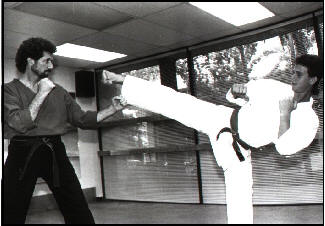
This month the Shiaii, in-school tournament is the highlighted event for the Dojo. Competition can be a great motivator for students of all ages. It is a specific arena in which the student can test his or her skills while performing, with their peers in front of an interested audience. The controlled conditions are governed by the rules of tournament competition to ensure safety and fair play. Even if a student is not especially interested in entering major competitions, attending a special tournament like the Shiaii can be fun, while providing useful Martial Arts experience It is a setting a little different from the usual class environment. Thus, all students from white belt to brown belt are encouraged to attend the Shiaii tournament seminar on March 17th.
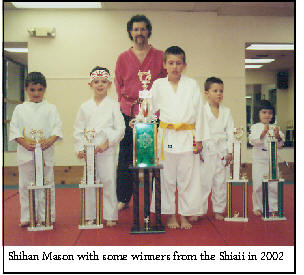
Mushin- The Art Of "No Mind"
I used to have a student that called Mushin – “Mushy Mind” but in reality it is all about being able to block out distractions and let your trained reflexes take over. The word breaks down into two words – “Mu” which means void and “Shin” means heart, mind and feeling. The “No Mind” translation stands for the altered state of consciousness that senior martial artist are able to achieve through proper training. It is in this state of mind that the senses become more aware and seem to work at an intuitive level. No longer slowed down by the thought process, incredible speed and reaction time occurs and is amazing to the average civilian.
By not being fixed to anything, then the mind becomes aware of everything. It is kind of like using peripheral vision at night. In the night sky, if you look to the side of a distant star you can see it, but if you look at it directly, it is hard to see. This works the same with the mind. By detaching yourself from conscious thought, you become more aware of everything around you.
Like the Tai Chi master who moves very slowly in practice but explodes with amazing speed in self defense, the warrior who has mastered the concept of ‘Mushin” will gain further clarity and intuition in things around them. This is important for the modern warrior in their quest for black belt excellence.
© 2007 Sensei Terry Bryan
The Tao of Kaizen
The Path of Constant and Never-ending Improvement
The true foundation of Kaizen or constant and never-ending improvement begins with precise and specific target selection. The successful warrior is very precise in words, action and deeds. Although success begins with precise and specific goal setting and action plans, that is just the beginning and it is the daily ability to implement specific actions that truly separates the successful person from the others.
As a beginner, it looks like an impossible task to master the skills that are required to earn the rank of black belt and yet it is achieved one step at a time as the students tries to learn and improve a few things at a time. There, under the watchful eyes of his Sensei, he slowly forms into a person deserving of a black belt ranking.
The modern warrior always knows where he is and where he is going at all times. Since we live in a rapidly changing world, our targets are constantly moving. A wise objective today may be a fool’s goal tomorrow so it is imperative that one re-evaluates on an ongoing basis. While a martial artist works on being able to generate extreme force on specific targets for maximum effect, it is the target selection process that is constantly changing as openings and opportunities present themselves and disappear on an ongoing and fluid basis. We quickly learn that perfect accuracy on the wrong target is a waste of skill and resources. The warrior constantly updates objectives and targets based on constantly changing information.
By being innovative and creative while seeing every challenge as an opportunity for achievement and a path for future growth the modern warrior is future thinking and never looks back. Living on the cutting edge of creativity, and using positive, active growth tactics bring his future to him as he has already determined it should be through proactive strategic planning and implementation.
© 2007 Sensei Terry Bryan
Committing to Growth
In choosing to study the Martial Arts, you have clearly set a goal for yourself; every time you go to class, practice your kicks, or read something new about the Martial Arts, you move toward your goal, form by form, belt by belt. The time that you devote to Martial Arts practice and study along with your interest in making Martial Arts principles a part of your lifestyle demonstrate the power of your Black Belt goals to set a proactive tone in your life. While setting goals can seem easy enough, achieving them can be tough. With a little vision; however, you can achieve any goal.
Be realistic. Lofty goals may or may not get you anywhere. Focus on what truly interests and inspires you. Focus on those areas that are within your control; think positively.
Break big goals down into manageable, measurable pieces. Once you decide on a goal, take a bird’s eye view of it. How are you going to get from here to the finish line? What needs to happen first? Second? Third? Write these steps down. These are your “short-term goals.”
Review goals regularly. Your attention and focus is called upon by so many things each day that it’s not hard to lose track of the essence of what you are trying to accomplish. Writing your goals gives you the option of reviewing and renewing your commitment as often as you need to. It also allows you to modify them as the need arises. Be flexible in your thinking. This doesn’t mean being wishy-washy. It does mean being tuned in to your own body, your sentiments, and your circumstances. Do you need to make changes in the way you are approaching your goal? In extreme cases, you may need to rethink your goal completely. Be honest with yourself.
Value the roots of your achievements. Even while you aspire to something greater, or simply different, recognize the special meaning of who you are and what you are doing right now. Even when you have earned your Black Belt, you won’t leave the person you were as a yellow belt behind; without the “Yellow Belt you”, the “Black Belt you” couldn’t have happened. While working toward your goals, take care of yourself. Take time to rest. Listen to your body. Spend time with people who support and love you.
Shihan Robert H. Mason © 2007
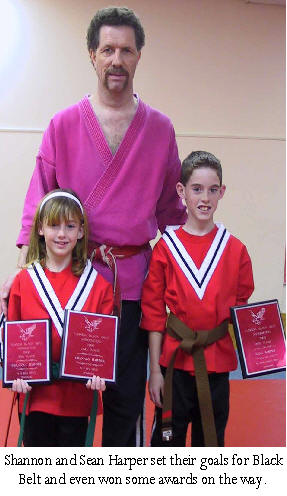
Karate Definition
Karate means the “art of empty hand”, and describes the technique of fighting with the body’s natural weapons. The ultimate aim of the art of Karate lies neither in victory nor defeat, but in the perfection of the character of its participants. The three main reasons why people train in Karate are for Self-Defense, Sport and Personal Growth. Over the course of the last twenty-seven years that Shihan Mason has been teaching in Plantation the Dojo has seen some students excel in tournaments. Several others have become experts at Self-Defense and gone on to train government agents and police officers. The majority, however, have been able to train for personal growth, improving their balance, coordination, flexibility and agility to stay in good physical shape, while simultaneously learning to balance their emotions, increase their awareness and challenge their perceptual and cognitive abilities.
In a dangerous world, increased awareness and self-defense skills are more important than ever. At the same time, martial arts offers many opportunities to positively impact our lives.
The Student Code
Live your life by the student code:
I intend to develop myself in a positive manner and avoid anything that could reduce my mental growth or my physical health.
I intend to use what I learn in class constructively and defensively, to help myself and others, and to avoid all behavior, verbal and physical, that is abusive or offensive.
Karate and Discipline
Sometimes adults (especially well-meaning parents) think it is fun to “play karate” with their children; however, the children do not understand what this means and they can not necessarily differentiate between appropriate and inappropriate karate behavior. All students are encouraged to practice at home, but it is important to observe our rules so that karate remains safe for everyone. Karate should be fun, but not silly. That is why at the karate school it is proper to practice techniques in the dojo but not in the reception area, which is for receiving people who are waiting to watch or take class. Practice is not play. Karate is not something that everyone has grown up with, so sometimes parents are not sure how to fit it into their family. If you want to structure your practice at home you can buy a DVD or video to help you train correctly.
Compassion as a Worthy Goal in Education
Some children and adults are spontaneously helpful. When we help others we benefit ourselves by deepening our own understanding. Sometimes we might selfishly think that being helpful is somehow costing us something; to the contrary, a helpful attitude is a powerful mechanism for our own personal growth.
The Dalai Lama has instituted a program to teach compassion to children by giving them the opportunity to help others. It is from this kind of practice that we can all continue to develop our own values, based upon experience rather than just on theory.
“Teaching young people about compassion is one of the most important things we can do for them, says the Dalai Lama, and for the future of humanity……educating the heart as well as the mind…”
In general there have been three goals (different models) of education: The Good Citizen, The Good Worker, or The Good Person.
The ideal of the good citizen goes back to the ancient Greeks, and it is the educational mode of many contemporary liberals, and also true conservatives. The goal is to form students into responsible, empowered, thoughtful citizens whose well-rounded education and good judgment will benefit society.
The good worker is the goal of the mass education of the industrial revolution, standardized schooling to create punctual, hard-working, obedient workers for capitalism’s factories, mines, and industry. A lot of public schooling today is still like this.
And finally, the good person, the student who is caring, compassionate, peaceful and tolerant. The student who sees all humanity as brothers and sisters. The student whose heart is as well-educated as their mind. This is the educational ideal of the Dalai Lama, as well as of Western educators pioneering the new field of social and emotional learning (SEL).
Here at the karate school I have set up the training to include personal growth and development, as I have observed that training only the body will simply produce physical ability, but will not address the emotional and intellectual aspects of an individual.
Karate is, in the best schools, an educational experience that will stay with the student for a lifetime. Many Black Belts believe that it is their most valuable, practical resource.
With that in mind, I have decided to make the Sempai Program voluntary, and leave it to the students to decide to make the commitment in order to realize its value (see side column). Students can benefit themselves by helping others learn how to practice and progress.
“Real change is in the heart, but in modern education there is not sufficient talk about compassion. Through education, through training the mind and using intelligence, we can see the value of compassion and the harmfulness of anger and hatred.” says the Dalai Lama.
“There is substantial evidence that this is doable,” said Mark Greenberg, an SEL pioneer at Penn State’s College of Health and Human Development. “Research has shown that we can successfully teach children how to overcome and manage emotions such as fear, hatred, anger and anxiety. SEL programs have proven that children can develop lifelong abilities such as self-awareness, anger management, and impulse control, and positive qualities such as empathy and compassion.”
The approach of the Dalai Lama reflects the Buddhist view that the “true nature” of all beings is basically good, including an inherent capacity for compassion. These good qualities are seeds we all possess, and these seeds need only be cultivated to bloom into the unbiased and universal compassion that heals the world. We can educate people in order to sustain and nurture compassion. Proper education is very important. His faith is in human intelligence reason, and self-interest, albeit a higher self-interest. We can learn to be more compassionate because it makes sense.
Children understand this intuitively; I was told recently by a parent that when they were summoned into the school for a Parent-Teacher Conference the teacher stressed the importance of the helpfulness that their child spontaneously exhibited in the classroom toward fellow students who were not as accomplished academically as this student.
We seek to foster this attitude of cooperation here at the karate school through the Sempai Program, which is a natural complement to the sometimes competitive nature of the Curriculum Program. To thrive in our modern world it is necessary to know how to successfully cooperate as well as compete. We seek to teach both.
Shihan Robert Heale Mason © 2006
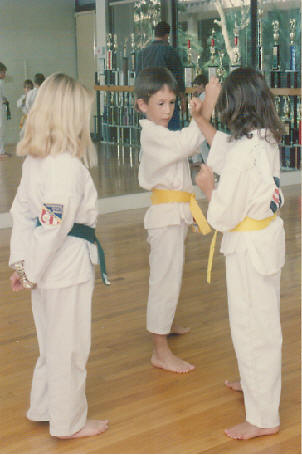
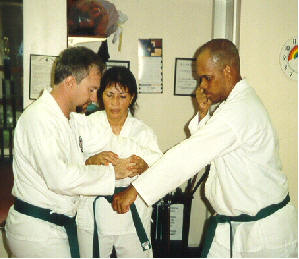
The Importance of Friends
Most likely you have heard it stressed that the Martial Arts is more than just a physical discipline; that it is a discipline that develops both the mind and body. The presence of mind that the Martial Arts demand helps us to make wise and thoughtful decisions. Often these decisions involve choosing others as friends—and all of us would like to choose friends well.
I heard a new item this week on TV where they reported some young men were shot by police during the commission of a crime. The grandmother of one of the youngsters who was killed commented that “he was not a bad boy, but he got in with a bad crowd”. We obviously want to make friends who are “good guys”.
It is sometimes very mysterious why we choose who we do as friends. Often we like a person right off the bat based on some intuitive thought or feeling. Other times we observe someone for a while with admiration, and build up to a formal introduction. Friendship is a wonderful thing, often beyond words, and is sometimes sparked by an almost electric power of attraction. This is what gives friendship such a strong and almost magical power to tie people together so closely. All the same, our first impressions can be mistaken. There is no way to be certain that everybody you choose as a friend will turn out to be a “good buddy”, but Martial Arts schools are a terrific place to meet new people. Many life-long friendships have begun in the Dojo. Here are some tips on how to choose friends that might be right for you:
Look for people who share the same basic values that you do. Karate teaches you certain values and principles that you should know to look for. Honesty, respect, self control, these are all good qualities that a lot of people share. Having friends with these qualities will make it a lot easier for you to feel relaxed and at ease when you are with them.
Look for people who respect your decisions. Your friends may have different tastes than you do, but they should respect your freedom of choice, just as you should respect theirs. Sometimes you may feel that a friend is not making a positive choice, or a friend may feel that you not making a positive choice. Discuss these issues. Nothing is more important to friendship than open communication and honesty.
Look for people that are team players. You know what that means: people who are willing to stick by you through thick and thin, will be there when you need them, and will show you the understanding that you in turn give back. A friend that you know you can depend on can be a friend for life! There will be times when you feel that a friend of yours is consistently making bad choices, or is not treating you with respect. The Martial Artist takes pride in understanding: try to see where your friend is coming from, and try to resolve any differences that you might have. Feel free to speak to your your instructors. They have the benefit of experience, and are always looking out for your best interests. There are very few things as precious as having good friends, and you should not let them go easily. Hold onto your friendships; let your friends know you value them and do your best to solve problems as quickly as they arise. Trust your instincts and follow your heart!
The Real Purpose of the Martial Arts
Learning How to be Humble
Being humbled, or some would say humiliated, is an experience that most people would avoid at all costs, or at least shy away from. However, in the training that is required of a martial artist humiliation, or public embarrassment, may be an occasional occurrence. How the student responds to this essential aspect of training will determine the quality of their martial arts experience.
The capacity to learn requires that the individual have an open attitude about what happens to them in class. If they are predisposed to judging incidents from a “civilian” point of view they will miss the “lesson” inherent in many martial arts interactions, whether inside or outside of the dojo. In order for martial arts training to have a “life changing” impact on the student, they must allow it to change their perspective as they progress with their training, which can be tough at times.
These challenges are most evident in sparring (strategy) class where the difference between ego and confidence is often blurred in the intensity of the moment. Nonetheless, it is very important for students to trust the process and to “...strive to concentrate only on the martial arts...and to leave behind any problems or animosities which could be counterproductive”. Sometimes students hit too hard and the natural reaction to that would be to hit back harder; yet, Mudokai students are expected to show self -control: the response required is different from their natural tendency to strike back.
Years ago I promoted a kickboxing match between Dennis “Mad Dog” Downey and Paul Ellis, in which Downey picked Ellis up and threw him over the ropes and out of the ring. Ellis calmly picked himself up, stepped carefully back into the ring, took a stance and proceeded to skillfully counter Downey’s next move, winning the match with his focused determination and superior skill. While Downey’s purpose may have been to intimidate Ellis through publicly humiliating him, Ellis chose instead to respond with integrity and technique, which won the match.
Shihan Robert H. Mason c2001
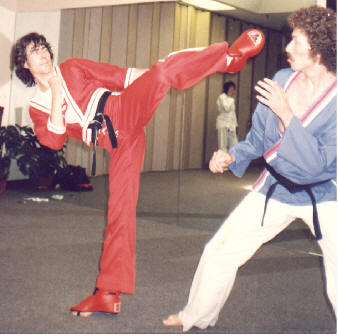
Shihan Mason spars with one of his Sensei, George Sfetas, in 1981.
Shihan Mason receives a throw during a demonstration with Kaison.
In Martial Arts it is important to acknowledge where we came from. Having the humility to go with the flow of movement is an important skill in Martial Arts and life.
Traveling, Training and Time
seeing the bigger picture
During my recent trip to England I trained very little in Martial Arts. In fact, I only trained a few hours towards the end of my visit, yet it struck me that, in many ways, traveling and training are similar. They both have the capacity to open up a person’s mind to the bigger picture, to something that is interesting and challenging, both engaging and stimulating.
Part of the reason why “travel broadens the mind” has to do with the novel situations that we experience as a part of being in new places and unfamiliar surroundings. The journey through the Martial Arts is similar. A student moves from rank to rank, achieving higher belts and being exposed, as a result, to new and more sophisticated concepts and principles. Just as traveling can make us feel uneasy and even fearful, so the challenge of learning new moves following a rank promotion can fill us with doubts and trepidation. To enjoy either kind of journey we need to put our fears aside and allow our excitement and eager anticipation of enjoyment carry us forward.
Just as a place we visit can become jaded and ordinary if we stay there for a long time, so the techniques we are seeking to master can become boring and tedious if we get stuck in a rank and lose our momentum and our aspiration to achieve the next level. This happens sometimes because we become comfortable at a particular rank or in a particular place, a bit like settling down somewhere we were only supposed to be visiting. As you journey through the Martial Arts ranks, don’t even think about settling down until you have achieved Black Belt. Even then it is helpful to engage a new level of excitement by taking advantage of the opportunities offered at the Black Belt level. Our path continues in new directions from the base we have established, perhaps through teaching or weapons training, and progresses to new levels of understanding through the Black Belt curriculum.
During October Sensei Alex Ramos became the youngest student ever to achieve the rank of Sandan (3rd Degree Black Belt). He had the advantage of beginning his training very young (actually before his third birthday), though it is true to say that the best time for anyone to begin Martial Arts training is the day a person takes their first lesson, be that at five or fifty-five years old. Sensei Ramos is so used to training now that his journey through the Martial Arts just keeps rolling along. It is a law of physics that “a body in motion tends to stay in motion”. Let’s keep our momentum going as we travel through our Martial Arts training over time. Achieving new heights, we come to see the bigger picture.
Shihan Robert H. Mason © 2006

The Schools within the School at UKC
Since we teach the Mugendo system at University Karate Center, we can consider that there are several schools within the school. Mugendo means ”unlimited way”, so that all martial arts principals are included in our training.
Mudokai Karate basics are taught daily and form the basis of our martial arts study. For adult students we offer “Funkicks” kickboxing classes three days a week. These classes are a useful introduction to martial arts for adults (14 and older) looking for a fun and intense workout, but who do not necessarily feel ready to begin martial arts training. They are also a great training tool for adult martial arts students looking to build up their cardio conditioning and hone their skills in the circuit training portion of the workout. The Friday morning Karate class is similar to the circuit training portion of the Funkicks class, except that the dress code is Karate pants with belt and a school tee shirt.
The Thursday night Adult Karate class has a focus on self defense applications, and allow more development of the students’ knowledge of Jiu Jutsu. Our Mudokai style draws on techniques from the Shindo Yoshin Ryu Aikijujutsu system. My Sensei’s Sensei, Professor Hironori Ohtsuka was the Grandmaster of this style, before he founded the Wado Ryu Karate style which combined Karate and Jiu Jutsu.
On Monday nights we offer Kobudo, practice in the art of Okinawan weapons for Adult Black Belt Club and Charter Members. Junior students who are members of the Black Belt Club have their own Kobudo classes on Thursdays.
For the more advanced Karate students, classes are offered weekly in Kata (Forms) and Strategy (Sparring). These classes allow junior and adult students to meet the criteria for promotion through the Karate ranks to Black Belt and beyond. They also offer a training regimen to prepare for martial arts tournaments, should that be within the student’s realm of interest.
Tai Chi Chuan is available on Sundays to adult students and children 10 and older training with a parent. Sensei Stamp teaches the Wu style of Tai Chi for students at the beginning and advanced levels.
Our goal at the Karate Institute is to train martial artists who can cope with attacks utilizing all three major martial arts principals:
Striking, which includes all punches, kicks, blocks and strikes.
Taking the foundation, which includes all sweeps, throws, takedowns, projections, kickthroughs, kneeldowns and stepdowns.
Taking a limb, which includes all arm, wrist and finger locks, leg, ankle and toe locks, neck and head locks and grappling techniques.
We have it all available for you, your friends and family. As you train and benefit from our program we hope you will take the opportunity to recommend University Karate Center to those who might be interested in our broad and thorough curriculum.
Shihan Robert H Mason, Chief Instructor (c) 2006
A Word from the Wise
The best athlete wants his opponent at his best.
The best general enters the mind of his enemy.
The best businessman serves the communal good.
The best leader follows the will of the people.
All of them embody the virtue of non-competition.
Not that they don’t love to compete,
but they do it in the spirit of play.
In this they are like children and in harmony with the Way.
Lao Tzu
The connection between the brain and the body
A “deskless School” was featured on CNN June 25th and detailed how students may learn better by being able to choose how to best position themselves to learn, such as standing up instead of sitting down at desks to do their work in school. In the future, according to Dr. James Levine at the Mayo Clinic, students will be able to choose their best position by picking their preference from alternate “furniture” located in a huge space. This model is currently under development in Minnesota. “Learning is supposed to be fun” says Levine, and “this flexible space can be turned into a community center at night. The setup takes only 15 minutes to put together and can transform any space into a learning corner.”
Top executives frequently have basketball nets and such in their office; it makes sense to combine the physical with the mental, as they are so closely connected. Our philosophy at the Dojo is to stimulate consciousness and awareness primarily through physical activity. Jean Piaget, famous for his contributions to Developmental Psychology, was the first to realize that all concept development begins physically on a sensory-motor level. Even the most sophisticated abstract concepts can only develop as a consequence of earlier appropriate sensory-motor practice.
Glenn Doman, the internationally famous pioneer of “The Institutes for the Development of Human Potential”, realized long ago that brain-damaged children could often be led to a full recovery if natural reflexes were appropriately stimulated to encourage the next necessary steps in development. One day, while listening to a severely brain damaged five year old boy reading to him on a high school level, he asked himself the question, “what is the matter with normal kids who cannot read”. He went on to modify his techniques, which were developed to teach brain-damaged children, to enable him to teach normal babies (aged 6 months -3 years) math and reading. I used his methods when teaching my daughter and have planned an Introductory Seminar for October 14th to introduce parents to Glenn Doman’s work.
F.M. Alexander created his technique for the attainment of poise following research on his own voice. The “Alexander Method” has since been expanded to utilize reflexive movement to retrain the body to accomplish all manner of physical skills, while maintaining a state of relaxed poise. The tendency, Alexander noticed, was for students to “muscle up” prior to moving, often in a way that made smooth natural movement impossible. His training method allowed his students to learn to extend into what they were doing, regardless of what the action entailed, rather than contracting into their movements. All movements in the MuDoKai curriculum are to be taught and practiced using the “Alexander Principle”.
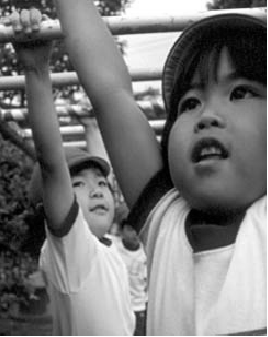
Glenn Doman teaches brachiating and other physical activities to encourage development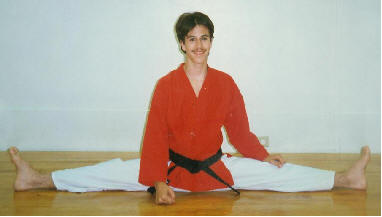
Each MuDoKai Class begins with a brief Yoga style stretch
Centuries ago Yoga systems were developed in India to assist in the achievement of personal growth and the development of human potential. While great Gurus (Yoga teachers) sought to lead their students to spiritual enlightenment, they realized that a physical foundation was essential. Hatha Yoga systems, like the Kripalu Flow Yoga that is offered for adults on Tuesday nights at the Dojo (children 10-13 years old may attend with a parent), are examples of this essential physical training.
In our rush to conform with the traditions of the state mandated “educational” program, offered in our public schools, like homework and FCAT coaching, it is easy to lose sight of the importance of developing our children's thinking skills. Stimulating a youngster’s neurology, through participation in programs like MuDoKai, that involve sensory-motor training in reflexive movement, with increasing skill sets developed over time that lead to the development of new conceptual thinking skills, are a practical way to promote the essential growth of their thinking abilities. Our program is excellent for adults as well. After all, we are never too old to learn.
© 2006 Shihan Robert H. Mason
Martial Arts Motivation
Studying Martial Arts is one of the most challenging and rewarding pursuits that you will ever encounter. Martial Arts proficiency requires many hours of hard work spent practicing form and technique; however, as you progress through the ranks, you will achieve a satisfaction that makes all of your hard work and dedication worth while.
At times, as we undertake tasks associated with our many pursuits, we might begin to feel discouraged. We need to step back and assess our situations so that we can find something that will help us remain motivated and better able to reach the great peaks of success.
Here are some mental steps that you can take:
1. Maintain a Positive Outlook
A positive outlook can greatly increase motivation and will help you to stick with your endeavors to their completion. Instead of focusing on setbacks try to consider the many benefits that you will gain with a “can do” attitude.
2. Keep your “Eye on the Prize”
Few things inspire as much as really great reward. Set a realistic goal for yourself (such as your next belt level) and work toward that goal. If your goals are realistic and attainable within a reasonable amount of time, they will better help to motivate you than unrealistic or distant goals.
3. Look at the big picture
While you are working each day to learn a new set of movements or forms, remember that MuDoKai is a system that cannot work without each of its component parts. Each time you learn something new, try to see how it fits into the big picture.
4. Keep things in perspective
Maintaining perspective will greatly assist you in all of your endeavors. A small set back is not the end of the world. Remember that you are only limited by your own perceptions of reality. Inch by inch, it’s a cinch, but yard by yard it’s hard.
5. Stay self-disciplined
One great way to stay motivated is to attend class regularly and participate fully in class activities. This will lead to an increased rate of learning and give you the tools that you will need for Martial Arts success.
Staying motivated is one of the keys to success in the Martial Arts and in your life. If you approach each of life’s endeavors with a high level of motivation and commitment, you are sure to succeed.
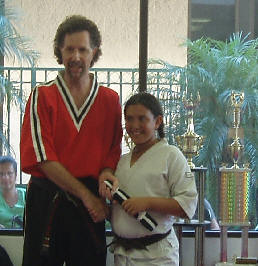
Eleven year old Liron recently became our youngest ever Black Belt
The Written Curriculum Now on DVD
Most other Martial arts schools have a rather abstract and ineffective program of practice. While they may require correctness in forms or self-defense moves, their lack of curriculum leads to one of the two big problems that I have noticed over the years.
Problem #1 is the Sensei who teaches all of his students everything at every rank and then requires them too get better at the same material for their next promotion. Most green belts you meet from this kind of Dojo have been training between 5-7 years, and although they often can exhibit a high level of skill, they do not have a way to define what they know, or to help others to learn it. They are in a sense victims of the unstructured curriculum. If they eventually achieve Black Belt recognition, they will tend to go on as teachers in the same unstructured way that they were taught.
Problem #2 is the Sensei who teaches a few simple moves and a form for each rank and sets his student on a two year schedule to Black Belt. Everyone knows when they will be promoted because the schedule is quite simple. Thirty classes are required to learn the material for the rank, dues must be paid up to date and you must refer one new student to the Dojo to meet the criteria for belt promotion. This method allows everyone to learn “about” all of the moves required for each rank, though of course, this kind of scheduling would not require them to meet any particular standard of performance.
The curriculum at our Dojo is based on the idea that there is an easy way to learn things. That method involves starting out with the practice of movement, using karate techniques, that we learn to copy from an instructor. As students follow along with the class they automatically learn correct posture, poise, balance and skeletal alignment. They also learn to develop muscle memory, balance coordination and self control, as those principles relate to specific movements they are practicing for their rank. With promotion to a new rank the process begins over again, only on a higher level each time, because of the progress made at the previous rank. Because we teach our basics, partner moves and forms (Kata) as specific skill techniques, and require the students to practice them the same way every time, students come to the point where they can demonstrate their moves almost without thinking about it. That is usually the signal that they are ready for promotion to the next rank and a new set of challenges.
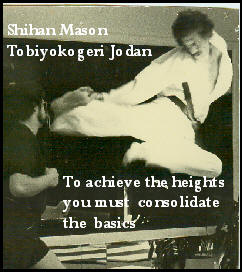
My solution to these two problems involves teaching a structured, written curriculum, taking students through more and more advanced techniques at each rank using red stripes to show improvement, thus preparing each student to progress at their own speed. They have to learn all their techniques to a standard, but everything is able to be individualized to make progress achievable. The result is that most of my students are able to reach Black Belt in four to six years, and demonstrate a degree of proficiency worthy of the Black Belt rank. Occasionally I have the opportunity to train students who had the benefit of many years of training at another school. I have had a lot of success training students of this kind. Skyler Gould transferred to our Dojo as a brown belt and is doing exceptionally well in her progress towards Black Belt. Sensei Alex Ramos and his two older brothers were all Black Belts in Shotokan when they started their training with me. Mr. Ramos is now about to grade for his 3rd Dan having trained for about 14 years all together.
One of the great advantages to a written curriculum is that when you look back over what you have learned you can see what you know. This is often a tremendous boost once you achieve Black Belt because you have a structured perspective, making it much easier for you to pass on your skills and insights to others through becoming a teacher yourself. The curriculum gives you a ready-made lesson plan for students of every rank in every class, each according to his ability and experience.
Until last year my Black Belt curriculum fell into the category of the previously mentioned “Problem #1”. It was too vague, too advanced at every stage and required too much memorization to allow students to progress. Speaking to a colleague of mine whose own “underbelt” curriculum suffers from problem #2, led me to rethink my own situation. The new curriculum for Black Belts now allows me to teach appropriately advanced materials in a structured way to challenge my students at each Dan (Black Belt) rank. It requires them to demonstrate a high level of skill, without swamping them with too many techniques. Better, I decided, that they be twice as good at half as much.
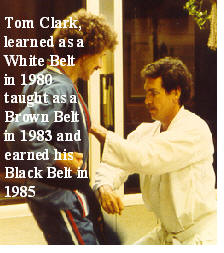
My current project is to commit all of this knowledge to DVD so that students of all ranks may have a home study guide that will allow them to learn and practice the entire curriculum, with a full explanation from me in regard to all of the moves, pairs and forms. Students who choose to take advantage of the DVDs will find themselves more able than ever to make the most of their time in class to work out on moves that they already understand in theory. It has always been my opinion that students need to have every opportunity to practice. That is why, from the very beginning of the Dojo, I have always arranged for senior students, usually Black Belts, to lead classes even at times that I cannot be present to teach myself. Of course, the benefit of this is not only the main body of students who get these extra opportunities to work out, and be corrected where necessary by a Sensei (one who has gone before), but also gives these Sensei a chance to approach the curriculum from a different angle themselves; that of the teacher. While it is inevitable that sometimes mistakes will be made or other upsets occur, overall it has worked to everyone's advantage for many years. Presently we are fortunate that most of the Sensei teaching are ranked from 2nd Degree Black Belt and up. When I first opened the Dojo two of my main instructors were just Brown Belt students. Even now, from time to time I have excellent Brown Belt students who help with classes as Sempai.
Currently DVDs are available for ranks White Belt through 1st Kyu Brown Belt. More to follow soon. Ask at the Front Desk for prices.
Shihan Robert H. Mason © 2006